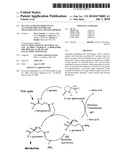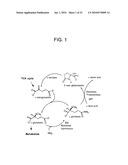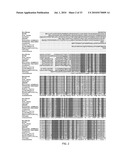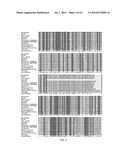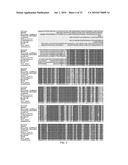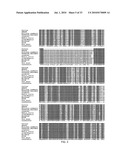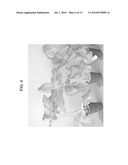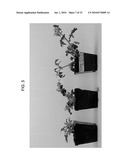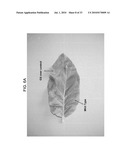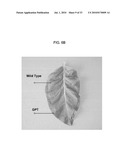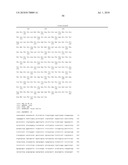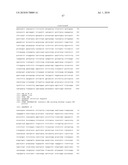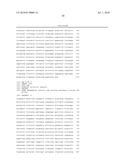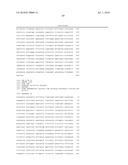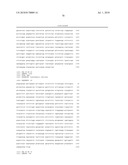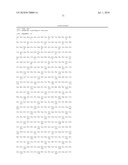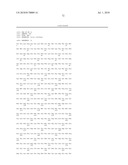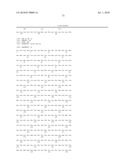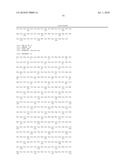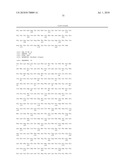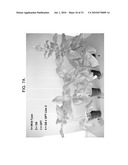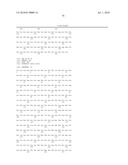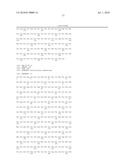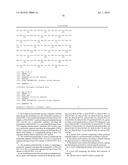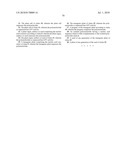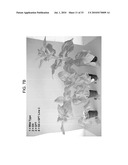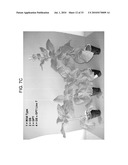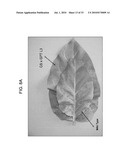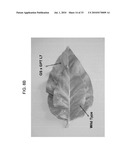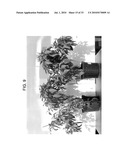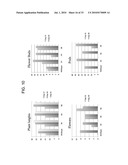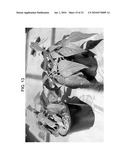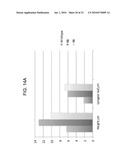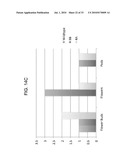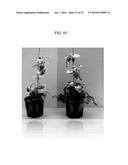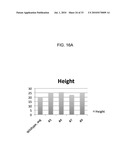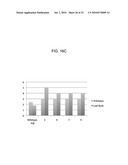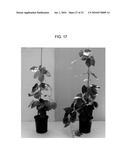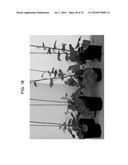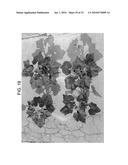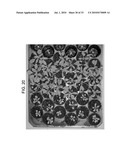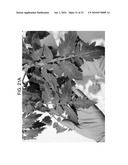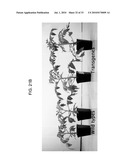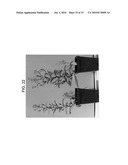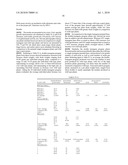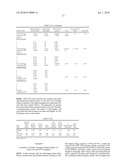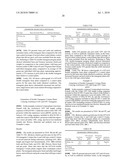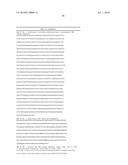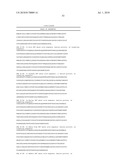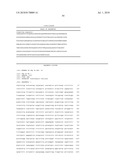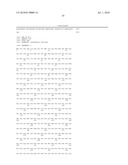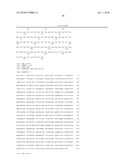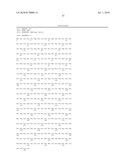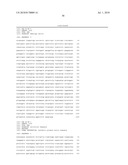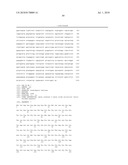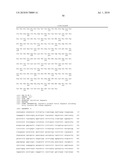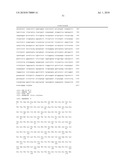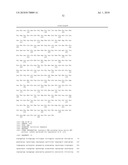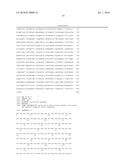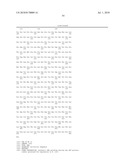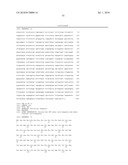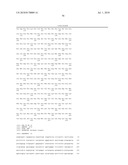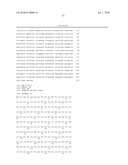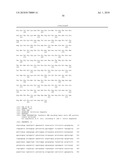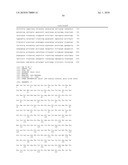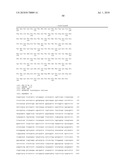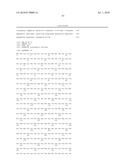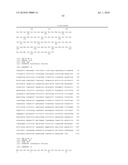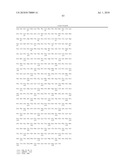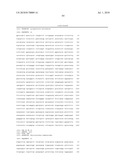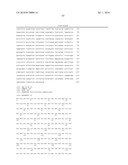Patent application title: Nucleic acids encoding plant glutamine phenylpyruvate transaminase (GPT) and uses thereof
Inventors:
Pat J. Unkefer (Los Alamos, NM, US)
Pat J. Unkefer (Los Alamos, NM, US)
Penelope S. Anderson (Los Alamos, NM, US)
Penelope S. Anderson (Los Alamos, NM, US)
Thomas J. Knight (Raymond, ME, US)
Thomas J. Knight (Raymond, ME, US)
Assignees:
Los Alamos National Security, LLC
IPC8 Class: AA01H500FI
USPC Class:
800298
Class name: Multicellular living organisms and unmodified parts thereof and related processes plant, seedling, plant seed, or plant part, per se higher plant, seedling, plant seed, or plant part (i.e., angiosperms or gymnosperms)
Publication date: 2010-07-01
Patent application number: 20100170009
Claims:
1. An isolated polynucleotide having a sequence selected from the group
consisting of (a) the nucleotide sequence of SEQ ID NO: 1; (b) a
nucleotide sequence having at least 75% identity to SEQ ID NO: 1, and
encoding a polypeptide having GPT activity; (c) a nucleotide sequence
encoding the polypeptide of SEQ ID NO: 2, or a polypeptide having at
least 75% sequence identity thereto which has GPT activity; and, (d) a
nucleotide sequence encoding the polypeptide of SEQ ID NO: 2 truncated at
its amino terminus by between 30 to 56 amino acid residues, or a
polypeptide having at least 75% sequence identity thereto which has GPT
activity.
2. The isolated polynucleotide of claim 1 comprising the nucleotide sequence of SEQ ID NO: 18 or 29, or a nucleotide sequence having at least 75% identity to SEQ ID NO: 18 or 29.
3. The isolated polynucleotide of claim 1 comprising a nucleotide sequence encoding the polypeptide of SEQ ID NO: 19 or 30, or a nucleotide sequence having at least 75% identity to SEQ ID NO: 19 or 30.
4. An isolated polynucleotide encoding a polypeptide having an amino acid sequence selected from the group consisting of (a) SEQ ID NO: 2; SEQ ID NO: 9; SEQ ID NO: 15, SEQ ID NO: 19, SEQ ID NO: 21, SEQ ID NO 24, SEQ ID NO: 30, SEQ ID NO:31, SEQ ID NO: 32, SEQ ID NO: 33, SEQ ID NO: 34, SEQ ID NO: 35 and SEQ ID NO: 36, and (b) an amino acid sequence that is at least 75% identical to any one of SEQ ID NO: 2; SEQ ID NO: 9; SEQ ID NO: 15, SEQ ID NO: 19, SEQ ID NO: 21, SEQ ID NO 24, SEQ ID NO: 30, SEQ ID NO:31, SEQ ID NO: 32, SEQ ID NO: 33, SEQ ID NO: 34, SEQ ID NO: 35 and SEQ ID NO: 36 and has GPT activity.
5. A nucleic acid construct comprising a plant promoter operably linked to a polynucleotide according to claim 4.
6. The nucleic acid construct according to claim 5, wherein the plant promoter is a heterologous promoter.
7. The nucleic acid construct according to claim 6, wherein the heterologous promoter is a tissue-specific promoter.
8. A vector comprising the nucleic acid construct of claim 5.
9. A host cell comprising the nucleic acid construct of claim 5.
10. The host cell of claim 9, which is a plant cell.
11. The plant cell of claim 10, wherein the plant cell expresses the polynucleotide.
12. The plant cell of claim 11, wherein the polynucleotide so expressed has GPT activity.
13. A plant organ, embryo or seed comprising the nucleic acid construct according to claim 5, wherein the plant organ, embryo or seed expresses the polynucleotide.
14. The plant organ, embryo or seed of claim 13, wherein the polynucleotide so expressed has GPT activity.
15. A transgenic plant comprising the nucleic acid construct of claim 5, wherein the transgenic plant expresses the polynucleotide.
16. The transgenic plant of claim 15, wherein the polynucleotide so expressed has GPT activity.
17. A progeny of the transgenic plant according to claim 15, wherein the progeny comprises the polynucleotide.
18. An isolated polynucleotide having a nucleic acid sequence which is fully complementary to the isolated polynucleotide claim 4.
19. A seed of any generation of the transgenic plant of claim 15.
20. A plant of any generation of the seed of claim 19.
Description:
RELATED APPLICATIONS
[0001]This application claims priority to U.S. Provisional Application Nos. 61/190,520 and 61/190,581, both filed on Aug. 29, 2008.
BACKGROUND OF THE INVENTION
[0003]The metabolism of carbon and nitrogen in photosynthetic organisms must be regulated in a coordinated manner to assure efficient use of plant resources and energy. Current understanding of carbon and nitrogen metabolism includes details of certain steps and metabolic pathways which are subsystems of larger systems. In photosynthetic organisms, carbon metabolism begins with CO2 fixation, which proceeds via two major processes, termed C-3 and C-4 metabolism. In plants with C-3 metabolism, the enzyme ribulose bisphosphate carboxylase (RuBisCo) catalyzes the combination of CO2 with ribulose bisphosphate to produce 3-phosphoglycerate, a three carbon compound (C-3) that the plant uses to synthesize carbon-containing compounds. In plants with C-4 metabolism, CO2 is combined with phosphoenol pyruvate to form acids containing four carbons (C-4), in a reaction catalyzed by the enzyme phosphoenol pyruvate carboxylase. The acids are transferred to bundle sheath cells, where they are decarboxylated to release CO2, which is then combined with ribulose bisphosphate in the same reaction employed by C-3 plants.
[0004]Numerous studies have found that various metabolites are important in plant regulation of nitrogen metabolism. These compounds include the organic acid malate and the amino acids glutamate and glutamine. Nitrogen is assimilated by photosynthetic organisms via the action of the enzyme glutamine synthetase (GS) which catalyzes the combination of ammonia with glutamate to form glutamine. GS plays a key role in the assimilation of nitrogen in plants by catalyzing the addition of ammonium to glutamate to form glutamine in an ATP-dependent reaction (Miflin and Habash, 2002, Journal of Experimental Botany, Vol. 53, No. 370, pp. 979-987). GS also reassimilates ammonia released as a result of photorespiration and the breakdown of proteins and nitrogen transport compounds. GS enzymes may be divided into two general classes, one representing the cytoplasmic form (GS1) and the other representing the plastidic (i.e., chloroplastic) form (GS2).
[0005]Previous work has demonstrated that increased expression levels of GS1 result in increased levels of GS activity and plant growth, although reports are inconsistent. For example, Fuentes et al. reported that CaMV S35 promoter-driven overexpression of Alfalfa GS1 (cytoplasmic form) in tobacco resulted in increased levels of GS expression and GS activity in leaf tissue, increased growth under nitrogen starvation, but no effect on growth under optimal nitrogen fertilization conditions (Fuentes et al., 2001, J. Exp. Botany 52: 1071-81). Temple et al. reported that transgenic tobacco plants overexpressing the full length Alfalfa GS1 coding sequence contained greatly elevated levels of GS transcript, and GS polypeptide which assembled into active enzyme, but did not report phenotypic effects on growth (Temple et al., 1993, Molecular and General Genetics 236: 315-325). Corruzi et al. have reported that transgenic tobacco overexpressing a pea cytosolic GS1 transgene under the control of the CaMV S35 promoter show increased GS activity, increased cytosolic GS protein, and improved growth characteristics (U.S. Pat. No. 6,107,547). Unkefer et al. have more recently reported that transgenic tobacco plants overexpressing the Alfalfa GS1 in foliar tissues, which had been screened for increased leaf-to-root GS activity following genetic segregation by selfing to achieve increased GS1 transgene copy number, were found to produce increased 2-hydroxy-5-oxoproline levels in their foliar portions, which was found to lead to markedly increased growth rates over wildtype tobacco plants (see, U.S. Pat. Nos. 6,555,500; 6,593,275; and 6,831,040).
[0006]Unkefer et al. have further described the use of 2-hydroxy-5-oxoproline (also known and referred to herein as 2-oxoglutaramate) to improve plant growth (U.S. Pat. Nos. 6,555,500; 6,593,275; 6,831,040). In particular, Unkefer et al. disclose that increased concentrations of 2-hydroxy-5-oxoproline in foliar tissues (relative to root tissues) triggers a cascade of events that result in increased plant growth characteristics. Unkefer et al. describe methods by which the foliar concentration of 2-hydroxy-5-oxoproline may be increased in order to trigger increased plant growth characteristics, specifically, by applying a solution of 2-hydroxy-5-oxoproline directly to the foliar portions of the plant and over-expressing glutamine synthetase preferentially in leaf tissues.
[0007]A number of transaminase and hydrolyase enzymes known to be involved in the synthesis of 2-hydroxy-5-oxoproline in animals have been identified in animal liver and kidney tissues (Cooper and Meister, 1977, CRC Critical Reviews in Biochemistry, pages 281-303; Meister, 1952, J. Biochem. 197: 304).
[0008]In plants, the biochemical synthesis of 2-hydroxy-5-oxoproline has been known but has been poorly characterized. Moreover, the function of 2-hydroxy-5-oxoproline in plants and the significance of its pool size (tissue concentration) are unknown. Finally, the art provides no specific guidance as to precisely what transaminase(s) or hydrolase(s) may exist and/or be active in catalyzing the synthesis of 2-hydroxy-5-oxoproline in plants, and no such plant transaminases have been reported, isolated or characterized, until the present invention.
SUMMARY OF THE INVENTION
[0009]The present invention discloses for the first time that plants contain a glutamine phenylpyruvate transaminase enzyme which is directly functional in the synthesis of the signal metabolite 2-hydroxy-5-oxoproline, and provides the protein and gene coding sequences for a number of plant GPTs as well as a highly structurally-related non-plant GPT. The invention further provides strong evidence that plant GPTs are highly conserved and are involved in directly catalyzing 2-oxoglutaramate synthesis. Until now, no plant glutamine phenylpyruvate transaminase with a defined function has been described.
[0010]The invention relates to plant glutamine phenylpyruvate transaminase (GPT) proteins, nucleic acid molecules encoding GPT proteins, and uses thereof. Defined herein are various GPT proteins and GPT gene coding sequences isolated from a number of plant species. As disclosed herein, GPT proteins share remarkable structural similarity within plant species, and are active in catalyzing the synthesis of 2-hydroxy-5-oxoproline (2-oxoglutaramate), a powerful signal metabolite which regulates the function of a large number of genes involved in the photosynthesis apparatus, carbon fixation and nitrogen metabolism.
[0011]In one aspect, the invention provides isolated nucleic acid molecules encoding GPT. Exemplary GPT polynucleotides and GPT polypeptides are provided herein. In one embodiment, the invention provides an isolated GPT polynucleotide having a sequence selected from the group consisting of (a) the nucleotide sequence of SEQ ID NO: 1; (b) a nucleotide sequence having at least 75% identity to SEQ ID NO: 1, and encoding a polypeptide having GPT activity; (c) a nucleotide sequence encoding the polypeptide of SEQ ID NO: 2, or a polypeptide having at least 75% sequence identity thereto which has GPT activity; and, (d) a nucleotide sequence encoding the polypeptide of SEQ ID NO: 2 truncated at its amino terminus by between 30 to 56 amino acid residues, or a polypeptide having at least 75% sequence identity thereto which has GPT activity. In specific embodiments, the isolated GPT polynucleotide comprises the nucleotide sequence of SEQ ID NO: 18 or SEQ ID NO: 29, or a nucleotide sequence having at least 75% identity to SEQ ID NO: 18 or SEQ ID NO: 29, or comprises a nucleotide sequence encoding the polypeptide of SEQ ID NO: 19 or 30, or a nucleotide sequence having at least 75% identity to SEQ ID NO: 19 or 30.
[0012]In another embodiment, the invention provides an isolated GPT polynucleotide encoding a polypeptide having an amino acid sequence selected from the group consisting of (a) SEQ ID NO: 29, SEQ ID NO: 30, SEQ ID NO: 31, SEQ ID NO: 32, SEQ ID NO: 33, SEQ ID NO: 34, SEQ ID NO: 35 and SEQ ID NO: 36, and (b) an amino acid sequence that is at least 75% identical to any one of SEQ ID NO: 29, SEQ ID NO: 30, SEQ ID NO:31, SEQ ID NO: 32, SEQ ID NO: 33, SEQ ID NO: 34, SEQ ID NO: 35 and SEQ ID NO: 36 and has GPT activity.
[0013]In another aspects, the invention provides a nucleic acid construct comprising a plant promoter operably linked to a GPT polynucleotide. In one embodiment, the plant promoter is a heterologous promoter. In another embodiment, the plant promoter is a heterologous tissue-specific promoter. Related aspects include a vector comprising such a nucleic acid construct, and a host cell comprising such a vector or nucleic acid construct. In one embodiment, the host cell is a plant cell. In another embodiment, the host cell is a plant cell which expresses the GPT polynucleotide. In yet another embodiment, the host cell is a plant cell which expresses the GPT polynucleotide, wherein polynucleotide so expressed has GPT activity. The invention further provides a plant organ, embryo or seed comprising such a nucleic acid construct or vector, wherein the plant organ, embryo or seed expresses the GPT polynucleotide. In one embodiment, the GPT polynucleotide expressed has GPT activity. In another aspect, the invention provides a transgenic plant comprising such a nucleic acid construct or vector, wherein the transgenic plant expresses the polynucleotide, which in one embodiment has GPT activity. Progeny and seed of such a transgenic plant, wherein the progeny or seed comprises the GPT polynucleotide, are also provided.
BRIEF DESCRIPTION OF THE DRAWINGS
[0014]The patent or application file contains at least one drawing executed in color. Copies of this patent or patent application publication with color drawing(s) will be provided by the Office upon request and payment of the necessary fee.
[0015]FIG. 1. Nitrogen assimilation and 2-oxoglutaramate biosynthesis: schematic of metabolic pathway.
[0016]FIG. 2. Multiple sequence alignment of the amino acid sequences of several putative plant, algal and animal GPT proteins, showing a high degree of structural identity and conservation (green shading indicates amino acid residues which are identical in all sequences aligned, and yellow shading indicates amino acids that are identical in all but one or two sequences aligned). This alignment compares (in order from top to bottom in each block) the plant GPTs from barley (Hordeum vulgare), rice (Orzya sativa), corn (Zea mays), cotton (Gossypium hirsutum), grape (Vitis vinifera), castor oil plant (Ricinus communis), California poplar (Populus trichocarpa), soybean (Glycine max), Zebra fish (Danio rerio), arabidopsis (Arabidopsis thaliana), a Bryophyte moss (Physcomitrella patens), and a green algae (Chlamydomonas sp.). The alignment includes the presumed amino-terminal targeting sequence, if known.
[0017]FIG. 3. Subset of the multiple sequence alignment of the of FIG. 2, showing a very high degree of structural identity and conservation (green shading indicates amino acid residues which are identical in all sequences aligned, and yellow shading indicates amino acids that are identical in all but one or two sequences aligned). This alignment includes all sequences aligned and displayed in FIG. 2, except the Physcomitrella and Chlamydomonas sequences. As will be appreciated, relative to the alignment of FIG. 2, a substantial increase in amino acid sequence identity was achieved by eliminating those two sequences, as can be seen by the increase in the number of identical residues among the ten GPT sequences aligned in this figure, nine of which are plant GPTs, and interestingly, the remaining sequence being from Zebra fish.
[0018]FIG. 4. Photograph showing comparison of transgenic tobacco plants over-expressing either GS1 or GPT, compared to wild type tobacco plant. From left to right: wild type plant, Alfalfa GS1 transgene, Arabidopsis GPT transgene. See Examples 3 and 5, infra.
[0019]FIG. 5. Photograph showing comparison of transgenic Micro-Tom tomato plants over-expressing either GS1 or GPT, compared to wild type tomato plant. From left to right: wild type plant, Alfalfa GS1 transgene, Arabidopsis GPT transgene. See Examples 4 and 6, infra.
[0020]FIG. 6. Photographs showing comparisons of leaf sizes between wild type and GS1 or GPT transgenic tobacco plants. A: Comparison between leaves from GS1 transgenic tobacco (bottom leaf) and wild type (top leaf). B: Comparison between leaves from GPT transgenic tobacco (bottom leaf) and wild type (top leaf).
[0021]FIG. 7. Photographs showing comparisons of transgenic tobacco plants generated from various crosses between GS1 and GPT transgenic tobacco lines with wild type and single transgene plants. A-C: Cross 2, 3 and 7, respectively. See Example 7, infra.
[0022]FIG. 8. Photographs showing comparisons of leaf sizes between wild type and crosses between GS1 and GPT transgenic tobacco plants. A: Comparison between leaves from GSXGPT Cross 3 (bottom leaf) and wild type (top leaf). B: Comparison between leaves from GSXGPT Cross 7 (bottom leaf) and wild type (top leaf). See Example 7, infra.
[0023]FIG. 9. Photograph of transgenic pepper plant (right) and wild type control pepper plant (left), showing larger pepper fruit yield in the transgenic plant relative to the wild type control plant. See Example 8, infra.
[0024]FIG. 10. Transgenic bean plants compared to wild type control bean plants (several transgenic lines expressing Arabidopsis GPT and GS transgenes). Upper Left: plant heights on various days; Upper right: flower bud numbers; Lower left: flower numbers; Lower right: bean pod numbers. Wildtype is the control, and lines 2A, 4A and 5B are all transgenic plant lines. See Example 9, infra.
[0025]FIG. 11. Photograph of transgenic bean plant (right) and wild type control bean plant (left), showing increased growth in the transgenic plant relative to the wild type control plant. Transgenic line expressing Arabidopsis GPT and GS transgenes. See Example 9, infra.
[0026]FIG. 12. Transgenic bean plants pods, flowers and flower buds compared to wild type control bean plants (transgenic line expressing grape GPT and Arabidopsis GS transgenes). See Example 10, infra.
[0027]FIG. 13. Photograph of transgenic bean plant (right) and wild type control bean plant (left), showing increased growth in the transgenic plant relative to the wild type control plant. Transgenic line expressing Grape GPT and Arabidopsis GS transgenes. See Example 10, infra.
[0028]FIG. 14. Transgenic Cowpea Line A plants compared to wild type control Cowpea plants (transgenic line expressing Arabidopsis GPT and GS transgenes), showing that the transgenic plants grow faster and flower and set pods sooner than wild type control plants. (A) Relative height and longest leaf measurements as of May 21, (B) Relative trifolate leafs and flower buds as of June 18, (C) Relative numbers of flowers, flower buds and pea pods as of June 22. See Example 11, infra.
[0029]FIG. 15. Photograph of transgenic Cowpea Line A plant (right) and wild type control Cowpea plant (left), showing increased growth in the transgenic plant relative to the wild type control plant. Transgenic line expressing Arabidopsis GPT and GS transgenes. See Example 11, infra.
[0030]FIG. 16. Transgenic Cowpea Line G plants compared to wild type control Cowpea plants (transgenic line expressing Grape GPT and Arabidopsis GS transgenes), showing that the transgenic plants grow faster and flower and set pods sooner than wild type control plants. (A) plant heights, (B) flowers and pea pod numbers, (C) leaf bud and trifolate numbers. See Example 12, infra.
[0031]FIG. 17. Photograph of transgenic Cowpea Line G plant (right) and wild type control Cowpea plant (left), showing increased growth in the transgenic plant relative to the wild type control plant. Transgenic line expressing Grape GPT and Arabidopsis GS transgenes. See Example 12, infra.
[0032]FIG. 18. Photograph of transgenic Cantaloupe plant (right) and wild type control Cantaloupe plant (left), showing increased growth in the transgenic plant relative to the wild type control plant. Transgenic line expressing Arabidopsis GPT and GS transgenes. See Example 14, infra.
[0033]FIG. 19. Photograph of transgenic Pumpkin plants (right) and wild type control Pumpkin plants (left), showing increased growth in the transgenic plants relative to the wild type control plants. Transgenic lines expressing Arabidopsis GPT and GS transgenes. See Example 15, infra.
[0034]FIG. 20. Photograph of transgenic Arabidopsis plants (right) and wild type control Arabidopsis plants (left), showing increased growth in the transgenic plants relative to the wild type control plants. Transgenic lines expressing Arabidopsis GPT and GS transgenes. See Example 16, infra.
[0035]FIG. 21. Transgenic tomato plants expressing Arabidopsis GPT and GS transgenes compared to control tomato plants. (A) Photograph of transgenic tomato plant leaves (right) vs. wild type control leaves (left) showing larger leaves in the transgenic plant. (B) Photograph of transgenic tomato plants (right) and wild type control plants (left), showing increased growth in the transgenic plants relative to the wild type control plants. See Example 17, infra.
[0036]FIG. 22. Photograph of transgenic Camelina plant (right) and wild type control Camelina plant (left), showing increased growth in the transgenic plant relative to the wild type control plant. Transgenic line expressing Arabidopsis GPT and GS transgenes. See Example 18, infra.
DETAILED DESCRIPTION OF THE INVENTION
Definitions
[0037]Unless otherwise defined, all terms of art, notations and other scientific terminology used herein are intended to have the meanings commonly understood by those of skill in the art to which this invention pertains. In some cases, terms with commonly understood meanings are defined herein for clarity and/or for ready reference, and the inclusion of such definitions herein should not necessarily be construed to represent a substantial difference over what is generally understood in the art. The techniques and procedures described or referenced herein are generally well understood and commonly employed using conventional methodology by those skilled in the art, such as, for example, the widely utilized molecular cloning methodologies described in Sambrook et al., Molecular Cloning: A Laboratory Manual 3rd. edition (2001) Cold Spring Harbor Laboratory Press, Cold Spring Harbor, N.Y.; Current Protocols in Molecular Biology (Ausbel et al., eds., John Wiley & Sons, Inc. 2001; Transgenic Plants: Methods and Protocols (Leandro Pena, ed., Humana Press, 1st edition, 2004); and, Agrobacterium Protocols (Wan, ed., Humana Press, 2nd edition, 2006). As appropriate, procedures involving the use of commercially available kits and reagents are generally carried out in accordance with manufacturer defined protocols and/or parameters unless otherwise noted.
[0038]The term "nucleic acid" refers to deoxyribonucleotides or ribonucleotides and polymers thereof ("polynucleotides") in either single- or double-stranded form. Unless specifically limited, the term "polynucleotide" encompasses nucleic acids containing known analogues of natural nucleotides which have similar binding properties as the reference nucleic acid and are metabolized in a manner similar to naturally occurring nucleotides. Unless otherwise indicated, a particular nucleic acid sequence also implicitly encompasses conservatively modified variants thereof (e.g. degenerate codon substitutions) and complementary sequences and as well as the sequence explicitly indicated. Specifically, degenerate codon substitutions may be achieved by generating sequences in which the third position of one or more selected (or all) codons is substituted with mixed-base and/or deoxyinosine residues (Batzer et al., 1991, Nucleic Acid Res. 19: 5081; Ohtsuka et al., 1985 J. Biol. Chem. 260: 2605-2608; and Cassol et al., 1992; Rossolini et al., 1994, Mol. Cell. Probes 8: 91-98). The term nucleic acid is used interchangeably with gene, cDNA, and mRNA encoded by a gene.
[0039]The term "promoter" refers to a nucleic acid control sequence or sequences that direct transcription of an operably linked nucleic acid. As used herein, a "plant promoter" is a promoter that functions in plants. Promoters include necessary nucleic acid sequences near the start site of transcription, such as, in the case of a polymerase II type promoter, a TATA element. A promoter also optionally includes distal enhancer or repressor elements, which can be located as much as several thousand base pairs from the start site of transcription. A "constitutive" promoter is a promoter that is active under most environmental and developmental conditions. An "inducible" promoter is a promoter that is active under environmental or developmental regulation. The term "operably linked" refers to a functional linkage between a nucleic acid expression control sequence (such as a promoter, or array of transcription factor binding sites) and a second nucleic acid sequence, wherein the expression control sequence directs transcription of the nucleic acid corresponding to the second sequence.
[0040]The terms "polypeptide," "peptide" and "protein" are used interchangeably herein to refer to a polymer of amino acid residues. The terms apply to amino acid polymers in which one or more amino acid residue is an artificial chemical mimetic of a corresponding naturally occurring amino acid, as well as to naturally occurring amino acid polymers and non-naturally occurring amino acid polymers.
[0041]The term "amino acid" refers to naturally occurring and synthetic amino acids, as well as amino acid analogs and amino acid mimetics that function in a manner similar to the naturally occurring amino acids. Naturally occurring amino acids are those encoded by the genetic code, as well as those amino acids that are later modified, e.g., hydroxyproline, γ-carboxyglutamate, and O-phosphoserine. Amino acid analogs refers to compounds that have the same basic chemical structure as a naturally occurring amino acid, i.e., an a carbon that is bound to a hydrogen, a carboxyl group, an amino group, and an R group, e.g., homoserine, norleucine, methionine sulfoxide, methionine methyl sulfonium. Such analogs have modified R groups (e.g., norleucine) or modified peptide backbones, but retain the same basic chemical structure as a naturally occurring amino acid. Amino acid mimetics refers to chemical compounds that have a structure that is different from the general chemical structure of an amino acid, but that functions in a manner similar to a naturally occurring amino acid.
[0042]Amino acids may be referred to herein by either their commonly known three letter symbols or by the one-letter symbols recommended by the IUPAC-IUB Biochemical Nomenclature Commission. Nucleotides, likewise, may be referred to by their commonly accepted single-letter codes.
[0043]The term "plant" includes whole plants, plant organs (e.g., leaves, stems, flowers, roots, reproductive organs, embryos and parts thereof, etc.), seedlings, seeds and plant cells and progeny thereof. The class of plants which can be used in the method of the invention is generally as broad as the class of higher plants amenable to transformation techniques, including angiosperms (monocotyledonous and dicotyledonous plants), as well as gymnosperms. It includes plants of a variety of ploidy levels, including polyploid, diploid, haploid and hemizygous.
[0044]The terms "GPT polynucleotide" and "GPT nucleic acid" are used interchangeably herein, and refer to a full length or partial length polynucleotide sequence of a gene which encodes a polypeptide involved in catalyzing the synthesis of 2-oxoglutaramate, and includes polynucleotides containing both translated (coding) and un-translated sequences, as well as the complements thereof. The term "GPT coding sequence" refers to the part of the gene which is transcribed and encodes a GPT protein. The term "targeting sequence" refers to the amino terminal part of a protein which directs the protein into a subcellular compartment of a cell, such as a chloroplast in a plant cell. GPT polynucleotides are further defined by their ability to hybridize under defined conditions to the GPT polynucleotides specifically disclosed herein, or to PCR products derived therefrom.
[0045]A "GPT transgene" is a nucleic acid molecule comprising a GPT polynucleotide which is exogenous to transgenic plant, or plant embryo, organ or seed, harboring the nucleic acid molecule, or which is exogenous to an ancestor plant, or plant embryo, organ or seed thereof, of a transgenic plant harboring the GPT polynucleotide.
[0046]Exemplary GPT polynucleotides of the invention are presented herein, and include the GPT coding sequences for Arabidopsis, Rice, Barley, Bamboo, Soybean, Grape, and Zebra Fish GPTs.
[0047]Partial length GPT polynucleotides include polynucleotide sequences encoding N- or C-terminal truncations of GPT, mature GPT (without targeting sequence) as well as sequences encoding domains of GPT. Exemplary GPT polynucleotides encoding N-terminal trucations of GPT include Arabidopsis -30, -45 and -56 constructs, in which coding sequences for the first 30, 45, and 56, respectively, amino acids of the full length GPT structure of SEQ ID NO: 2 are eliminated.
[0048]In employing the GPT polynucleotides of the invention in the generation of transformed cells and transgenic plants, one of skill will recognize that the inserted polynucleotide sequence need not be identical, but may be only "substantially identical" to a sequence of the gene from which it was derived, as further defined below. The term "GPT polynucleotide" specifically encompasses such substantially identical variants. Similarly, one of skill will recognize that because of codon degeneracy, a number of polynucleotide sequences will encode the same polypeptide, and all such polynucleotide sequences are meant to be included in the term GPT polynucleotide. In addition, the term specifically includes those sequences substantially identical (determined as described below) with an GPT polynucleotide sequence disclosed herein and that encode polypeptides that are either mutants of wild type GPT polypeptides or retain the function of the GPT polypeptide (e.g., resulting from conservative substitutions of amino acids in a GPT polypeptide). The term "GPT polynucleotide" therefore also includes such substantially identical variants.
[0049]The term "conservatively modified variants" applies to both amino acid and nucleic acid sequences. With respect to particular nucleic acid sequences, conservatively modified variants refers to those nucleic acids which encode identical or essentially identical amino acid sequences, or where the nucleic acid does not encode an amino acid sequence, to essentially identical sequences. Because of the degeneracy of the genetic code, a large number of functionally identical nucleic acids encode any given protein. For instance, the codons GCA, GCC, GCG and GCU all encode the amino acid alanine. Thus, at every position where an alanine is specified by a codon, the codon can be altered to any of the corresponding codons described without altering the encoded polypeptide. Such nucleic acid variations are "silent variations," which are one species of conservatively modified variations. Every nucleic acid sequence herein which encodes a polypeptide also describes every possible silent variation of the nucleic acid. One of skill will recognize that each codon in a nucleic acid (except AUG, which is ordinarily the only codon for methionine, and TGG, which is ordinarily the only codon for tryptophan) can be modified to yield a functionally identical molecule. Accordingly, each silent variation of a nucleic acid which encodes a polypeptide is implicit in each described sequence.
[0050]As to amino acid sequences, one of skill will recognize that individual substitutions, deletions or additions to a nucleic acid, peptide, polypeptide, or protein sequence which alters, adds or deletes a single amino acid or a small percentage of amino acids in the encoded sequence is a "conservatively modified variant" where the alteration results in the substitution of an amino acid with a chemically similar amino acid. Conservative substitution tables providing functionally similar amino acids are well known in the art. Such conservatively modified variants are in addition to and do not exclude polymorphic variants, interspecies homologs, and alleles of the invention.
[0051]The following eight groups each contain amino acids that are conservative substitutions for one another: 1) Alanine (A), Glycine (G); 2) Aspartic acid (D), Glutamic acid (E); 3) Asparagine (N), Glutamine (Q); 4) Arginine (R), Lysine (K); 5) Isoleucine (I), Leucine (L), Methionine (M), Valine (V); 6) Phenylalanine (F), Tyrosine (Y), Tryptophan (W); 7) Serine (S), Threonine (T); and 8) Cysteine (C), Methionine (M) (see, e.g., Creighton, Proteins (1984)).
[0052]Macromolecular structures such as polypeptide structures can be described in terms of various levels of organization. For a general discussion of this organization, see, e.g., Alberts et al., Molecular Biology of the Cell (3rd ed., 1994) and Cantor and Schimmel, Biophysical Chemistry Part I: The Conformation of Biological Macromolecules (1980). "Primary structure" refers to the amino acid sequence of a particular peptide. "Secondary structure" refers to locally ordered, three dimensional structures within a polypeptide. These structures are commonly known as domains. Domains are portions of a polypeptide that form a compact unit of the polypeptide and are typically 25 to approximately 500 amino acids long. Typical domains are made up of sections of lesser organization such as stretches of β-sheet and α-helices. "Tertiary structure" refers to the complete three dimensional structure of a polypeptide monomer. "Quaternary structure" refers to the three dimensional structure formed by the noncovalent association of independent tertiary units. Anisotropic terms are also known as energy terms.
[0053]The term "isolated" refers to material which is substantially or essentially free from components which normally accompany the material as it is found in its native or natural state. However, the term "isolated" is not intended refer to the components present in an electrophoretic gel or other separation medium. An isolated component is free from such separation media and in a form ready for use in another application or already in use in the new application/milieu. An "isolated" antibody is one that has been identified and separated and/or recovered from a component of its natural environment. Contaminant components of its natural environment are materials that would interfere with diagnostic or therapeutic uses for the antibody, and may include enzymes, hormones, and other proteinaceous or non-proteinaceous solutes. In preferred embodiments, the antibody will be purified (1) to greater than 75% by weight of antibody as determined by the Lowry method, and most preferably more than 99% by weight, (2) to a degree sufficient to obtain at least 15 residues of N-terminal or internal amino acid sequence by use of a spinning cup sequenator, or (3) to homogeneity by SDS-PAGE under reducing or nonreducing conditions using Coomassie blue or, preferably, silver stain. Isolated antibody includes the antibody in situ within recombinant cells since at least one component of the antibody's natural environment will not be present. Ordinarily, however, isolated antibody will be prepared by at least one purification step.
[0054]The term "heterologous" when used with reference to portions of a nucleic acid indicates that the nucleic acid comprises two or more subsequences that are not found in the same relationship to each other in nature. For instance, a nucleic acid is typically recombinantly produced, having two or more sequences from unrelated genes arranged to make a new functional nucleic acid, e.g., a nucleic acid encoding a protein from one source and a nucleic acid encoding a peptide sequence from another source. Similarly, a heterologous protein indicates that the protein comprises two or more subsequences that are not found in the same relationship to each other in nature (e.g., a fusion protein).
[0055]The terms "identical" or percent "identity," in the context of two or more nucleic acids or polypeptide sequences, refer to two or more sequences or subsequences that are the same or have a specified percentage of amino acid residues or nucleotides that are the same (i.e., about 70% identity, preferably 75%, 80%, 85%, 90%, or 95% identity over a specified region, when compared and aligned for maximum correspondence over a comparison window, or designated region as measured using a sequence comparison algorithms, or by manual alignment and visual inspection. This definition also refers to the complement of a test sequence, which has substantial sequence or subsequence complementarity when the test sequence has substantial identity to a reference sequence. This definition also refers to the complement of a test sequence, which has substantial sequence or subsequence complementarity when the test sequence has substantial identity to a reference sequence.
[0056]When percentage of sequence identity is used in reference to polypeptides, it is recognized that residue positions that are not identical often differ by conservative amino acid substitutions, where amino acids residues are substituted for other amino acid residues with similar chemical properties (e.g., charge or hydrophobicity) and therefore do not change the functional properties of the polypeptide. Where sequences differ in conservative substitutions, the percent sequence identity may be adjusted upwards to correct for the conservative nature of the substitution.
[0057]For sequence comparison, typically one sequence acts as a reference sequence, to which test sequences are compared. When using a sequence comparison algorithm, test and reference sequences are entered into a computer, subsequence coordinates are designated, if necessary, and sequence algorithm program parameters are designated. Default program parameters can be used, or alternative parameters can be designated. The sequence comparison algorithm then calculates the percent sequence identities for the test sequences relative to the reference sequence, based on the program parameters.
[0058]A "comparison window", as used herein, includes reference to a segment of any one of the number of contiguous positions selected from the group consisting of from 20 to 600, usually about 50 to about 200, more usually about 100 to about 150 in which a sequence may be compared to a reference sequence of the same number of contiguous positions after the two sequences are optimally aligned. Methods of alignment of sequences for comparison are well-known in the art. Optimal alignment of sequences for comparison can be conducted, e.g., by the local homology algorithm of Smith & Waterman, 1981, Adv. Appl. Math. 2:482, by the homology alignment algorithm of Needleman & Wunsch, 1970, J. Mol. Biol. 48:443, by the search for similarity method of Pearson & Lipman, 1988, Proc. Nat'l. Acad. Sci. USA 85:2444, by computerized implementations of these algorithms (GAP, BESTFIT, FASTA, and TFASTA in the Wisconsin Genetics Software Package, Genetics Computer Group, 575 Science Dr., Madison, Wis.), or by manual alignment and visual inspection (see, e.g., Current Protocols in Molecular Biology (Ausubel et al., eds. 1995 supplement)).
[0059]A preferred example of algorithm that is suitable for determining percent sequence identity and sequence similarity are the BLAST and BLAST 2.0 algorithms, which are described in Altschul et al., 1977, Nuc. Acids Res. 25:3389-3402 and Altschul et al., 1990, J. Mol. Biol. 215:403-410, respectively. BLAST and BLAST 2.0 are used, typically with the default parameters described herein, to determine percent sequence identity for the nucleic acids and proteins of the invention. Software for performing BLAST analyses is publicly available through the National Center for Biotechnology Information. This algorithm involves first identifying high scoring sequence pairs (HSPs) by identifying short words of length W in the query sequence, which either match or satisfy some positive-valued threshold score T when aligned with a word of the same length in a database sequence. T is referred to as the neighborhood word score threshold (Altschul et al., supra). These initial neighborhood word hits act as seeds for initiating searches to find longer HSPs containing them. The word hits are extended in both directions along each sequence for as far as the cumulative alignment score can be increased. Cumulative scores are calculated using, for nucleotide sequences, the parameters M (reward score for a pair of matching residues; always >0) and N (penalty score for mismatching residues; always <0). For amino acid sequences, a scoring matrix is used to calculate the cumulative score. Extension of the word hits in each direction are halted when: the cumulative alignment score falls off by the quantity X from its maximum achieved value; the cumulative score goes to zero or below, due to the accumulation of one or more negative-scoring residue alignments; or the end of either sequence is reached. The BLAST algorithm parameters W, T, and X determine the sensitivity and speed of the alignment. The BLASTN program (for nucleotide sequences) uses as defaults a word length (W) of 11, an expectation (E) of 10, M=5, N=-4 and a comparison of both strands. For amino acid sequences, the BLASTP program uses as defaults a word length of 3, and expectation (E) of 10, and the BLOSUM62 scoring matrix (see Henikoff & Henikoff, Proc. Natl. Acad. Sci. USA 89:10915 (1989)) alignments (B) of 50, expectation (E) of 10, M=5, N=-4, and a comparison of both strands.
[0060]The BLAST algorithm also performs a statistical analysis of the similarity between two sequences (see, e.g., Karlin & Altschul, 1993, Proc. Nat'l. Acad. Sci. USA 90:5873-5787). One measure of similarity provided by the BLAST algorithm is the smallest sum probability (P(N)), which provides an indication of the probability by which a match between two nucleotide or amino acid sequences would occur by chance. For example, a nucleic acid is considered similar to a reference sequence if the smallest sum probability in a comparison of the test nucleic acid to the reference nucleic acid is less than about 0.2, more preferably less than about 0.01, and most preferably less than about 0.001.
[0061]The phrase "stringent hybridization conditions" refers to conditions under which a probe will hybridize to its target subsequence, typically in a complex mixture of nucleic acid, but to no other sequences. Stringent conditions are sequence-dependent and will be different in different circumstances. Longer sequences hybridize specifically at higher temperatures. An extensive guide to the hybridization of nucleic acids is found in Tijssen, Techniques in Biochemistry and Molecular Biology--Hybridization with Nucleic Probes, "Overview of principles of hybridization and the strategy of nucleic acid assays" (1993). Generally, highly stringent conditions are selected to be about 5-10° C. lower than the thermal melting point (Tm) for the specific sequence at a defined ionic strength pH. Low stringency conditions are generally selected to be about 15-30° C. below the Tm. Tm is the temperature (under defined ionic strength, pH, and nucleic concentration) at which 50% of the probes complementary to the target hybridize to the target sequence at equilibrium (as the target sequences are present in excess, at Tm, 50% of the probes are occupied at equilibrium). Stringent conditions will be those in which the salt concentration is less than about 1.0M sodium ion, typically about 0.01 to 1.0M sodium ion concentration (or other salts) at pH 7.0 to 8.3 and the temperature is at least about 30° C. for short probes (e.g., 10 to 50 nucleotides) and at least about 60° C. for long probes (e.g., greater than 50 nucleotides). Stringent conditions may also be achieved with the addition of destabilizing agents such as formamide. For selective or specific hybridization, a positive signal is at least two times background, preferably 10 times background hybridization.
[0062]Nucleic acids that do not hybridize to each other under stringent conditions are still substantially identical if the polypeptides which they encode are substantially identical. This occurs, for example, when a copy of a nucleic acid is created using the maximum codon degeneracy permitted by the genetic code. In such cased, the nucleic acids typically hybridize under moderately stringent hybridization conditions.
[0063]Genomic DNA or cDNA comprising GPT polynucleotides may be identified in standard Southern blots under stringent conditions using the GPT polynucleotide sequences disclosed here. For this purpose, suitable stringent conditions for such hybridizations are those which include a hybridization in a buffer of 40% formamide, 1M NaCl, 1% SDS at 37° C., and at least one wash in 0.2×SSC at a temperature of at least about 50° C., usually about 55° C. to about 60° C., for 20 minutes, or equivalent conditions. A positive hybridization is at least twice background. Those of ordinary skill will readily recognize that alternative hybridization and wash conditions may be utilized to provide conditions of similar stringency.
[0064]A further indication that two polynucleotides are substantially identical is if the reference sequence, amplified by a pair of oligonucleotide primers, can then be used as a probe under stringent hybridization conditions to isolate the test sequence from a cDNA or genomic library, or to identify the test sequence in, e.g., a northern or Southern blot.
[0065]The invention relates to plant glutamine phenylpyruvate transaminase (GPT) proteins, GPT polynucleotides encoding GPT proteins, nucleic acid constructs and vectors comprising a plant promoter operably linked to a GPT polynucleotide, host cells comprising GPT polynucleotides, and uses thereof. In one embodiment, such host cells are plant cells. In another embodiment, the invention provides transgenic plants, and plant organs, embryos and seeds comprising GPT polynucleotides, which are expressed therein, as well as progeny thereof.
[0066]Defined herein are various GPT proteins and GPT gene coding sequences isolated from a number of plant species. As disclosed herein, GPT proteins share remarkable structural similarity within plant species, and are active in catalyzing the synthesis of 2-hydroxy-5-oxoproline (2-oxoglutaramate), a powerful signal metabolite which regulates the function of a large number of genes involved in the photosynthesis apparatus, carbon fixation and nitrogen metabolism. The invention provides the sequences of various GPT polynucleotides encoding GPT proteins, as well as the sequences of various GPT polypeptides which may be encoded by GPT polynucleotides, including GPTs derived from Arabidopsis, Grape, Rice, Soybean, Barley, Bamboo and a non-plant homolog from Zebra fish, all but one of which (Bamboo) have been expressed as recombinant GPTs and confirmed as having GPT activity. In addition, the beginning of the mature plant GPT structure, absent the targeting sequence, has been determined, and GPT polynucleotide constructs in which all or part of the coding sequence of the GPT targeting sequence have been deleted have been expressed in transgenic plants and/or in E. coli to establish that the encoded GPT protein is expressed as an active GPT (see Examples herein).
[0067]In addition, using the GPT polynucleotide and protein sequences disclosed herein, several additional putative GPTs have been identified, including without limitation those derived from cotton, castor, poplar, moss and algae, all of which show significant to high structural identity and homology to the aforementioned GPT protein sequences.
[0068]Presented in FIG. 2 is a multiple sequence alignment of the amino acid sequences of several putative plant, algal and animal GPT proteins, showing a high degree of structural identity and conservation. Interestingly, whereas a high degree of structural conservation is seen beginning at alignment residue 90, likely at or near the amino-terminus of a mature GPT protein following proteolytic cleavage of the target sequence (sequence beginning with VAKR in all but two sequences), little structural homology is seen in the presumed targeting sequences. With respect to the plant sequences, this may be a consequence of the natural variability in chloroplast targeting sequences among different plants. The first ten of these aligned sequences terminate (C-terminus) at alignment residue position 473-475. When individually compared (by BLAST alignment) to the Arabidopsis mature protein sequence provided in SEQ ID NO: 30, the following sequence identities and homologies (BLAST "positives", including similar amino acids) were obtained for the following mature GPT protein sequences:
TABLE-US-00001 [SEQ ID] or FIG. NO. ORIGIN % IDENTITY % POSITIVE [31] Grape 84 93 [32] Rice 83 91 [33] Soybean 83 93 [34] Barley 82 91 [35] Zebra fish 83 92 [36] Bamboo 81 90 FIG. 2 Corn 79 90 FIG. 2 Castor 84 93 FIG. 2 Poplar 85 93
[0069]Underscoring the conserved nature of the structure of the GPT protein across most plant species, the conservation seen within the above plant species extends to the non-human putative GPTs from Zebra fish and Chlamydomonas. In the case of Zebra fish, the extent of identity is very high (83% amino acid sequence identity with the mature Arabidopsis GPT of SEQ ID NO: 30, and 92% homologous taking similar amino acid residues into account). The Zebra fish mature GPT was confirmed by expressing it in E. coli and demonstrating biological activity (synthesis of 2-oxoglutaramate).
[0070]In one group of embodiments, GPT polynucleotides encoding Arabidopsis GPTs are provided, and include GPT polynuceotides encoding the GPT proteins of SEQ ID NO: 2, SEQ ID NO: 21 and SEQ ID NO: 30. Specific embodiments include the GPT polynucleotide sequence of SEQ ID NO: 1, SEQ ID NO: 18 and SEQ ID NO: 20, as well as polynucleotides encoding the GPT amino acid sequences of SEQ ID NO: 2, SEQ ID NO: 19, SEQ ID NO: 21 and SEQ ID NO: 29.
[0071]In another group of embodiments, GPT polynucleotides encoding Grape GPTs are provided, and include GPT polynuceotides encoding the GPT proteins of SEQ ID NO: 9 and SEQ ID NO: 31. Specific embodiments include the GPT polynucleotide sequence of SEQ ID NO: 8, as well as polynucleotides encoding the GPT amino acid sequences of SEQ ID NO: 9 and SEQ ID NO: 31.
[0072]In yet another group of embodiments, GPT polynucleotides encoding Rice GPTs are provided, and include GPT polynuceotides encoding the GPT proteins of SEQ ID NO: 11 and SEQ ID NO: 32. Specific embodiments include the GPT polynucleotide sequence of SEQ ID NO:10, as well as polynucleotides encoding the GPT amino acid sequences of SEQ ID NO: 11 and SEQ ID NO: 32.
[0073]In yet another group of embodiments, GPT polynucleotides encoding Soybean GPTs are provided, and include GPT polynuceotides encoding the GPT proteins SEQ ID NO: 13, SEQ ID NO: 33 and SEQ ID NO: 33 with a further Isoleucine at the N-terminus of the sequence. Specific embodiments include the GPT polynucleotide sequence of SEQ ID NO: 12, as well as polynucleotides encoding the GPT amino acid sequences of SEQ ID NO: 13, SEQ ID NO: 33 and SEQ ID NO: 33 with a further Isoleucine at the N-terminus of the sequence.
[0074]In yet another group of embodiments, GPT polynucleotides encoding Barley GPTs are provided, and include GPT polynuceotides encoding the GPT proteins of SEQ ID NO: 15 and SEQ ID NO: 34. Specific embodiments include the GPT polynucleotide sequence of SEQ ID NO: 14, as well as polynucleotides encoding the GPT amino acid sequences of SEQ ID NO: 15 and SEQ ID NO: 34.
[0075]In yet another group of embodiments, GPT polynucleotides Zebra fish Rice GPTs are provided, and include GPT polynuceotides encoding the GPT proteins of SEQ ID NO: 17 and SEQ ID NO: 35. Specific embodiments include the GPT polynucleotide sequence of SEQ ID NO: 16, as well as polynucleotides encoding the GPT amino acid sequences of SEQ ID NO: 17 and SEQ ID NO: 35.
[0076]In yet another group of embodiments, GPT polynucleotides encoding Bamboo GPTs are provided, and include GPT polynuceotides encoding the GPT proteins of SEQ ID NO: 36. Specific embodiments include a GPT polynucleotide sequence encoding the GPT amino acid sequence of SEQ ID NO: 36.
[0077]With the benefit of the various GPT polynucleotides exemplified herein, one of ordinary skill in the art may obtain additional GPT polynucleotides from other plant and non-plant sources using standard molecular cloning and recombinant DNA methodologies. In one approach, oligonucleotide probes based on the sequences of the GPT polynucleotides disclosed herein can be used to identify the desired gene in a cDNA or genomic DNA library. To construct genomic libraries, large segments of genomic DNA are generated by random fragmentation, e.g. using restriction endonucleases, and are ligated with vector DNA to form concatemers that can be packaged into the appropriate vector. To prepare a cDNA library, mRNA is isolated from the desired organ, such as ovules, and a cDNA library which contains the GPT gene transcript is prepared from the mRNA. Alternatively, cDNA may be prepared from mRNA extracted from other tissues in which GPT genes or homologs are expressed.
[0078]cDNA or genomic libraries may be screened using a probe based upon the sequence of a GPT polynucleotide disclosed herein. Probes may be used to hybridize with genomic DNA or cDNA sequences to isolate homologous genes in the same or different plant species. Alternatively, antibodies raised against an GPT polypeptide can be used to screen an mRNA expression library.
[0079]GPT polynucleotides may also be amplified from nucleic acid samples using nucleic acid amplification techniques, such as polymerase chain reaction (PCR), which may be used to amplify the sequences of GPT genes directly from genomic DNA, from cDNA, from genomic libraries or cDNA libraries. PCR and other amplification methods may also be useful, for example, to clone GPT polynucleotide encoding GPT proteins for expression, prepare transgene constructs and expression vectors, generate transgenic plants, make oligonucleotide probes for detecting the presence of GPT mRNA in samples, for nucleic acid sequencing, or for other purposes. For a general overview of PCR see PCR Protocols: A Guide to Methods and Applications. (Innis, M, Gelfand, D., Sninsky, J. and White, T., eds.), Academic Press, San Diego (1990).
[0080]Appropriate primers and probes for identifying GPT polynucleotides from plant tissues may be generated from the GPT polynucleotide sequences provided herein. Alignments of one or more of the GPT polynucleotides (genes) disclosed herein, and/or alignments of one or more of the GPT protein amino acid sequences disclosed herein, may be used to identify conserved regions in the GPT structure suitable for preparing the appropriate primer and probe sequences. Primers that specifically hybridize to conserved regions in one of the plant GPT polynucleotides disclosed herein may be used to amplify sequences from widely divergent plant species. Indeed, the sequence similarity seen among the several here exemplified GPT genes is very high, and many regions of perfect identity within the GPT protein primary structure are seen (see, for example, the sequence alignments shown in FIGS. 2 and 3)
[0081]GPT polynucleotides may be tested for their ability to direct the expression of a functional, biologically active GPT protein by expressing the GPT polynucleotide in a cell and assaying for GPT activity or the presence of increased levels of 2-oxoglutaramate. Assays for GPT activity and 2-oxogltaramate are disclosed herein (see Examples). In addition, GPT polypeptides may be tested in transgenic plants, following protocols in the Examples which follow. Plants expressing a GPT transgene will show increased levels of GPT activity, higher levels of 2-oxoglutaramate, and/or enhanced growth characteristics, relative to wild type plants (see Examples following).
[0082]The GPT polynucleotides are useful in directing the expression of recombinant GPT polypeptides in recombinant expression systems, as is generally known.
[0083]The GPT polynucleotides are useful in generating transgenic plants with increased levels of GPT activity, upregulated 2-oxoglutaramate levels, and enhanced growth characteristics. As consistently shown in the examples which follow, numerous species of transgenic plants containing a GPT transgene showed enhanced growth characteristics, including increased biomass, earlier and more productive flowering, increased fruit or pod yields, larger leaf sizes, taller heights, tolerance to high salt germination and faster growth.
[0084]In order to generate the transgenic plants of the invention, the gene coding sequence for the desired transgene(s) must be incorporated into a nucleic acid construct (also interchangeably referred to herein as a/an (transgene) expression vector, expression cassette, expression construct or expressible genetic construct), which can direct the expression of the transgene sequence in transformed plant cells. Such nucleic acid constructs carrying the transgene(s) of interest may be introduced into a plant cell or cells using a number of methods known in the art, including but not limited to electroporation, DNA bombardment or biolistic approaches, microinjection, and via the use of various DNA-based vectors such as Agrobacterium tumefaciens and Agrobacterium rhizogenes vectors. Once introduced into the transformed plant cell, the nucleic acid construct may direct the expression of the incorporated transgene(s) (i.e., GPT), either in a transient or stable fashion. Stable expression is preferred, and is achieved by utilizing plant transformation vectors which are able to direct the chromosomal integration of the transgene construct. Once a plant cell has been successfully transformed, it may be cultivated to regenerate a transgenic plant.
[0085]In order to determine whether putative GPT homologs would be suitable for generating the growth-enhanced transgenic plants of the invention, one need initially express the coding sequence thereof in E. coli or another suitable host and determine whether the 2-oxoglutaramate signal metabolite is synthesized at increased levels (see Example 2, infra). Where such an increase is demonstrated, the coding sequence may then be introduced into both homologous plant hosts and heterologous plant hosts, and growth characteristics evaluated. Any assay that is capable of detecting 2-oxoglutaramate with specificity may be used for this purpose, including without limitation the NMR and HPLC assays described in Example 2, infra.
[0086]A large number of expression vectors suitable for driving the constitutive or induced expression of inserted genes in transformed plants are known. In addition, various transient expression vectors and systems are known. To a large extent, appropriate expression vectors are selected for use in a particular method of gene transformation (see, infra). Broadly speaking, a typical plant expression vector for generating transgenic plants will comprise the transgene of interest under the expression regulatory control of a promoter, a selectable marker for assisting in the selection of transformants, and a transcriptional terminator sequence.
[0087]More specifically, the basic elements of a nucleic acid construct for use in generating the transgenic plants of the invention are: a suitable promoter capable of directing the functional expression of the transgene(s) in a transformed plant cell, the transgene (s) (i.e., GPT coding sequence) operably linked to the promoter, preferably a suitable transcription termination sequence (i.e., nopaline synthetic enzyme gene terminator) operably linked to the transgene, and sometimes other elements useful for controlling the expression of the transgene, as well as one or more selectable marker genes suitable for selecting the desired transgenic product (i.e., antibiotic resistance genes).
[0088]Based on the results disclosed herein, it is clear that any number of GPT polynucleotides may be used to generate the transgenic plants of the invention. GPT proteins are highly conserved among various plant species, and it is evident from the experimental data disclosed herein that closely-related non-plant GPTs may be used as well (e.g., Danio rerio GPT).
[0089]GPT polynucleotides suitable for use as GPT transgenes in the practice of the invention may be obtained by various means, as will be appreciated by one skilled in the art, tested for the ability to direct the expression of a GPT with GPT activity in a recombinant expression system, i.e., E. coli (see Examples 20-23), in a transient in planta expression system (see Example 19), or in a transgenic plant (see Examples 1-18).
[0090]The invention also provides methods of generating a transgenic plant having enhanced growth and other agronomic characteristics. In one embodiment, a method of generating a transgenic plant having enhanced growth and other agronomic characteristics comprises introducing into a plant cell an expression cassette comprising a nucleic acid molecule encoding a GPT transgene, under the control of a suitable promoter capable of driving the expression of the transgene, so as to yield a transformed plant cell, and obtaining a transgenic plant which expresses the encoded GPT.
[0091]As exemplified herein, transgenic plants showing enhanced growth characteristics have been generated in two species of Tomato (see Examples 4 and 17), Pepper (Example 8), Beans (Examples 9 and 10), Cowpea (Examples 11 and 12), Alfalfa (Example 13), Cantaloupe (Example 14), Pumpkin (Example 15), Arabidopsis (Example 16) and Camilena (Example 18). These transgenic plants of the invention were generated using a variety of transformation methodologies, including Agrobacterium-mediated callus, floral dip, seed inoculation, pod inoculation, and direct flower inoculation, as well as combinations thereof, and via sexual crosses of single transgene plants, as exemplified herein. Different GPT transgenes were successfully employed in generating the transgenic plants of the invention, as exemplified herein.
[0092]As Agrobacterium tumefaciens is the primary transformation system used to generate transgenic plants, there are numerous vectors designed for Agrobacterium transformation. For stable transformation, Agrobacterium systems utilize "binary" vectors that permit plasmid manipulation in both E. coli and Agrobacterium, and typically contain one or more selectable markers to recover transformed plants (Hellens et al., 2000, Technical focus: A guide to Agrobacterium binary Ti vectors. Trends Plant Sci 5:446-451). Binary vectors for use in Agrobacterium transformation systems typically comprise the borders of T-DNA, multiple cloning sites, replication functions for Escherichia coli and A. tumefaciens, and selectable marker and reporter genes.
[0093]So-called "super-binary" vectors provide higher transformation efficiencies, and generally comprise additional virulence genes from a Ti (Komari et al., 2006, Methods Mol. Biol. 343: 15-41). Super binary vectors are typically used in plants which exhibit lower transformation efficiencies, such as cereals. Such additional virulence genes include without limitation virB, virE, and virG (Vain et al., 2004, The effect of additional virulence genes on transformation efficiency, transgene integration and expression in rice plants using the pGreen/pSoup dual binary vector system. Transgenic Res. 13: 593-603; Srivatanakul et al., 2000, Additional virulence genes influence transgene expression: transgene copy number, integration pattern and expression. J. Plant Physiol. 157, 685-690; Park et al., 2000, Shorter T-DNA or additional virulence genes improve Agrobacterium-mediated transformation. Theor. Appl. Genet. 101, 1015-1020; Jin et al., 1987, Genes responsible for the supervirulence phenotype of Agrobacterium tumefaciens A281. J. Bacteriol. 169: 4417-4425).
[0094]In the embodiments exemplified herein (see Examples, infra), expression vectors which place the inserted transgene(s) under the control of the constitutive CaMV 35S promoter are employed. A number of expression vectors which utilize the CaMV 35S promoter are known and/or commercially available. However, numerous promoters suitable for directing the expression of the transgene are known and may be used in the practice of the invention, as further described, infra.
[0095]A large number of plant promoters, which are functional in plants, including transgenic plants, are known in the art. In constructing GPT transgene constructs, the selected promoter(s) may be constitutive, non-specific promoters such as the Cauliflower Mosaic Virus 35S ribosomal promoter (CaMV 35S promoter), which is widely employed for the expression of transgenes in plants. Examples of other strong constitutive promoters include without limitation the rice actin 1 promoter, the CaMV 19S promoter, the Ti plasmid nopaline synthase promoter, the alcohol dehydrogenase promoter and the sucrose synthase promoter.
[0096]Alternatively, in some embodiments, it may be desirable to select a promoter based upon the desired plant cells to be transformed by the transgene construct, the desired expression level of the transgene, the desired tissue or subcellular compartment for transgene expression, the developmental stage targeted, and the like.
[0097]For example, when expression in photosynthetic tissues and compartments is desired, a promoter of the ribulose bisphosphate carboxylase (RuBisCo) gene may be employed. When the expression in seeds is desired, promoters of various seed storage protein genes may be employed. For expression in fruits, a fruit-specific promoter such as tomato 2A11 may be used. Examples of other tissue specific promoters include the promoters encoding lectin (Vodkin et al., 1983, Cell 34:1023-31; Lindstrom et al., 1990, Developmental Genetics 11:160-167), corn alcohol dehydrogenase 1 (Vogel et al, 1989, J. Cell. Biochem. (Suppl. 0) 13:Part D; Dennis et al., 1984, Nucl. Acids Res., 12(9): 3983-4000), corn light harvesting complex (Simpson, 1986, Science, 233: 34-38; Bansal et al., 1992, Proc. Natl. Acad. Sci. USA, 89: 3654-3658), corn heat shock protein (Odell et al., 1985, Nature, 313: 810-812; Rochester et al., 1986, EMBO J., 5: 451-458), pea small subunit RuBP carboxylase (Poulsen et al., 1986, Mol. Gen. Genet., 205(2): 193-200; Cashmore et al., 1983, Gen. Eng. Plants, Plenum Press, New York, pp 29-38), Ti plasmid mannopine synthase and Ti plasmid nopaline synthase (Langridge et al., 1989, Proc. Natl. Acad. Sci. USA, 86: 3219-3223), petunia chalcone isomerase (Van Tunen et al., 1988, EMBO J. 7(5): 1257-1263), bean glycine rich protein 1 (Keller et al., 1989, EMBO J. 8(5): 1309-1314), truncated CaMV 35s (Odell et al., 1985, supra), potato patatin (Wenzler et al., 1989, Plant Mol. Biol. 12: 41-50), root cell (Conkling et al., 1990, Plant Physiol. 93: 1203-1211), maize zein (Reina et al., 1990, Nucl. Acids Res. 18(21): 6426; Kriz et al., 1987, Mol. Gen. Genet. 207(1): 90-98; Wandelt and Feix, 1989, Nuc. Acids Res. 17(6): 2354; Langridge and Feix, 1983, Cell 34: 1015-1022; Reina et al., 1990, Nucl. Acids Res. 18(21): 6426), globulin-1 (Belanger and Kriz, 1991, Genetics 129: 863-872), α-tubulin (Carpenter et al., 1992, Plant Cell 4(5): 557-571; Uribe et al., 1998, Plant Mol. Biol. 37(6): 1069-1078), cab (Sullivan, et al., 1989, Mol. Gen. Genet. 215(3): 431-440), PEPCase (Hudspeth and Grula, 1989, Plant Mol. Biol. 12: 579-589), R gene complex (Chandler et al., 1989, The Plant Cell 1: 1175-1183), chalcone synthase (Franken et al., 1991, EMBO J. 10(9): 2605-2612) and glutamine synthetase promoters (U.S. Pat. No. 5,391,725; Edwards et al., 1990, Proc. Natl. Acad. Sci. USA 87: 3459-3463; Brears et al., 1991, Plant J. 1(2): 235-244).
[0098]In addition to constitutive promoters, various inducible promoter sequences may be employed in cases where it is desirable to regulate transgene expression as the transgenic plant regenerates, matures, flowers, etc. Examples of such inducible promoters include promoters of heat shock genes, protection responding genes (i.e., phenylalanine ammonia lyase; see, for example Bevan et al., 1989, EMBO J. 8(7): 899-906), wound responding genes (i.e., cell wall protein genes), chemically inducible genes (i.e., nitrate reductase, chitinase) and dark inducible genes (i.e., asparagine synthetase; see, for example U.S. Pat. No. 5,256,558). Also, a number of plant nuclear genes are activated by light, including gene families encoding the major chlorophyll a/b binding proteins (cab) as well as the small subunit of ribulose-1,5-bisphosphate carboxylase (rbcS) (see, for example, Tobin and Silverthorne, 1985, Annu. Rev. Plant Physiol. 36: 569-593; Dean et al., 1989, Annu. Rev. Plant Physiol. 40: 415-439.).
[0099]Other inducible promoters include ABA- and turgor-inducible promoters, the auxin-binding protein gene promoter (Schwob et al., 1993, Plant J. 4(3): 423-432), the UDP glucose flavonoid glycosyl-transferase gene promoter (Ralston et al., 1988, Genetics 119(1): 185-197); the MPI proteinase inhibitor promoter (Cordero et al., 1994, Plant J. 6(2): 141-150), the glyceraldehyde-3-phosphate dehydrogenase gene promoter (Kohler et al., 1995, Plant Mol. Biol. 29(6): 1293-1298; Quigley et al., 1989, J. Mol. Evol. 29(5): 412-421; Martinez et al., 1989, J. Mol. Biol. 208(4): 551-565) and light inducible plastid glutamine synthetase gene from pea (U.S. Pat. No. 5,391,725; Edwards et al., 1990, supra).
[0100]For a review of plant promoters used in plant transgenic plant technology, see Potenza et al., 2004, In Vitro Cell. Devel. Biol--Plant, 40(1): 1-22. For a review of synthetic plant promoter engineering, see, for example, Venter, M., 2007, Trends Plant Sci., 12(3): 118-124.
[0101]In some embodiments, a 3' transcription termination sequence is incorporated downstream of the transgene in order to direct the termination of transcription and permit correct polyadenylation of the mRNA transcript. Suitable transcription terminators are those which are known to function in plants, including without limitation, the nopaline synthase (NOS) and octopine synthase (OCS) genes of Agrobacterium tumefaciens, the T7 transcript from the octopine synthase gene, the 3' end of the protease inhibitor I or II genes from potato or tomato, the CaMV 35S terminator, the tml terminator and the pea rbcS E9 terminator. In addition, a gene's native transcription terminator may be used. In specific embodiments, described by way of the Examples, infra, the nopaline synthase transcription terminator is employed.
[0102]Selectable markers are typically included in transgene expression vectors in order to provide a means for selecting transformants. While various types of markers are available, various negative selection markers are typically utilized, including those which confer resistance to a selection agent that inhibits or kills untransformed cells, such as genes which impart resistance to an antibiotic (such as kanamycin, gentamycin, anamycin, hygromycin and hygromycinB) or resistance to a herbicide (such as sulfonylurea, gulfosinate, phosphinothricin and glyphosate). Screenable markers include, for example, genes encoding β-glucuronidase (Jefferson, 1987, Plant Mol. Biol. Rep 5: 387-405), genes encoding luciferase (Ow et al., 1986, Science 234: 856-859) and various genes encoding proteins involved in the production or control of anthocyanin pigments (See, for example, U.S. Pat. No. 6,573,432). The E. coli glucuronidase gene (gus, gusA or uidA) has become a widely used selection marker in plant transgenics, largely because of the glucuronidase enzyme's stability, high sensitivity and ease of detection (e.g., fluorometric, spectrophotometric, various histochemical methods). Moreover, there is essentially no detectable glucuronidase in most higher plant species.
[0103]Various methods for introducing a GPT transgene expression vector construct of the invention into a plant or plant cell are well known to those skilled in the art, and any capable of transforming the target plant or plant cell may be utilized.
[0104]Agrobacterium-mediated transformation is perhaps the most common method utilized in plant transgenics, and protocols for Agrobacterium-mediated transformation of a large number of plants are extensively described in the literature (see, for example, Agrobacterium Protocols, Wan, ed., Humana Press, 2nd edition, 2006). Agrobacterium tumefaciens is a Gram negative soil bacteria that causes tumors (Crown Gall disease) in a great many dicot species, via the insertion of a small segment of tumor-inducing DNA ("T-DNA", `transfer DNA`) into the plant cell, which is incorporated at a semi-random location into the plant genome, and which eventually may become stably incorporated there. Directly repeated DNA sequences, called T-DNA borders, define the left and the right ends of the T-DNA. The T-DNA can be physically separated from the remainder of the Ti-plasmid, creating a `binary vector` system.
[0105]Agrobacterium transformation may be used for stably transforming dicots, monocots, and cells thereof (Rogers et al., 1986, Methods Enzymol., 118: 627-641; Hernalsteen et al., 1984, EMBO J., 3: 3039-3041; Hoykass-Van Slogteren et al., 1984, Nature, 311: 763-764; Grimsley et al., 1987, Nature 325: 167-1679; Boulton et al., 1989, Plant Mol. Biol. 12: 31-40; Gould et al., 1991, Plant Physiol. 95: 426-434). Various methods for introducing DNA into Agrobacteria are known, including electroporation, freeze/thaw methods, and triparental mating. The most efficient method of placing foreign DNA into Agrobacterium is via electroporation (Wise et al., 2006, Three Methods for the Introduction of Foreign DNA into Agrobacterium, Methods in Molecular Biology, vol. 343: Agrobacterium Protocols, 2/e, volume 1; Ed., Wang, Humana Press Inc., Totowa, N.J., pp. 43-53). In addition, given that a large percentage of T-DNAs do not integrate, Agrobacterium-mediated transformation may be used to obtain transient expression of a transgene via the transcriptional competency of unincorporated transgene construct molecules (Helens et al., 2005, Plant Methods 1:13).
[0106]A large number of Agrobacterium transformation vectors and methods have been described (Karimi et al., 2002, Trends Plant Sci. 7(5): 193-5), and many such vectors may be obtained commercially (for example, Invitrogen, Carlsbad, Calif.). In addition, a growing number of "open-source" Agrobacterium transformation vectors are available (for example, pCambia vectors; Cambia, Canberra, Australia). See, also, subsection herein on TRANSGENE CONSTRUCTS, supra. In a specific embodiment described further in the Examples, a pMON316-based vector was used in the leaf disc transformation system of Horsch et. al. (Horsch et al., 1995, Science 227:1229-1231) to generate growth enhanced transgenic tobacco and tomato plants.
[0107]Other commonly used transformation methods that may be employed in generating the transgenic plants of the invention include, without limitation, microprojectile bombardment, or biolistic transformation methods, protoplast transformation of naked DNA by calcium, polyethylene glycol (PEG) or electroporation (Paszkowski et al., 1984, EMBO J. 3: 2727-2722; Potrykus et al., 1985, Mol. Gen. Genet. 199: 169-177; Fromm et al., 1985, Proc. Nat. Acad. Sci. USA 82: 5824-5828; Shimamoto et al., 1989, Nature, 338: 274-276.
[0108]Biolistic transformation involves injecting millions of DNA-coated metal particles into target cells or tissues using a biolistic device (or "gene gun"), several kinds of which are available commercially. Once inside the cell, the DNA elutes off the particles and a portion may be stably incorporated into one or more of the cell's chromosomes (for review, see Kikkert et al., 2005, Stable Transformation of Plant Cells by Particle Bombardment/Biolistics, in: Methods in Molecular Biology, vol. 286: Transgenic Plants: Methods and Protocols, Ed. L. Pena, Humana Press Inc., Totowa, N.J.).
[0109]Electroporation is a technique that utilizes short, high-intensity electric fields to permeabilize reversibly the lipid bilayers of cell membranes (see, for example, Fisk and Dandekar, 2005, Introduction and Expression of Transgenes in Plant Protoplasts, in: Methods in Molecular Biology, vol. 286: Transgenic Plants: Methods and Protocols, Ed. L. Pena, Humana Press Inc., Totowa, N.J., pp. 79-90; Fromm et al., 1987, Electroporation of DNA and RNA into plant protoplasts, in Methods in Enzymology, Vol. 153, Wu and Grossman, eds., Academic Press, London, UK, pp. 351-366; Joersbo and Brunstedt, 1991, Electroporation: mechanism and transient expression, stable transformation and biological effects in plant protoplasts. Physiol. Plant. 81, 256-264; Bates, 1994, Genetic transformation of plants by protoplast electroporation. Mol. Biotech. 2: 135-145; Dillen et al., 1998, Electroporation-mediated DNA transfer to plant protoplasts and intact plant tissues for transient gene expression assays, in Cell Biology, Vol. 4, ed., Celis, Academic Press, London, UK, pp. 92-99). The technique operates by creating aqueous pores in the cell membrane, which are of sufficiently large size to allow DNA molecules (and other macromolecules) to enter the cell, where the transgene expression construct (as T-DNA) may be stably incorporated into plant genomic DNA, leading to the generation of transformed cells that can subsequently be regenerated into transgenic plants.
[0110]Newer transformation methods include so-called "floral dip" methods, which offer the promise of simplicity, without requiring plant tissue culture, as is the case with all other commonly used transformation methodologies (Bent et al., 2006, Arabidopsis thaliana Floral Dip Transformation Method, Methods Mol Biol, vol. 343: Agrobacterium Protocols, 2/e, volume 1; Ed., Wang, Humana Press Inc., Totowa, N.J., pp. 87-103; Clough and Bent, 1998, Floral dip: a simplified method for Agrobacterium-mediated transformation of Arabidopsis thaliana, Plant J. 16: 735-743). However, with the exception of Arabidopsis, these methods have not been widely used across a broad spectrum of different plant species. Briefly, floral dip transformation is accomplished by dipping or spraying flowering plants in with an appropriate strain of Agrobacterium tumefaciens. Seeds collected from these T0 plants are then germinated under selection to identify transgenic T1 individuals. Example 16 demonstrated floral dip inoculation of Arabidopsis to generate transgenic Arabidopsis plants.
[0111]Other transformation methods include those in which the developing seeds or seedlings of plants are transformed using vectors such as Agrobacterium vectors. For example, as exemplified in Example 8, such vectors may be used to transform developing seeds by injecting a suspension or mixture of the vector (i.e., Agrobacteria) directly into the seed cavity of developing pods (i.e., pepper pods, bean pods, pea pods and the like). Seedlings may be transformed as described for Alfalfa in Example 13. Germinating seeds may be transformed as described for Camelina in Example 18. Intra-fruit methods, in which the vector is injected into fruit or developing fruit, may be used as described for Cantaloupe melons in Example 14 and pumpkins in Example 15.
[0112]Still other transformation methods include those in which the flower structure is targeted for vector inoculation, such as the flower inoculation methods described for beans in Examples 9 and 10, peas in Examples 11 and 12 and tomatoes in Example 17.
[0113]The foregoing plant transformation methodologies may be used to introduce transgenes into a number of different plant cells and tissues, including without limitation, whole plants, tissue and organ explants including chloroplasts, flowering tissues and cells, protoplasts, meristem cells, callus, immature embryos and gametic cells such as microspores, pollen, sperm and egg cells, tissue cultured cells of any of the foregoing, any other cells from which a fertile regenerated transgenic plant may be generated. Callus is initiated from tissue sources including, but not limited to, immature embryos, seedling apical meristems, microspores and the like. Cells capable of proliferating as callus are also recipient cells for genetic transformation.
[0114]Methods of regenerating individual plants from transformed plant cells, tissues or organs are known and are described for numerous plant species.
[0115]As an illustration, transformed plantlets (derived from transformed cells or tissues) are cultured in a root-permissive growth medium supplemented with the selective agent used in the transformation strategy (i.e., an antibiotic such as kanamycin). Once rooted, transformed plantlets are then transferred to soil and allowed to grow to maturity. Upon flowering, the mature plants are preferably selfed (self-fertilized), and the resultant seeds harvested and used to grow subsequent generations. Examples 3-6 describe the regeneration of transgenic tobacco and tomato plants.
[0116]T0 transgenic plants may be used to generate subsequent generations (e.g., T1, T2, etc.) by selfing of primary or secondary transformants, or by sexual crossing of primary or secondary transformants with other plants (transformed or untransformed). For example, as described in Example 7, infra, individual plants over expressing the Alfalfa GS1 gene and outperforming wildtype plants were crossed with individual plants over-expressing the Arabidopsis GPT gene and outperforming wildtype plants, by simple sexual crossing using manual pollen transfer. Reciprocal crosses were made such that each plant served as the male in a set of crosses and each plant served as the female in a second set of crosses. During the mature plant growth stage, the plants are typically examined for growth phenotype, CO2 fixation rate, etc. (see following subsection)
Selection of Growth-Enhanced Transgenic Plants:
[0117]Transgenic plants may be selected, screened and characterized using standard methodologies. The preferred transgenic plants of the invention will exhibit one or more phenotypic characteristics indicative of enhanced growth and/or other desirable agronomic properties. Transgenic plants are typically regenerated under selective pressure in order to select transformants prior to creating subsequent transgenic plant generations. In addition, the selective pressure used may be employed beyond T0 generations in order to ensure the presence of the desired transgene expression construct or cassette.
[0118]T0 transformed plant cells, calli, tissues or plants may be identified and isolated by selecting or screening for the genetic composition of and/or the phenotypic characteristics encoded by marker genes contained in the transgene expression construct used for the transformation. For example, selection may be conducted by growing potentially-transformed plants, tissues or cells in a growth medium containing a repressive amount of antibiotic or herbicide to which the transforming genetic construct can impart resistance. Further, the transformed plant cells, tissues and plants can be identified by screening for the activity of marker genes (i.e., β-glucuronidase) which may be present in the transgene expression construct.
[0119]Various physical and biochemical methods may be employed for identifying plants containing the desired transgene expression construct, as is well known. Examples of such methods include Southern blot analysis or various nucleic acid amplification methods (i.e., PCR) for identifying the transgene, transgene expression construct or elements thereof, Northern blotting, S1 RNase protection, reverse transcriptase PCR (RT-PCR) amplification for detecting and determining the RNA transcription products, and protein gel electrophoresis, Western blotting, immunoprecipitation, enzyme immunoassay, and the like may be used for identifying the protein encoded and expressed by the transgene.
[0120]In another approach, expression levels of genes, proteins and/or metabolic compounds that are know to be modulated by transgene expression in the target plant may be used to identify transformants. In one embodiment of the present invention, increased levels of the signal metabolite 2-oxoglutaramate may be used to screen for desirable transformants, as exemplified in the Examples. Similarly, increased levels of GPT and/or GS activity may be assayed, as exemplified in the Examples.
[0121]Ultimately, the transformed plants of the invention may be screened for enhanced growth and/or other desirable agronomic characteristics. Indeed, some degree of phenotypic screening is generally desirable in order to identify transformed lines with the fastest growth rates, the highest seed yields, etc., particularly when identifying plants for subsequent selfing, cross-breeding and back-crossing. Various parameters may be used for this purpose, including without limitation, growth rates, total fresh weights, dry weights, seed and fruit yields (number, weight), seed and/or seed pod sizes, seed pod yields (e.g., number, weight), leaf sizes, plant sizes, increased flowering, time to flowering, overall protein content (in seeds, fruits, plant tissues), specific protein content (i.e., GS), nitrogen content, free amino acid, and specific metabolic compound levels (i.e., 2-oxoglutaramate). Generally, these phenotypic measurements are compared with those obtained from a parental identical or analogous plant line, an untransformed identical or analogous plant, or an identical or analogous wild-type plant (i.e., a normal or parental plant). Preferably, and at least initially, the measurement of the chosen phenotypic characteristic(s) in the target transgenic plant is done in parallel with measurement of the same characteristic(s) in a normal or parental plant. Typically, multiple plants are used to establish the phenotypic desirability and/or superiority of the transgenic plant in respect of any particular phenotypic characteristic.
[0122]Preferably, initial transformants are selected and then used to generate T1 and subsequent generations by selfing (self-fertilization), until the transgene genotype breeds true (i.e., the plant is homozygous for the transgene). In practice, this is accomplished by screening at each generation for the desired traits and selfing those individuals, often repeatedly (i.e., 3 or 4 generations). As exemplified herein, transgenic plant lines propagated through at least one sexual generation (Tobacco, Arabidopsis, Tomato) demonstrated higher transgene product activities compared to lines that did not have the benefit of sexual reproduction and the concomitant increase in transgene copy number.
[0123]Stable transgenic lines may be crossed and back-crossed to create varieties with any number of desired traits, including those with stacked transgenes, multiple copies of a transgene, etc. Various common breeding methods are well know to those skilled in the art (see, e.g., Breeding Methods for Cultivar Development, Wilcox J. ed., American Society of Agronomy, Madison Wis. (1987)). Additionally, stable transgenic plants may be further modified genetically, by transforming such plants with further transgenes or additional copies of the parental transgene. Also contemplated are transgenic plants created by single transformation events which introduce multiple copies of a given transgene or multiple transgenes.
EXAMPLES
[0124]Various aspects of the invention are further described and illustrated by way of the several examples which follow, none of which are intended to limit the scope of the invention.
Example 1
Isolation of Arabidopsis Gluamine Phenylpyruvate Transaminase (GPT) Gene
[0125]In an attempt to locate a plant enzyme that is directly involved in the synthesis of the signal metabolite 2-oxoglutaramate, applicants hypothesized that the putative plant enzyme might bear some degree of structural relationship to a human protein that had been characterized as being involved in the synthesis of 2-oxoglutaramate. The human protein, glutamine transaminase K (E.C. 2.6.1.64) (also referred in the literature as cysteine conjugate β-lyase, kyneurenine aminotransferase, glutamine phenylpyruvate transaminase, and other names), had been shown to be involved in processing of cysteine conjugates of halogenated xenobiotics (Perry et al., 1995, FEBS Letters 360:277-280). Rather than having an activity involved in nitrogen assimilation, however, human cysteine conjugate β-lyase has a detoxifying activity in humans, and in animals (Cooper and Meister, 1977, supra). Nevertheless, the potential involvement of this protein in the synthesis of 2-oxoglutaramate was of interest.
[0126]Using the protein sequence of human cysteine conjugate β-lyase, a search against the TIGR Arabidopsis plant database of protein sequences identified one potentially related sequence, a polypeptide encoded by a partial sequence at the Arabidopsis gene locus at At1q77670, sharing approximately 36% sequence homology/identity across aligned regions.
[0127]The full coding region of the gene was then amplified from an Arabidopsis cDNA library (Stratagene) with the following primer pair:
TABLE-US-00002 [SEQ ID NO: 37] 5'-CCCATCGATGTACC TGGACATAAATGGTGTGATG-3' [SEQ ID NO: 38] 5'-GATGGTACCTCAGACTTTTCTCTTAAGCTTCTGCTTC-3'
[0128]These primers were designed to incorporate Cla I (ATCGAT) and Kpn I (GGTACC) restriction sites to facilitate subsequent subcloning into expression vectors for generating transgenic plants. Takara ExTaq DNA polymerase enzyme was used for high fidelity PCR using the following conditions: initial denaturing 94° C. for 4 minutes, 30 cycles of 94° C. 30 second, annealing at 55° C. for 30 seconds, extension at 72° C. for 90 seconds, with a final extension of 72° C. for 7 minutes. The amplification product was digested with Cla I and Kpn I restriction enzymes, isolated from an agarose gel electrophoresis and ligated into vector pMon316 (Rogers, et. al. 1987 Methods in Enzymology 153:253-277) which contains the cauliflower mosaic virus (CaMV, also CMV) 35S constitutive promoter and the nopaline synthase (NOS) 3' terminator. The ligation product was transformed into DH5α cells and transformants sequenced to verify the insert.
[0129]A 1.3 kb cDNA was isolated and sequenced, and found to encode a full length protein of 440 amino acids in length, including a putative chloroplast signal sequence.
Example 2
Production of Biologically Active Recombinant Arabidopsis Glutamine Phenylpyruvate Transaminase (GPT)
[0130]To test whether the protein encoded by the cDNA isolated as described in Example 1, supra, is capable of catalyzing the synthesis of 2-oxoglutaramate, the cDNA was expressed in E. coli, purified, and assayed for its ability to synthesize 2-oxoglutaramate using a standard method.
NMR Assay for 2-oxoglutaramate:
[0131]Briefly, the resulting purified protein was added to a reaction mixture containing 150 mM Tris-HCl, pH 8.5, 1 mM beta mercaptoethanol, 200 mM glutamine, 100 mM glyoxylate and 200 μM pyridoxal 5'-phosphate. The reaction mixture without added test protein was used as a control. Test and control reaction mixtures were incubated at 37° C. for 20 hours, and then clarified by centrifugation to remove precipitated material. Supernatants were tested for the presence and amount of 2-oxoglutaramate using 13C NMR with authentic chemically synthesized 2-oxoglutaramate as a reference. The products of the reaction are 2-oxoglutaramate and glycine, while the substrates (glutamine and glyoxylate) diminish in abundance. The cyclic 2-oxoglutaramate gives rise to a distinctive signal allowing it to be readily distinguished from the open chain glutamine precursor.
HPLC Assay for 2-oxoglutaramate:
[0132]An alternative assay for GPT activity uses HPLC to determine 2-oxoglutaramate production, following a modification of Calderon et al., 1985, J Bacteriol 161(2): 807-809. Briefly, a modified extraction buffer consisting of 25 mM Tris-HCl pH 8.5, 1 mM EDTA, 20 μM FAD, 10 mM Cysteine, and ˜1.5% (v/v) Mercaptoethanol. Tissue samples from the test material (i.e., plant tissue) are added to the extraction buffer at approximately a 1/3 ratio (w/v), incubated for 30 minutes at 37° C., and stopped with 200 μl of 20% TCA. After about 5 minutes, the assay mixture is centrifuged and the supernatant used to quantify 2-oxoglutaramate by HPLC, using an ION-300 7.8 mm ID×30 cm L column, with a mobile phase in 0.01 NH2SO4, a flow rate of approximately 0.2 ml/min, at 40° C. Injection volume is approximately 20 μl, and retention time between about 38 and 39 minutes. Detection is achieved with 210 nm UV light.
Results Using NMR Assay:
[0133]This experiment revealed that the test protein was able to catalyze the synthesis of 2-oxoglutaramate. Therefore, these data indicate that the isolated cDNA encodes a glutamine phenylpyruvate transaminase that is directly involved in the synthesis of 2-oxoglutaramate in plants. Accordingly, the test protein was designated Arabidopsis glutamine phenylpyruvate transaminase, or "GPT".
[0134]The nucleotide sequence of the Arabidopsis GPT coding sequence is shown in the Table of Sequences, SEQ ID NO. 1. The translated amino acid sequence of the GPT protein is shown in SEQ ID NO. 2.
Example 3
Creation of Transgenic Tobacco Plants Over-Expressing Arabidopsis GPT
[0135]Generation of Plant Expression Vector pMON-PJU:
[0136]Briefly, the plant expression vector pMon316-PJU, was constructed as follows. The isolated cDNA encoding Arabidopsis GPT (Example 1) was cloned into the ClaI-KpnI polylinker site of the pMON316 vector, which places the GPT gene under the control of the constitutive cauliflower mosaic virus (CaMV) 35S promoter and the nopaline synthase (NOS) transcriptional terminator. A kanamycin resistance gene was included to provide a selectable marker.
Agrobacterium-Mediated Plant Transformations:
[0137]pMON-PJU and a control vector pMon316 (without inserted DNA) were transferred to Agrobacterium tumefaciens strain pTiTT37ASE using a standard electroporation method (McCormac et al., 1998, Molecular Biotechnology 9:155-159), followed by plating on LB plates containing the antibiotics spectinomycin (100 micro gm/ml) and kanamycin (50 micro gm/ml). Antibiotic resistant colonies of Agrobacterium were examined by PCR to assure that they contained plasmid.
[0138]Nicotiana tabacum cv. Xanthi plants were transformed with pMON-PJU transformed Agrobacteria using the leaf disc transformation system of Horsch et. al. (Horsch et al., 1995, Science 227:1229-1231). Briefly, sterile leaf disks were inoculated and cultured for 2 days, then transferred to selective MS media containing 100 μg/ml kanamycin and 500 μg/ml clafaran. Transformants were confirmed by their ability to form roots in the selective media.
Generation of GPT Transgenic Tobacco Plants:
[0139]Sterile leaf segments were allowed to develop callus on Murashige & Skoog (M&S) media from which the transformant plantlets emerged. These plantlets were then transferred to the rooting-permissive selection medium (M&S medium with kanamycin as the selection agent). The healthy, and now rooted, transformed tobacco plantlets were then transferred to soil and allowed to grow to maturity and upon flowering the plants were selfed and the resultant seeds were harvested. During the growth stage the plants had been examined for growth phenotype and the CO2 fixation rate was measured for many of the young transgenic plants.
Production of T1 and T2 Generation GPT Transgenic Plants:
[0140]Seeds harvested form the T0 generation of the transgenic tobacco plants were germinated on M&S media containing kanamycin (100 mg/L) to enrich for the transgene. At least one fourth of the seeds did not germinate on this media (kanamycin is expected to inhibit germination of the seeds without resistance that would have been produced as a result of normal genetic segregation of the gene) and more than half of the remaining seeds were removed because of demonstrated sensitivity (even mild) to the kanamycin.
[0141]The surviving plants (T1 generation) were thriving and these plants were then selfed to produce seeds for the T2 generation. Seeds from the T1 generation were germinated on MS media supplemented for the transformant lines with kanamycin (10 mg/liter). After 14 days they were transferred to sand and provided quarter strength Hoagland's nutrient solution supplemented with 25 mM potassium nitrate. They were allowed to grow at 24° C. with a photoperiod of 16 h light and 8 hr dark with a light intensity of 900 micromoles per meter squared per second. They were harvested 14 days after being transferred to the sand culture.
Characterization of GPT Transgenic Plants:
[0142]Harvested transgenic plants (both GPT transgenes and vector control transgenes) were analyzed for glutamine sythetase activity in root and leaf, whole plant fresh weight, total protein in root and leaf, and CO2 fixation rate (Knight et al., 1988, Plant Physiol. 88: 333). Non-transformed, wild-type A. tumefaciens plants were also analyzed across the same parameters in order to establish a baseline control.
[0143]Growth characteristic results are tabulated below in Table I. Additionally, a photograph of the GPT transgenic plant compared to a wild type control plant is shown in FIG. 4 (together with GS1 transgenic tobacco plant, see Example 5). Across all parameters evaluated, the GPT transgenic tobacco plants showed enhanced growth characteristics. In particular, the GPT transgenic plants exhibited a greater than 50% increase in the rate of CO2 fixation, and a greater than two-fold increase in glutamine synthetase activity in leaf tissue, relative to wild type control plants. In addition, the leaf-to-root GS ratio increased by almost three-fold in the transaminase transgenic plants relative to wild type control. Fresh weight and total protein quantity also increased in the transgenic plants, by about 50% and 80% (leaf), respectively, relative to the wild type control. These data demonstrate that tobacco plants overexpressing the Arabidopsis GPT transgene achieve significantly enhanced growth and CO2 fixation rates.
TABLE-US-00003 TABLE I Protein mg/gram fresh weight Leaf Root Wild type - control 8.3 2.3 Line PN1-8 a second control 8.9 2.98 Line PN9-9 13.7 3.2 Glutamine Synthetase activity, micromoles/min/mg protein Wild type (Ratio of leaf:root = 4.1:1) 4.3 1.1 PN1-8 (Ratio of leaf:root = 4.2:1) 5.2 1.3 PN9-9 (Ratio of leaf:root = 10.9:1) 10.5 0.97 Whole Plant Fresh Weight, g Wild type 21.7 PN1-8 26.1 PN9-9 33.1 CO2 Fixation Rate, umole/m2/sec Wild type 8.4 PN1-8 8.9 PN9-9 12.9 Data = average of three plants Wild type - Control plants; not regenerated or transformed. PN1 lines were produced by regeneration after transformation using a construct without inserted gene. A control against the processes of regeneration and transformation. PN 9 lines were produced by regeneration after transformation using a construct with the Arabidopsis GPT gene.
Example 4
Generation of Transgenic Tomato Plants Carrying Arabidopsis GPT Transgene
[0144]Transgenic Lycopersicon esculentum (Micro-Tom Tomato) plants carrying the Arabidopsis GPT transgene were generated using the vectors and methods described in Example 3. T0 transgenic tomato plants were generated and grown to maturity. Initial growth characteristic data of the GPT transgenic tomato plants is presented in Table II. The transgenic plants showed significant enhancement of growth rate, flowering, and seed yield in relation to wild type control plants. In addition, the transgenic plants developed multiple main stems, whereas wild type plants developed with a single main stem. A photograph of a GPT transgenic tomato plant compared to a wild type plant is presented in FIG. 5 (together with GS1 transgenic tomato plants, see Example 6).
TABLE-US-00004 TABLE II Growth Wildtype GPT Transgenic Characteristics Tomato Tomato Stem height, cm 6.5 18, 12, 11 major stems Stems 1 3 major, 0 other Buds 2 16 Flowers 8 12 Fruit 0 3
Example 5
Generation of Transgenic Tobacco Plants Overexpressing Alfalfa GS1
[0145]Generation of Plant Expression Vector pGS111:
[0146]Transgenic tobacco plants overexpressing the Alfalfa GS1 gene were generated as previously described (Temple et al., 1993, Mol. Gen. Genetics 236: 315-325). Briefly, the plant expression vector pGS111 was constructed by inserting the entire coding sequence together with extensive regions of both the 5' and 3' untranslated regions of the Alfalfa GS1 gene [SEQ ID NO: 3] (DasSarma at al., 1986, Science, Vol 232, Issue 4755, 1242-1244) into pMON316 (Rogers et al., 1987, supra), placing the transgene under the control of the constitutive cauliflower mosaic virus (CaMV) 35S promoter and the nopaline synthase (NOS) transcriptional terminator. A kanamycin resistance gene was included to provide a selectable marker.
Generation of GS1 Transformants:
[0147]pGS111 was transferred to Agrobacterium tumefaciens strain pTiTT37ASE using triparental mating as described (Rogers et al., 1987, supra; Unkefer et al., U.S. Pat. No. 6,555,500). Nicotiana tabacum cv. Xanthi plants were transformed with pGS111 transformed Agrobacteria using the leaf disc transformation system of Horsch et. al. (Horsch et al., 1995, Science 227:1229-1231). Transformants were selected and regenerated on MS medium containing 100 μg/ml kanamycin. Shoots were rooted on the same medium (with kanamycin, absent hormones) and transferred to potting soil:perlite:vermiculite (3:1:1), grown to maturity, and allowed to self. Seeds were harvested from this T0 generation, and subsequent generations produced by selfing and continuing selection with kanamycin. The best growth performers were used to yield a T3 progeny for crossing with the best performing GPT over-expressing lines identified as described in Example 3. A photograph of the GS1 transgenic plant compared to a wild type control plant is shown in FIG. 4 (together with GPT transgenic tobacco plant, see Example 3)
Example 6
Generation of Transgenic Tomato Plants Carrying Alfalfa GS1 Transgene
[0148]Transgenic Lycopersicon esculentum (Micro-Tom Tomato) plants carrying the Alfalfa GS1 transgene were generated using the vector described in Example 5 and a transformation protocol essentially as described (Sun et al., 2006. Plant Cell Physiol. 46(3) 426-31). T0 transgenic tomato plants were generated and grown to maturity. Initial growth characteristic data of the GPT transgenic tomato plants is presented in Table III. The transgenic plants showed significant enhancement of growth rate, flowering, and seed yield in relation to wild type control plants. In addition, the transgenic plants developed multiple main stems, whereas wild type plants developed with a single main stem. A photograph of a GS1 transgenic tomato plant compared to a wild type plant is presented in FIG. 5 (together with GPT transgenic tomato plant, see Example 4).
TABLE-US-00005 TABLE III Growth Wildtype GS1 Transgenic Characteristics Tomato Tomato Stem height, cm 6.5 16, 7, 5 major stems Stems 1 3 major, 3 med, 1 sm Buds 2 2 Flowers 8 13 Fruit 0 4
Example 7
Generation of Double Transgenic Tobacco Plants Carrying GS1 and GPT Transgenes
[0149]In an effort to determine whether the combination of GS1 and GPT transgenes in a single transgenic plant might improve the extent to which growth and other agronomic characteristics may be enhanced, a number of sexual crosses between high producing lines of the single transgene (GS1 or GPT) transgenic plants were carried out. The results obtained are dramatic, as these crosses repeatedly generated progeny plants having surprising and heretofore unknown increases in growth rates, biomass yield, and seed production.
Materials and Methods:
[0150]Single-transgene, transgenic tobacco plants overexpressing GPT or GS1 were generated as described in Examples 3 and 4, respectively. Several of fastest growing T2 generation GPT transgenic plant lines were crossed with the fastest growing T3 generation GS1 transgenic plant lines using reciprocal crosses. The progeny were then selected on kanamycin containing M&S media as described in Example 3, and their growth, flowering and seed yields examined.
[0151]Tissue extractions for GPT and GS activities: GPT activity was extracted from fresh plant tissue after grinding in cold 100 mM Tris-HCl, pH 7.6, containing 1 mm ethylenediaminetetraacetic, 200 mM pyridoxal phosphate and 6 mM mercaptoethanol in a ratio of 3 ml per gram of tissue. The extract was clarified by centrifugation and used in the assay. GS activity was extracted from fresh plant tissue after grinding in cold 50 mM Imidazole, pH 7.5 containing 10 mM MgCl2, and 12.5 mM mercaptoethanol in a ratio of 3 ml per gram of tissue. The extract was clarified by centrifugation and used in the assay. GPT activity was assayed as described in Calderon and Mora, 1985, Journal Bacteriology 161:807-809. GS activity was measured as described in Shapiro and Stadtmann, 1970, Methods in Enzymology 17A: 910-922. Both assays involve an incubation with substrates and cofactor at the proper pH. Detection was by HPLC.
Results:
[0152]The results are presented in two ways. First, specific growth characteristics are tabulated in Tables IV.A and IV.B (biomass, seed yields, growth rate, GS activity, GPT activity, 2-oxoglutaramate activity, etc). Second, photographs of progeny plants and their leaves are shown in comparison to single-transgene and wild type plants and leaves are presented in FIG. 7 and FIG. 8, which show much larger whole plants, larger leaves, and earlier and/or more abundant flowering in comparison to the parental single-transgene plants and wild type control plants.
[0153]Referring to Table IV.A, double-transgene progeny plants form these crosses showed tremendous increases total biomass (fresh weight), with fresh weights ranging from 45-89 grams per individual progeny plant, compared to a range of only 19-24 grams per individual wild type plant, representing on average, about a two- to three-fold increase over wild type plants, and representing at the high end, an astounding four-fold increase in biomass over wild type plants. Taking the 24 individual double-transgene progeny plants evaluated, the average individual plant biomass was about 2.75 times that of the average wild type control plant. Four of the progeny lines showed approximately 2.5 fold greater average per plant fresh weights, while two lines showed over three-fold greater fresh weights in comparison to wild type plants.
[0154]In comparison to the single-transgene parental lines, the double-transgene progeny plants also showed far more than an additive growth enhancement. Whereas GPT single-transgene lines show as much as about a 50% increase over wild type biomass, and GS1 single-transgene lines as much as a 66% increase, progeny plants averaged almost a 200% increase over wild type plants.
[0155]Similarly, the double transgene progeny plants flowered earlier and more prolifically than either the wild type or single transgene parental lines, and produced a far greater number of seed pods as well as total number of seeds per plant. Referring again to Table IV.A, on average, the double-transgene progeny produced over twice the number of seed pods produced by wild type plants, with two of the high producer plants generating over three times the number of seed pods compared to wild type. Total seed yield in progeny plants, measured on a per plant weight basis, ranged from about double to nearly quadruple the number produced in wild type plants.
TABLE-US-00006 TABLE IV.A FRESH WEIGHT SEED PODS SEED YIELD GS ACTIVITY PLANT LINE g/whole plant #pods/plant g/plant LEAF ROOT L/R RATIO Wild Type Tobacco Wild type 1 18.73 26 0.967 Wild type 2 24.33 24 1.07 Wild type 3 23.6 32 0.9 Wild type 4 18.95 32 1.125 WT Average 21.4025 28.5 1.0155 7.75 1.45 5.34 Cross 1 X1L1a x PA9-9ff 1 59.21 62 2.7811 2 65.71 56 3 55.36 72 4 46.8 56 Cross 1 Average 56.77 61.5 14.98 1.05 14.27 Compared to WT +265% +216% +274% +193% -28% +267% Cross 2 PA9-2 x L9 1 70.83 61 1.76 2 49.17 58 3.12 3 50.23 90 NA 4 45.77 Cross 2 Average 54 58.3 2.44 16.32 1.81 9.02 Compared to WT +252% +205% +240% +211% +125% +169% Cross 3 PA9-9ff xL1a 1 89.1 77 3.687 2 78.18 3 58.34 4 61.79 Cross 3 Average 71.85 77 (one plant) 3.678 (one plant) 15.92 1.38 11.54 Compared to WT +336% +270% +362% +205% -5% +216% Cross 5 PA9-10aa x L1a 1 65.34 45 2.947 2 53.28 64 3.3314 3 49.85 42 1.5667 4 44.63 42 2.5013 Cross 5 Average 53.275 48.25 2.86928 13.03 1.8 7.24 Compared to WT +244% +169% +283% +168% Cross 6 PA9-17b x L1a 1 56.7 64 2.492 2 55.05 66 2.162 3 51.51 59 1.8572 4 45.38 72 4.742 Cross 6 Average 52.16 65.25 2.8133 14.114.7 1.1.1124 13.29 Compared to WT +244% +229% +277% 52 Cross 7 PA9-20aa x L1b 1 76.26 67 2.0535 2 66.27 42 1.505 3 72.26 72 2.3914 4 63.91 91 2.87 Cross 7 Average 69.675 68 2.204975 14.12 1.24 11.39 Compared to WT +326% +239% +217% Control PA9-9ff 1 32.18 N/A 2 32.64 N/A 3 34.67 N/A 4 25.18 N/A Average 31.17 N/A 11.57 1.14 10.15 Compared to WT +148% Control GS L1a 1 41.74 N/A 2 36.24 N/A 3 33.8 N/A 4 30.48 N/A Average 35.57 N/A 13.15 1.23 10.69 Compared to WT +166%
[0156]Table IV.B shows growth rate, biomass and yield, and biochemical characteristics of Line XX (Line 3 further selfed) compared to the single transgene line expressing GS1 and wild type control tobacco. All parameters are greatly increased in the double transgenic plant (Line XX). Notably, 2-oxoglutaramate activity was almost 17-fold higher, and seed yield and foliar biomass was three-fold higher, in Line XX plants versus control plants
TABLE-US-00007 TABLE IV.B Specific GS GPT Growth Foliar Fruit/ Activity Activity 2- Trans Plant Rate Biomass Flowers/ Seed umol/ nmol/h/ oxoglutaramate Gene Type mg/g/d FWt, g Buds Yield g min/gFWt gFWt nmol/gFWt Assay Wildtype, 228 21.40 28.5 1.02 7.75 16.9 68.9 No avg Line 1 GS 269 35.57 NM NM 11.6 NM 414 Yes Line XX 339 59.71 62.9 2.94 16.3 243.9 1,153.6 Yes NM Not Measured
Example 8
Generation of Double Transgenic Pepper Plants Carrying GS1 and GPT Transgenes
[0157]In this example, Big Jim chili pepper plants (New Mexico varietal) were transformed with the Arabidopsis GPT full length coding sequence of SEQ ID NO: 1 under the control of the CMV 35S promoter, and the Arabidopsis GS1 coding sequence included in SEQ ID NO: 6 under the control of the RuBisCo promoter, using Agrobacterium-mediated transfer to seed pods. After 3 days, seeds were harvested and used to generate T0 plants and screened for transformants. The resulting double-transgenic plants showed higher pod yields, faster growth rates, and greater biomass yields in comparison to the control plants.
Materials and Methods:
[0158]Solanaceae Capisicum Pepper plants ("Big Jim" varietal) were transformed with the Arabidopsis GPT full length coding sequence of SEQ ID NO: 1 under the control of the CMV 35S promoter within the expression vector pMON (see Example 3), and the Arabidopsis GS1 coding sequence included in SEQ ID NO: 6 under the control of the RuBisCo promoter within the expression vector pCambia 1201 (Tomato rubisco rbcS3C promoter: Kyozulka et al., 1993, Plant Physiol. 103: 991-1000; SEQ ID NO: 22; vector construct of SEQ ID NO: 6), using Agrobacterium-mediated transfer to seed pods.
[0159]For this and all subsequent examples, the Cambia 1201 or 1305.1 vectors were constructed according to standard cloning methods (Sambrook et al., 1989, supra, Saiki et al., 1988, Science 239: 487-491). The vector is supplied with a 35S CaMV promoter; that promoter was replaced with RcbS-3C promoter from tomato to control the expression of the target gene. The Cambia 1201 vectors contain bacterial chlorophenicol and plant hygromycin resistance selectable marker genes. The Cambia 1305.1 vectors contain bacterial chlorophenicol and hygromycin resistance selectable marker genes.
[0160]The transgene expression vectors pMON (GPT transgene) and pCambia 1201 (GS transgene) were transferred to separate Agrobacterium tumefaciens strain LBA4404 cultures using a standard electroporation method (McCormac et al., 1998, Molecular Biotechnology 9:155-159). Transformed Agrobacterium were selected on media containing 50 μg/ml of either streptamycin for pMON constructs or chloroamphenicol for the Cambia constructs. Transformed Agrobacterium cells were grown in LB culture media containing 25 μg/ml of antibiotic for 36 hours. At the end of the 36 hr growth period cells were collected by centrifugation and cells from each transformation were resuspended in 100 ml LB broth without antibiotic.
[0161]Pepper plants were then transformed with a mixture of the resulting Agrobacterium cell suspensions using a transformation protocol in which the Agrobacterium is injected directly into the seed cavity of developing pods. Briefly, developing pods were injected with the 200 ml mixture in order to inoculate immature seeds with the Agrobacteria essentially as described (Wang and Waterhouse, 1997, Plant Mol. Biol. Reporter 15: 209-215). In order to induce Agrobacteria virulence and improve transformation efficiencies, 10 μg/ml acetosyringonone was added to the Agrobacteria cultures prior to pod inoculations (see, Sheikholeslam and Weeks, 1986, Plant Mol. Biol. 8: 291-298).
[0162]Using a syringe, pods were injected with a liberal quantity of the Agrobacterium vector mixture, and left to incubate for about 3 days. Seeds were then harvested and germinated, and developing plants observed for phenotypic characteristics including growth and antibiotic resistance. Plants carrying the transgenes were green, whereas untransformed plants showed signs of chlorosis in leaf tips. Vigorously growing transformants were further cultivated and compared to wild type pepper plants grown under identical conditions.
Results:
[0163]The results are presented in FIG. 9 and Table V. FIG. 9 shows a photograph of a GPT+GS double transgenic pepper plant compared to a control plant grown for the same time under identical conditions. This photograph shows tremendous pepper yield in the transgenic line compared to the control plant.
[0164]Table V presents biomass yield and GS activity, as well as transgene genotyping, in the transgenic lines compared to the wild type control. Referring to Table V, double-transgene progeny plants showed tremendous increases total biomass (fresh weight), with fresh weights, ranging from 393-662 grams per individual transgenic plant, compared to an average of 328 grams per wild type plant. Transgenic line A5 produced more than twice the total biomass of the controls. Moreover, pepper yields in the transgenic lines were greatly improved over wild type plants, and were 50% greater than control plants (on average). Notably, one of the transgene lines produced twice as many peppers as the control plant average.
TABLE-US-00008 TABLE V TRANSGENIC PEPPER GROWTH/BIOMASS AND REPRODUCTION Biomass, Yield GS activity Transgene Foliar Fresh Peppers, g Umoles/min/ Presence Plant type Wt, g DWt gFWt Assay Wildtype, avg 328.2 83.7 1.09 Negative Line A2 457.3 184.2 1.57 GPT - Yes Line A5 661.7 148.1 1.8 GPT - Yes Line B1 493.4 141.0 1.3 GPT - Yes Line B4 393.1 136.0 1.6 GPT - Yes Line C1 509.4 152.9 1.55 GPT - Yes FWt Fresh Weight; DWt Dry Weight
Example 9
Generation of Double Transgenic Bean Plants Carrying Arabidopsis GS1 and GPT Transgenes
[0165]In this example, yellow wax bean plants (Phaseolus vulgaris) were transformed with the Arabidopsis GPT full length coding sequence of SEQ ID NO: 1 under the control of the CMV 35S promoter within the expression vector pCambia 1201, and the Arabidopsis GS1 coding sequence included in SEQ ID NO: 6 under the control of the RuBisCo promoter within the expression vector pCambia 1201, using Agrobacterium-mediated transfer into flowers.
Materials and Methods:
[0166]The transgene expression vectors pCambia 1201-GPT (including construct of SEQ ID NO: 27) and pCambia 1201-GS (including construct of SEQ ID NO: 6) were transferred to separate Agrobacterium tumefaciens strain LBA4404 cultures using a standard electroporation method (McCormac et al., 1998, Molecular Biotechnology 9:155-159). Transformed Agrobacterium were selected on media containing 50 μg/ml of chloroamphenicol. Transformed Agrobacterium cells were grown in LB culture media containing 25 μg/ml of antibiotic for 36 hours. At the end of the 36 hr growth period cells were collected by centrifugation and cells from each transformation were resuspended in 100 ml LB broth without antibiotic.
[0167]Bean plants were then transformed with a mixture of the resulting Agrobacterium cell suspensions using a transformation protocol in which the Agrobacteria is injected directly into the flower structure (Yasseem, 2009, Plant Mol. Biol. Reporter 27: 20-28). In order to induce Agrobacteria virulence and improve transformation efficiencies, 10 μg/ml acetosyringonone was added to the Agrobacteria cultures prior to flower inoculation. Briefly, once flowers bloomed, the outer structure encapsulating the reproductive organs was gently opened with forceps in order to permit the introduction of the Agrobacteria mixture, which was added to the flower structure sufficient to flood the anthers.
[0168]Plants were grown until bean pods developed, and seeds were harvested and used to generate transgenic plants. Transgenic plants were then grown together with control bean plants under identical conditions, photographed and phenotypically characterized. Growth rates were measured for both transgenic and control plants. In this and all examples, Glutamine synthetase (GS) activity was assayed according to the methods in Shapiro and Stadtmann, 1970, Methods in Enzymology 17A: 910-922; and, Glutamine phenylpyruvate transaminase (GPT) activity was assayed according to the methods in Calderon et al., 1985, J. Bacteriol. 161: 807-809. See details in Example 7, Methods, supra.
Results:
[0169]The results are presented in FIG. 10, FIG. 11 and Table VI.
[0170]FIG. 10 shows GPT+GS transgenic bean line A growth rate data relative to control plants, including plant heights on various days into cultivation, as well as numbers of flower buds, flowers, and bean pods. These data show that the GPT+GS double transgenic bean plants outgrew their counterpart control plants. The transgenic plants grew taller, flowered earlier and produced more flower buds and flowers, and developed bean pods and produced more bean pods that the wild type control plants.
TABLE-US-00009 TABLE VI TRANSGENIC BEANS LINE A GS Activity Bean Pod GPT Activity umoles/min/ Antibiotic Plant Type Yield FWt, g nmoles/h/gFWt gFWt Resistance Wildtype, avg 126.6 101.9 25.2 Negative 2A 211.5 NM NM + 4A 207.7 NM NM + 5B 205.7 984.7 101.3 + WT Wildtype; FWt Fresh Weight; NM Not Measured
[0171]Table VI presents bean pod yield, GPT and GS activity, as well as antibiotic resistance status, in the transgenic lines compared to the wild type control (average of several robust control plants; control plants that did not grow well were excluded from the analyses). Referring to Table VI, double-transgene progeny plants showed substantial bean pod biomass increases (fresh pod weight) in comparison to the control plants, with bean pod biomass yields consistently above 200 grams per individual transgenic plant, compared to an average of 127 grams per wild type plant, representing an over 60% increase in pod yield in the double transgene lines relative to control plant(s).
[0172]Lastly, FIG. 11 shows a photograph of a GPT+GS double transgenic bean plant compared to a control plant grown for the same time under identical conditions, showing increased growth in the transgenic plant.
Example 10
Generation of Double Transgenic Bean Plants Carrying Arabidopsis GS1 and Grape GPT Transgenes
[0173]In this example, yellow wax bean plants (Phaseolus vulgaris) were transformed with the Grape GPT full length coding sequence included in SEQ ID NO: 8 under the control of the RuBisCo promoter within the expression vector pCambia 1305.1, and the Arabidopsis GS1 coding sequence included in SEQ ID NO: 6 under the control of the RuBisCo promoter within the expression vector pCambia 1201, using Agrobacterium-mediated transfer into developing pods.
Materials and Methods:
[0174]The transgene expression vectors pCambia 1201-GPT(grape) (including construct of SEQ ID NO: 8) and pCambia 1201-GS (including construct of SEQ ID NO: 6) were transferred to separate Agrobacterium tumefaciens strain LBA4404 cultures using a standard electroporation method (McCormac et al., 1998, Molecular Biotechnology 9:155-159). Transformed Agrobacterium were selected on media containing 50 μg/ml of chloroamphenicol. Transformed Agrobacterium cells were grown in LB culture media containing 25 μg/ml of antibiotic for 36 hours. At the end of the 36 hr growth period cells were collected by centrifugation and cells from each transformation were resuspended in 100 ml LB broth without antibiotic.
[0175]Bean plants were then transformed with a mixture of the resulting Agrobacterium cell suspensions using a transformation protocol in which the Agrobacteria is injected directly into the flower structure. In order to induce Agrobacteria virulence and improve transformation efficiencies, 10 μg/ml acetosyringonone was added to the Agrobacteria cultures prior to flower inoculation. Briefly, once flowers bloomed, the outer structure encapsulating the reproductive organs was gently opened with forceps in order to permit the introduction of the Agrobacteria mixture, which was added to the flower structure sufficient to flood the anthers.
[0176]Plants were grown until bean pods developed, and seeds were harvested and used to generate transgenic plants. Transgenic plants were then grown together with control bean plants under identical conditions, photographed and phenotypically characterized. Growth rates were measured for both transgenic and control plants.
Results:
[0177]The results are presented in FIG. 12, FIG. 13 and Table VII.
[0178]FIG. 12 shows GPT+GS transgenic bean line G growth rate data relative to control plants, specifically including numbers of flower buds, flowers, and bean pods. These data show that the GPT+GS double transgenic bean plants outgrew their counterpart control plants. Notably, the transgenic plants produced substantially more bean pods that the wild type control plants.
TABLE-US-00010 TABLE VII TRANSGENIC BEANS LINE G: POD YIELDS Plant Type Bean Pod Yield FWt, g Antibiotic Resistance Wild type, avg 157.9 Negative G1 200.5 + G2 178.3 + WT Wildtype; FWt Fresh Weight; NM Not Measured
[0179]Table VII presents bean pod yield and antibiotic resistance status, in the transgenic lines compared to the wild type control (average of several robust control plants; control plants that did not grow well were excluded from the analyses). Referring to Table VII, double-transgene progeny plants showed substantial bean pod biomass increases (fresh pod weight) in comparison to the control plants, with bean pod biomass yields of 200.5 (line G1) and 178 grams (line G2) per individual transgenic plant, compared to an average of 158 grams per individual wild type plant, representing approximately a 27% increase in pod yield in the double transgene lines relative to control plants.
[0180]Lastly, FIG. 13 shows a photograph of a GPT+GS double transgenic bean plant compared to a control plant grown for the same time under identical conditions. The transgenic plant shows substantially increased size and biomass, larger leaves and a more mature flowering compared to the control plant.
Example 11
Generation of Double Transgenic Cowpea Plants Carrying Arabidopsis GS1 and GPT Transgenes
[0181]In this example, common Cowpea plants were transformed with the Arabidopsis GPT full length coding sequence of SEQ ID NO: 1 under the control of the CMV 35S promoter within the expression vector pMON, and the Arabidopsis GS1 coding sequence included in SEQ ID NO: 6 under the control of the RuBisCo promoter within the expression vector pCambia 1201, using Agrobacterium-mediated transfer into flowers. Materials and methods were as in Example 9, supra.
Results:
[0182]The results are presented in FIGS. 14 and 15, and Table VI. FIG. 14 shows relative growth rates for the GPT+GS transgenic Cowpea line A and wild type control Cowpea at several intervals during cultivation, including (FIG. 14A) height and longest leaf measurements, (FIG. 14B) trifolate leafs and flower buds, and (FIG. 14c) flowers, flower buds and pea pods. These data show that the GPT+GS double transgenic Cowpea plants outgrew their counterpart control plants. The transgenic plants grew faster and taller, had longer leaves, and set flowers and pods sooner than wild type control plants.
TABLE-US-00011 TABLE VIII TRANSGENIC COWPEA LINE A Pea Pod Yield, GPT Activity GS Activity Antibiotic Plant Type FWt, g nmoles/h/gFWt umol/min/gFWt Resistance Wildtype, avg 74.7 44.4 28.3 Negative 4A 112.8 NM 41.3 + 8B 113.8 736.2 54.9 + WT Wildtype; FWt Fresh Weight; NM Not Measured
[0183]Table VIII presents pea pod yield, GPT and GS activity, as well as antibiotic resistance status, in the transgenic lines compared to the wild type control (average of several robust control plants; control plants that did not grow well were excluded from the analyses). Referring to Table VIII, double-transgene progeny plants showed substantial pea pod biomass increases (fresh pod weight) in comparison to the control plants, with average transgenic plant pea pod biomass yields nearly 52% greater than the yields measured in control plant(s).
[0184]Lastly, FIG. 15 shows a photograph of a GPT+GS double transgenic bean plant compared to a control plant grown for the same time under identical conditions, showing increased biomass and pod yield in the transgenic plant relative to the wild type control plant.
Example 12
Generation of Double Transgenic Cowpea Plants Carrying Arabidopsis GS1 and Grape GPT Transgenes
[0185]In this example, common Cowpea plants were transformed with the Grape GPT full length coding sequence included in SEQ ID NO: 8 under the control of the RuBisCo promoter within the expression vector pCambia 1305.1 (including construct of SEQ ID NO: 8), and the Arabidopsis GS1 coding sequence included in SEQ ID NO: 6 under the control of the RuBisCo promoter within the expression vector pCambia 1201 (including construct of SEQ ID NO: 6), using Agrobacterium-mediated transfer into flowers. Materials and methods were as in Example 11, supra.
Results:
[0186]The results are presented in FIGS. 16 and 17, and Table IX.
[0187]FIG. 16 shows relative growth rates for the GPT+GS transgenic Cowpea line G and wild type control Cowpea. These data show that the transgenic plants are consistently higher (FIG. 16A), produce substantially more flowers, flower buds and pea pods (FIG. 16B), and develop trifolates and leaf buds faster (FIG. 16c).
TABLE-US-00012 TABLE IX TRANSGENIC COWPEA LINE G GPT Activity GS Activity Pod Yield, nmoles/h/ umol/min/ Antibiotic Plant Type FWt, g gFWT gFWt Resistance Wildtype, avg 59.7 44.4 26.7 Negative G9 102.0 555.6 34.5 + WT Wildtype; FWt Fresh Weight; NM Not Measured
[0188]Table IX presents pea pod yield, GPT and GS activity, as well as antibiotic resistance status, in the transgenic lines compared to the wild type control (average of several robust control plants; control plants that did not grow well were excluded from the analyses). Referring to Table IX, double-transgene progeny plants showed substantial pea pod biomass increases (fresh pod weight) in comparison to the control plants, with average pea pod biomass yields 70% greater in the transgenic plants compared to control plant(s).
[0189]Lastly, FIG. 17 shows a photograph of a GPT+GS double transgenic pea plant compared to a control plant grown for the same time under identical conditions, showing increased height, biomass and leaf size in the transgenic plant relative to the wild type control plant.
Example 13
Generation of Double Transgenic Alfalfa Plants Carrying Arabidopsis GS1 and GPT Transgenes
[0190]In this example, Alfalfa plants (Medicago sativa, var Ladak) were transformed with the Arabidopsis GPT full length coding sequence of SEQ ID NO: 1 under the control of the CMV 35S promoter within the expression vector pMON316 (see Example 3, supra), and the Arabidopsis GS1 coding sequence included in SEQ ID NO: 6 under the control of the RuBisCo promoter within the expression vector pCambia 1201 (including construct of SEQ ID NO: 6), using Agrobacterium-mediated transfer into seedling plants. Agrobacterium vectors and mixtures were prepared for seedling inoculations as described in Example 11, supra.
Seedling Inoculations:
[0191]When Alfalfa seedlings were still less than about 1/2 inch tall, they were soaked in paper toweling that had been flooded with the Agrobacteria mixture containing both transgene constructs. The seedlings were left in the paper toweling for two to three days, removed and then planted in potting soil. Resulting TO and control plants were then grown for the first 30 days in a growth chamber, thereafter cultivated in a greenhouse, and then harvested 42 days after sprouting. At this point, only the transgenic Alfalfa line displayed flowers, as the wild type plants only displayed immature flower buds. The plants were characterized as to flowering status and total biomass.
Results:
[0192]The results are presented in Table X. The data shows that the transgenic Alfalfa plants grew faster, flowered sooner, and yielded on average about a 62% biomass increase relative to the control plants.
TABLE-US-00013 TABLE X TRANSGENIC ALFALFA VS. CONTROL Plant Type Biomass at Sacrifice, g Flowering Stage Wildtype, avg 6.03 Small defined buds No buds swelling. No flowers Transgene #5 10.38 4 Open flowers Transgene #11 9.03 Flower buds swelling Transgene #13 9.95 Flower buds swelling
Example 14
Generation of Double Transgenic Cantaloupe Plants Carrying Arabidopsis GS1 and GPT Transgenes
[0193]In this example, Cantaloupe plants (Cucumis melo var common) were transformed with the Arabidopsis GPT full length coding sequence of SEQ ID NO: 1 under the control of the CMV 35S promoter within the expression vector pMON316 (see Example 3, supra), and the Arabidopsis GS1 coding sequence included in SEQ ID NO: 6 under the control of the RuBisCo promoter within the expression vector pCambia 1201 (including construct of SEQ ID NO: 6), using Agrobacterium-mediated transfer via injection into developing melons. Agrobacterium vectors and mixtures were prepared for intra-melon inoculations as described in Example 8, supra. Inoculations into developing melons were carried out essentially as described in Example 8. The plants were characterized as to flowering status and total biomass relative to control melon plants grown under identical conditions.
[0194]The results are presented in FIG. 18 and Table XI. Referring to Table XI, the transgenic plants showed substantial foliar plant biomass increases in comparison to the control plants, with an average increase in biomass of 63%. Moreover, a tremendous increase in flower and flower bud yields was observed in all five transgenic lines. Control plants displayed no flowers and only 5 buds at sacrifice, on average. In sharp contrast, the transgenic plants displayed between 2 and 5 flowers per plant, and between 21 and 30 flower buds, per plant, indicating a substantially higher growth rate and flower yield. Increased flower yield would be expected to translate into correspondingly higher melon yields in the transgenic plants. Referring to FIG. 18 (a photograph comparing transgenic Cantaloupe plants to control Cantaloupe plants), the transgenic Cantaloupe plants show dramatically increased height, overall biomass and flowering status relative to the control plants.
TABLE-US-00014 TABLE XI TRANGENIC CANTALOUPE VERSUS CONTROL Biomass Flowers/Flower Antibiotic Plant Type Foliar FWt, g Buds at Sacrifice Resistance Wildtype, avg 22.8 0/5 Negative Line 1 37.0 3/21 + Line 2 35.0 2/30 + Line 3 37.1 3/27 + Line 4 40.6 5/26 + Line 5 35.7 4/30 + FWt Fresh Weight
Example 15
Generation of Double Transgenic Pumpkin Plants Carrying Arabidopsis GS1 and GPT Transgenes
[0195]In this example, common Pumpkin plants (Cucurbita maxima) were transformed with the Arabidopsis GPT full length coding sequence of SEQ ID NO: 1 under the control of the CMV 35S promoter within the expression vector pMON316 (see Example 3, supra), and the Arabidopsis GS1 coding sequence included in SEQ ID NO: 6 under the control of the RuBisCo promoter within the expression vector pCambia 1201 (including construct of SEQ ID NO: 6), using Agrobacterium-mediated transfer via injection into developing pumpkins, essentially as described in Example 14, supra. The transgenic and control pumpkin plants were grown under identical conditions until the emergence of flower buds in the control plants, then all plants were characterized as to flowering status and total biomass.
[0196]The results are presented in FIG. 19 and Table XII. Referring to Table XII, the transgenic plants showed substantial foliar plant biomass increases in comparison to the control plants, with an increase in average biomass yield of 67% over control plants. Moreover, an increase in flower bud yields was observed in four of the five transgenic lines in comparison to control. Control plants displayed only 4 buds at sacrifice (average). In contrast, four transgenic plant lines displayed between 8 and 15 flowers buds per plant, representing a two- to nearly four-fold yield increase.
TABLE-US-00015 TABLE XII TRANGENIC PUMPKIN VERSUS CONTROL Biomass Flower Buds at Antibiotic Plant Type Foliar FWt, g Sacrifice Resistance Wildtype, avg 47.7 4.2 Negative Line 1 (Photo) 82.3 8 Line 2 74.3 8 + Line 3 80.3 9 + Line 4 (Photo) 77.8 4 + Line 5 84.5 15 + FWt Fresh Weight;
[0197]Referring to FIG. 19 (a photograph comparing transgenic pumpkin plants to control plants), the transgenic pumpkin plants show substantially increased plant size, overall biomass and leaf sizes and numbers relative to the control plants.
Example 16
Generation of Double Transgenic Arabidopsis Plants Carrying Arabidopsis GS1 and GPT Transgenes
[0198]In this example, Arabidopsis thaliana plants were transformed with the truncated Arabidopsis GPT coding sequence of SEQ ID NO: 18 under the control of the CMV 35S promoter within the expression vector pMON316 (see Example 3, supra), and transgenic plants thereafter transformed with the Arabidopsis GS1 coding sequence included in SEQ ID NO: 6 under the control of the RuBisCo promoter within the expression vector pCambia 1201 (including construct of SEQ ID NO: 6), using Agrobacterium-mediated "floral dip" transfer as described (Harrison et al., 2006, Plant Methods 2:19-23; Clough and Bent, 1998, Plant J. 16:735-743). Agrobacterium vectors pMON316 carrying GPT and pCambia 1201 carrying GS1 were prepared as described in Examples 3 and 11, respectively.
[0199]Transformation of two different cultures of Agrobacterium with either a pMon 316+Arabidopsis GTP construct or with a Cambia 1201+Arabidopsis GS construct was done by electroporation using the method of Weigel and Glazebrook 2002. The transformed Agrobacterium were then grown under antibiotic selection, collected by centrifugation resuspended in LB broth with antibiotic and used in the floral dip of Arabidopsis inflorescence. Floral dipped Arabidopsis plants were taken to maturity and self-fertilized and seeds were collected. Seeds from twice dipped plants were first geminated on a media containing 20 ug/ml of kanamycin and by following regular selection procedures surviving seedlings were transferred to media containing 20 ug of hygromycin. Plants (3) surviving the selection process on both antibiotics were self-fertilized and seeds were collected. Seeds from the T1 generation were germinated on MS media containing 20 ug/ml of hygromycin and surviving seedlings were taken to maturity, self-fertilized and seeds collected. This seed population the T2 generation was then used for subsequent growth studies.
[0200]The results are presented in FIG. 20 and Table XIII. Referring to Table XIII, which shows data from 6 wild type and 6 transgenic Arabidopsis plants (averaged), the transgenic plants displayed increased levels of both GPT and GS activity. GPT activity was over twenty-fold higher than the control plants. Moreover, the transgenic plant fresh foliar weight average was well over four-fold that of the wild type control plant average. A photograph of young transgene Arabidopsis plants in comparison to wild type control Arabidopsis plants grown under identical conditions is shown in FIG. 20, and reveals a consistent and very significant growth/biomass increase in transgenic plants relative to the control plants.
TABLE-US-00016 TABLE XIII TRANSGENIC ARABIDOPSIS VERSUS CONTROL Biomass, g GPT Activity GS Activity Fresh foliar nmol/h/ umol/min/ Antibiotic Plant type wt gFWt gFWt Resistance Wildtype, avg 0.246 18.4 7.0 Negative Transgene 1.106 395.6 18.2 Positive
Example 17
Generation of Transgenic Tomato Plants Carrying Arabidopsis GPT and GS1 Transgenes
[0201]In this example, tomato plants (Solanum lycopersicon, "Money Maker" variety) were transformed with the Arabidopsis GPT full length coding sequence of SEQ ID NO: 1 under the control of the CMV 35S promoter within the expression vector pMON316 (see Example 3, supra), and the Arabidopsis GS1 coding sequence included in SEQ ID NO: 6 under the control of the RuBisCo promoter within the expression vector pCambia 1201 (including construct of SEQ ID NO: 6). Single transgene (GPT) transgenic tomato plants were generated and grown to flowering essentially as described in Example 4. The Arabidopsis GS1 transgene was then introduced into the single-transgene TO plants using Agrobacterium-mediated transfer via injection directly into flowers (as described in Example 8). The transgenic and control tomato plants were grown under identical conditions and characterized as to growth phenotype characteristics. Resulting TO double-transgene plants were then grown to maturity, photographed along with control tomato plants, and phenotypically characterized.
[0202]The results are presented in FIG. 21 and in Table XIX. Referring to Table XIX, double-transgene tomato plants showed substantial foliar plant biomass increases in comparison to the control plants, with an increase in average biomass yield of 45% over control. Moreover, as much as a 70% increase in tomato fruit yield was observed in the transgenic lines compared to control plants (e.g., 51 tomatoes harvested from Line 4C, versus and average of approximately 30 tomatoes from control plants). A much higher level of GPT activity was observed in the transgenic plants (e.g., line 4C displaying an approximately 32-fold higher GPT activity in comparison to the average GPT activity measured in control plants). GS activity was also higher in the transgenic plants relative to control plants (almost double in Line 4C).
[0203]With respect to growth phenotype, and referring to FIG. 21, the transgenic tomato plants displayed substantially larger leaves compared to control plants (FIG. 21A). In addition, it can be seen that the transgenic tomato plants were substantially larger, taller and of a greater overall biomass (see FIG. 21B).
TABLE-US-00017 TABLE XIX TRANSGENIC TOMATO GROWTH AND REPRODUCTION Total Tomatoes GPT Biomass Harvested Activity GS Activity Transgene Foliar until nmoles/h/ umoles/min/ Presence Plant Type FWt, g Sacrifice gFWt gFWt Assay Wildtype, 891 30.2 287 14.27 Negative avg Line 6C 1288 43 9181 18.3 + Line 4C 1146 51 1718 26.4 +
Example 18
Generation of Transgenic Camilena Plants Carrying Arabidopsis GPT and GS1 Transgenes
[0204]In this example, Camelina plants (Camelina sativa, Var MT 303) were transformed with the Arabidopsis GPT full length coding sequence of SEQ ID NO: 1 under the control of the RuBisCo promoter within the expression vector pCambia 1201, and the Arabidopsis GS1 coding sequence included in SEQ ID NO: 6 under the control of the RuBisCo promoter within the expression vector pCambia 1201, using Agrobacterium-mediated transfer into germinating seeds according to the method described in Chee et al., 1989, Plant Physiol. 91: 1212-1218. Agrobacterium vectors and mixtures were prepared for seed inoculations as described in Example 11, supra.
[0205]Transgenic and control Camelina plants were grown under identical conditions (30 days in a growth chamber and then moved to greenhouse cultivation) for 39 days, and characterized as to biomass, growth characteristics and flowering stage.
[0206]The results are presented in Table XX and FIG. 22. Referring to Table XX, it can be seen that total biomass in the transgenic plants was, on average, almost double control plant biomass. Canopy diameter was also significantly improved in the transgenic plants. FIG. 22 shows a photograph of transgenic Camelina compared to control. The transgenic plant is noticeably larger and displays more advanced flowering.
TABLE-US-00018 TABLE XX TRANSGENIC CAMELINA VERSUS CONTROL Height/Canopy Plant Type Diameter, inches Biomass g Flowering Stage Wildtype, avg 14/4 8.35 Partial flowering Transgene C-1 15.5/5 16.54 Full flowering Transgene C-3 14/7 14.80 Initial flowering
Example 19
Activity of Barley GPT Transgene in Planta
[0207]In this example, the putative coding sequence for Barley GPT was isolated and expressed from a transgene construct using an in planta transient expression assay. Biologically active recombinant Barley GPT was produced, and catalyzed the increased synthesis of 2-oxoglutaramate, as confirmed by HPLC.
[0208]The Barley (Hordeum vulgare) GPT coding sequence was determined and synthesized. The DNA sequence of the Barley GPT coding sequence used in this example is provided in SEQ ID NO: 14, and the encoded GPT protein amino acid sequence is presented in SEQ ID NO: 15.
[0209]The coding sequence for Barley GPT was inserted into the 1305.1 cambia vector, and transferred to Agrobacterium tumefaciens strain LBA404 using a standard electroporation method (McCormac et al., 1998, Molecular Biotechnology 9:155-159), followed by plating on LB plates containing hygromycin (50 micro gm/ml). Antibiotic resistant colonies of Agrobacterium were selected for analysis.
[0210]The transient tobacco leaf expression assay consisted of injecting a suspension of transformed Agrobacterium (1.5-2.0 OD 650) into rapidly growing tobacco leaves. Intradermal injections were made in a grid across the leaf surface to assure that a significant amount of the leaf surface would be exposed to the Agrobacterium. The plant was then allowed to grow for 3-5 days when the tissue was extracted as described for all other tissue extractions and the GPT activity measured.
[0211]GPT activity in the inoculated leaf tissue (1217 nanomoles/gFWt/h) was three-fold the level measured in the control plant leaf tissue (407 nanomoles/gFWt/h), indicating that the Hordeum GPT construct directed the expression of biologically active GPT in a transgenic plant.
Example 20
Isolation and Expression of Recombinant Rice GPT Gene Coding Sequence and Analysis of Biological Activity
[0212]In this example, the putative coding sequence for rice GPT was isolated and expressed in E. coli. Biologically active recombinant rice GPT was produced, and catalyzed the increased synthesis of 2-oxoglutaramate, as confirmed by HPLC.
Materials and Methods:
[0213]Rice GPT Coding Sequence and Expression in E. coli:
[0214]The rice (Oryza sativa) GPT coding sequence was determined and synthesized, inserted into a PET28 vector, and expressed in E. coli. Briefly, E. coli cells were transformed with the expression vector and transformants grown overnight in LB broth diluted and grown to OD 0.4, expression induced with isopropyl-B-D-thiogalactoside (0.4 micromolar), grown for 3 hr and harvested. A total of 25×106 cells were then assayed for biological activity using the NMR assay, below. Untransformed, wild type E. coli cells were assayed as a control. An additional control used E. coli cells transformed with an empty vector.
[0215]The DNA sequence of the rice GPT coding sequence used in this example is provided in SEQ ID NO: 10, and the encoded GPT protein amino acid sequence is presented in SEQ ID NO: 11.
HPLC Assay for 2-oxoglutaramate:
[0216]HPLC was used to determine 2-oxoglutaramate production in GPT-overexpressing E. coli cells, following a modification of Calderon et al., 1985, J Bacteriol 161(2): 807-809. Briefly, a modified extraction buffer consisting of 25 mM Tris-HCl pH 8.5, 1 mM EDTA, 20 μM Pyridoxal phosphate, 10 mM Cysteine, and ˜1.5% (v/v)
[0217]Mercaptoethanol was used. Samples (lysate from E. coli cells, 25×106 cells) were added to the extraction buffer at approximately a 1/3 ratio (w/v), incubated for 30 minutes at 37° C., and stopped with 200 μl of 20% TCA. After about 5 minutes, the assay mixture is centrifuged and the supernatant used to quantify 2-oxoglutaramate by HPLC, using an ION-300 7.8 mm ID×30 cm L column, with a mobile phase in 0.01N H2SO4, a flow rate of approximately 0.2 ml/min, at 40° C. Injection volume is approximately 20 μl, and retention time between about 38 and 39 minutes. Detection is achieved with 210 nm UV light.
[0218]NMR analysis comparison with authentic 2-oxoglutaramate was used to establish that the Arabidopisis full length sequence expresses a GPT with 2-oxoglutaramate synthesis activity. Briefly, authentic 2-oxoglutarmate (structure confirmed with NMR) made by chemical synthesis to validate the HPLC assay, above, by confirming that the product of the assay (molecule synthesized in response to the expressed GPT) and the authentic 2-oxoglutaramate elute at the same retention time. In addition, when mixed together the assay product and the authentic compound elute as a single peak. Furthermore, the validation of the HPLC assay also included monitoring the disappearance of the substrate glutamine and showing that there was a 1:1 molar stoechiometry between glutamine consumed to 2-oxoglutaramte produced. The assay procedure always included two controls, one without the enzyme added and one without the glutamine added. The first shows that the production of the 2-oxoglutaramate was dependent upon having the enzyme present, and the second shows that the production of the 2-oxoglutaramate was dependent upon the substrate glutamine.
Results:
[0219]Expression of the rice GPT coding sequence of SEQ ID NO: 10 resulted in the over-expression of recombinant GPT protein having 2-oxoglutaramate synthesis-catalyzing bioactivity. Specifically, 1.72 nanomoles of 2-oxoglutaramate activity was observed in the E. coli cells overexpressing the recombinant rice GPT, compared to only 0.02 nanomoles of 2-oxoglutaramate activity in control E. coli cells, an 86-fold activity level increase over control.
Example 21
Isolation and Expression of Recombinant Soybean GPT Gene Coding Sequence and Analysis of Biological Activity
[0220]In this example, the putative coding sequence for soybean GPT was isolated and expressed in E. coli. Biologically active recombinant soybean GPT was produced, and catalyzed the increased synthesis of 2-oxoglutaramate, as confirmed by HPLC.
Materials and Methods:
[0221]Soybean GPT Coding Sequence and Expression in E. coli:
[0222]The soybean (Glycine max) GPT coding sequence was determined and synthesized, inserted into a PET28 vector, and expressed in E. coli. Briefly, E. coli cells were transformed with the expression vector and transformants grown overnight in LB broth diluted and grown to OD 0.4, expression induced with isopropyl-B-D-thiogalactoside (0.4 micromolar), grown for 3 hr and harvested. A total of 25×106 cells were then assayed for biological activity using the HPLC assay, below. Untransformed, wild type E. coli cells were assayed as a control. An additional control used E coli cells transformed with an empty vector.
[0223]The DNA sequence of the soybean GPT coding sequence used in this example is provided in SEQ ID NO: 12, and the encoded GPT protein amino acid sequence is presented in SEQ ID NO: 13.
HPLC Assay for 2-oxoglutaramate:
[0224]HPLC was used to determine 2-oxoglutaramate production in GPT-overexpressing E. coli cells, as described in Example 20, supra.
Results:
[0225]Expression of the soybean GPT coding sequence of SEQ ID NO: 12 resulted in the over-expression of recombinant GPT protein having 2-oxoglutaramate synthesis-catalyzing bioactivity. Specifically, 31.9 nanomoles of 2-oxoglutaramate activity was observed in the E. coli cells overexpressing the recombinant soybean GPT, compared to only 0.02 nanomoles of 2-oxoglutaramate activity in control E. coli cells, a nearly 1.600-fold activity level increase over control.
Example 22
Isolation and Expression of Recombinant Zebra Fish GPT Gene Coding Sequence and Analysis of Biological Activity
[0226]In this example, the putative coding sequence for Zebra fish GPT was isolated and expressed in E. coli. Biologically active recombinant Zebra fish GPT was produced, and catalyzed the increased synthesis of 2-oxoglutaramate, as confirmed by HPLC.
Materials and Methods:
[0227]Zebra Fish GPT Coding Sequence and Expression in E. coli:
[0228]The Zebra fish (Danio rerio) GPT coding sequence was determined and synthesized, inserted into a PET28 vector, and expressed in E. coli. Briefly, E. coli cells were transformed with the expression vector and transformants grown overnight in LB broth diluted and grown to OD 0.4, expression induced with isopropyl-B-D-thiogalactoside (0.4 micromolar), grown for 3 hr and harvested. A total of 25×106 cells were then assayed for biological activity using the HPLC assay, below. Untransformed, wild type E. coli cells were assayed as a control. An additional control used E coli cells transformed with an empty vector.
[0229]The DNA sequence of the Zebra fish GPT coding sequence used in this example is provided in SEQ ID NO: 16, and the encoded GPT protein amino acid sequence is presented in SEQ ID NO: 17.
HPLC Assay for 2-oxoglutaramate:
[0230]HPLC was used to determine 2-oxoglutaramate production in GPT-overexpressing E. coli cells, as described in Example 20, supra.
Results:
[0231]Expression of the Zebra fish GPT coding sequence of SEQ ID NO: 16 resulted in the over-expression of recombinant GPT protein having 2-oxoglutaramate synthesis-catalyzing bioactivity. Specifically, 28.6 nanomoles of 2-oxoglutaramate activity was observed in the E. coli cells overexpressing the recombinant Zebra fish GPT, compared to only 0.02 nanomoles of 2-oxoglutaramate activity in control E. coli cells, a more than 1.400-fold activity level increase over control.
Example 23
Generation and Expression of Recombinant Truncated Arabidopsis GPT Gene Coding Sequences and Analysis of Biological Activity
[0232]In this example, two different truncations of the Arabidopsis GPT coding sequence were designed and expressed in E. coli, in order to evaluate the activity of GPT proteins in which the putative chloroplast signal peptide is absent or truncated. Recombinant truncated GPT proteins corresponding to the full length Arabidopsis GPT amino acid sequence of SEQ ID NO: 2, truncated to delete either the first 30 amino-terminal amino acid residues, or the first 45 amino-terminal amino acid residues, were successfully expressed and showed biological activity in catalyzing the increased synthesis of 2-oxoglutaramate, as confirmed by HPLC.
Materials and Methods:
[0233]Truncated Arabidopsis GPT Coding Sequences and Expression in E. coli:
[0234]The DNA coding sequence of a truncation of the Arabidopsis thaliana GPT coding sequence of SEQ ID NO: 1 was designed, synthesized, inserted into a PET28 vector, and expressed in E. coli. The DNA sequence of the truncated Arabidopsis GPT coding sequence used in this example is provided in SEQ ID NO: 20 (-45 AA construct), and the corresponding truncated GPT protein amino acid sequence is provided in SEQ ID NO: 21. Briefly, E. coli cells were transformed with the expression vector and transformants grown overnight in LB broth diluted and grown to OD 0.4, expression induced with isopropyl-B-D-thiogalactoside (0.4 micromolar), grown for 3 hr and harvested. A total of 25×106 cells were then assayed for biological activity using HPLC as described in Example 20. Untransformed, wild type E. coli cells were assayed as a control. An additional control used E coli cells transformed with an empty vector.
[0235]Expression of the truncated -45 Arabidopsis GPT coding sequence of SEQ ID NO: 20 resulted in the over-expression of biologically active recombinant GPT protein (2-oxoglutaramate synthesis-catalyzing bioactivity). Specifically, 16.1 nanomoles of 2-oxoglutaramate activity was observed in the E. coli cells overexpressing the truncated -45 GPT, compared to only 0.02 nanomoles of 2-oxoglutaramate activity in control E. coli cells, a more than 800-fold activity level increase over control. For comparison, the full length Arabidopsis gene coding sequence expressed in the same E. coli assay generated 2.8 nanomoles of 2-oxoglutaramate activity, or roughly less than one-fifth the activity observed from the truncated recombinant GPT protein.
Example 24
GPT+GS Transgenic Tobacco Seed Germination Tolerates High Salt Concentrations
[0236]In this example, seeds form the double transgene tobacco line XX-3 (Cross 3 in Table 4, see Example 7) were tested in a seed germination assay designed to evaluate tolerance to high salt concentrations.
Materials and Methods:
[0237]Tobacco seeds from the wild type and XX-3 populations were surfaced sterilized (5% bleach solution for 5 minutes followed by a 10% ethanol wash for 3 minutes) and rinsed with sterile distilled water. The surface sterilized seeds were then spread on Murashige and Skoog media (10% agarose) without sucrose and containing either 0 or 200 mM NaCl. The seeds were allowed to germinate in darkness for 2 days followed by 6 days under a 16:8 photoperiod at 24° C. On day eight the rate of germination was determined by measuring the percentage of seeds from the control or transgene plants that had germinated.
Results:
[0238]The results are tabulated in Table XXI below. The rate of germination of the transgenic plant line seeds under zero salt conditions was the same as observed with wild type control plant seeds. In stark contrast, the germination rate of the transgenic plant line seeds under very high salt conditions far exceeded the rate seen in wild type control seeds. Whereas over 81% of the transgenic plant seeds had germinated under the high salt conditions, only about 9% of the wild type control plant seeds had germinated by the same time point. These data indicate that the transgenic seeds are capable of germinating very well under high salt concentrations, an important trait for plant growth in areas of increasingly high water and/or soil salinity.
TABLE-US-00019 TABLE XXI TRANSGENIC TOBACCO PLANTS GERMINATE AND TOLERATE HIGH SALT Control (0 mM NaCl) Test (200 mM NaCl)a Plant type % Germination % Germination Wild type 92, 87, 94 9, 11, 8 Transgene line XX-3 92, 91, 94 84, 82, 78
[0239]All publications, patents, and patent applications cited in this specification are herein incorporated by reference as if each individual publication or patent application were specifically and individually indicated to be incorporated by reference.
[0240]The present invention is not to be limited in scope by the embodiments disclosed herein, which are intended as single illustrations of individual aspects of the invention, and any which are functionally equivalent are within the scope of the invention. Various modifications to the models and methods of the invention, in addition to those described herein, will become apparent to those skilled in the art from the foregoing description and teachings, and are similarly intended to fall within the scope of the invention. Such modifications or other embodiments can be practiced without departing from the true scope and spirit of the invention.
TABLE-US-00020 TABLE OF SEQUENCES: SEQ ID NO: 1 Arabidopsis glutamine phenylpyruvate transaminase DNA coding sequence: ATGTACCTGGACATAAATGGTGTGATGATCAAACAGTTTAGCTTCAAAGCCTCTC TTCTCCCATTCTCTTCTAATTTCCGACAAAGCTCCGCCAAAATCCATCGTCCTAT CGGAGCCACCATGACCACAGTTTCGACTCAGAACGAGTCTACTCAAAAACCCGT CCAGGTGGCGAAGAGATTAGAGAAGTTCAAGACTACTATTTTCACTCAAATGAG CATATTGGCAGTTAAACATGGAGCGATCAATTTAGGCCAAGGCTTTCCCAATTTC GACGGTCCTGATTTTGTTAAAGAAGCTGCGATCCAAGCTATTAAAGATGGTAAAA ACCAGTATGCTCGTGGATACGGCATTCCTCAGCTCAACTCTGCTATAGCTGCGC GGTTTCGTGAAGATACGGGTCTTGTTGTTGATCCTGAGAAAGAAGTTACTGTTAC ATCTGGTTGCACAGAAGCCATAGCTGCAGCTATGTTGGGTTTAATAAACCCTGG TGATGAAGTCATTCTCTTTGCACCGTTTTATGATTCCTATGAAGCAACACTCTCTA TGGCTGGTGCTAAAGTAAAAGGAATCACTTTACGTCCACCGGACTTCTCCATCC CTTTGGAAGAGCTTAAAGCTGCGGTAACTAACAAGACTCGAGCCATCCTTATGA ACACTCCGCACAACCCGACCGGGAAGATGTTCACTAGGGAGGAGCTTGAAACC ATTGCATCTCTCTGCATTGAAAACGATGTGCTTGTGTTCTCGGATGAAGTATACG ATAAGCTTGCGTTTGAAATGGATCACATTTCTATAGCTTCTCTTCCCGGTATGTA TGAAAGAACTGTGACCATGAATTCCCTGGGAAAGACTTTCTCTTTAACCGGATG GAAGATCGGCTGGGCGATTGCGCCGCCTCATCTGACTTGGGGAGTTCGACAAG CACACTCTTACCTCACATTCGCCACATCAACACCAGCACAATGGGCAGCCGTTG CAGCTCTCAAGGCACCAGAGTCTTACTTCAAAGAGCTGAAAAGAGATTACAATG TGAAAAAGGAGACTCTGGTTAAGGGTTTGAAGGAAGTCGGATTTACAGTGTTCC CATCGAGCGGGACTTACTTTGTGGTTGCTGATCACACTCCATTTGGAATGGAGA ACGATGTTGCTTTCTGTGAGTATCTTATTGAAGAAGTTGGGGTCGTTGCGATCC CAACGAGCGTCTTTTATCTGAATCCAGAAGAAGGGAAGAATTTGGTTAGGTTTG CGTTCTGTAAAGACGAAGAGACGTTGCGTGGTGCAATTGAGAGGATGAAGCAG AAGCTTAAGAGAAAAGTCTGA SEQ ID NO: 2 Arabidopsis GPT amino acid sequence MYLDINGVMIKQFSFKASLLPFSSNFRQSSAKIHRPIGATMTTVSTQNESTQKPVQV AKRLEKFKTTIFTQMSILAVKHGAINLGQGFPNFDGPDFVKEAAIQAIKDGKNQYARG YGIPQLNSAIAARFREDTGLVVDPEKEVTVTSGCTEAIAAAMLGLINPGDEVILFAPFY DSYEATLSMAGAKVKGITLRPPDFSIPLEELKAAVTNKTRAILMNTPHNPTGKMFTRE ELETIASLCIENDVLVFSDEVYDKLAFEMDHISIASLPGMYERTVTMNSLGKTFSLTG WKIGWAIAPPHLTWGVRQAHSYLTFATSTPAQWAAVAALKAPESYFKELKRDYNVK KETLVKGLKEVGFTVFPSSGTYFVVADHTPFGMENDVAFCEYLIEEVGVVAIPTSVF YLNPEEGKNLVRFAFCKDEETLRGAIERMKQKLKRKV SEQ ID NO: 3 Alfalfa GS1 DNA coding sequence (upper case) with 5' and 3' untranslated sequences (indicated in lower case). atttccgttttcgttttcatttgattcattgaatcaaatcgaatcgaatctttaggattcaatacag attccttagattttactaagtttgaaaccaaaaccaaaacATGTCTCTCCTTTCAGAT CTTATCAACCTTGACCTCTCCGAAACCACCGAGAAAATCATCGCCG AATACATATGGATTGGTGGATCTGGTTTGGACTTGAGGAGCAAAGC AAGGACTCTACCAGGACCAGTTACTGACCCTTCACAGCTTCCCAAG TGGAACTATGATGGTTCCAGCACAGGTCAAGCTCCTGGAGAAGAT AGTGAAGTTATTATCTACCCACAAGCCATTTTCAAGGACCCATTTA GAAGGGGTAACAATATCTTGGTTATGTGTGATGCATACACTCCAGC TGGAGAGCCCATTCCCACCAACAAGAGACATGCAGCTGCCAAGAT TTTCAGCCATCCTGATGTTGTTGCTGAAGTACCATGGTATGGTATT GAGCAAGAATACACCTTGTTGCAGAAAGACATCAATTGGCCTCTTG GTTGGCCAGTTGGTGGTTTTCCTGGACCTCAGGGACCATACTATTG TGGAGCTGGTGCTGACAAGGCATTTGGCCGTGACATTGTTGACTC ACATTACAAAGCCTGTCTTTATGCCGGCATCAACATCAGTGGAATC AATGGTGAAGTGATGCCTGGTCAATGGGAATTCCAAGTTGGTCCCT CAGTTGGTATCTCTGCTGGTGATGAGATATGGGTTGCTCGTTACAT TTTGGAGAGGATCACTGAGGTTGCTGGTGTGGTGCTTTCCTTTGAC CCAAAACCAATTAAGGGTGATTGGAATGGTGCTGGTGCTCACACAA ATTACAGCACCAAGTCTATGAGAGAAGATGGTGGCTATGAAGTCAT CTTGAAAGCAATTGAGAAGCTTGGGAAGAAGCACAAGGAGCACAT TGCTGCTTATGGAGAAGGCAACGAGCGTAGATTGACAGGGCGACA TGAGACAGCTGACATTAACACCTTCTTATGGGGTGTTGCAAACCGT GGTGCGTCGATTAGAGTTGGAAGGGACACAGAGAAAGCAGGGAAA GGTTATTTCGAGGATAGGAGGCCATCATCTAACATGGATCCATATG TTGTTACTTCCATGATTGCAGACACCACCATTCTCTGGAAACCATA Agccaccacacacacatgcattgaagtatttgaaagtcattgttgattccgcattagaatttgg tcattgttttttctaggatttggatttgtgttattgttatggttcacactttgtttgtttgaatttgaggc cttgttataggtttcatatttctttctcttgttctaagtaaatgtcagaataataatgtaat SEQ ID NO: 4 Alfalfa GS1 amino acid sequence MSLLSDLINLDLSETTEKIIAEYIWIGGSGLDLRSKARTLPGPVTDPSQLPKWNYDGS STGQAPGEDSEVIIYPQAIFKDPFRRGNNILVMCDAYTPAGEPIPTNKRHAAAKIFSH PDVVAEVPWYGIEQEYTLLQKDINWPLGWPVGGFPGPQGPYYCGAGADKAFGRDI VDSHYKACLYAGINISGINGEVMPGQWEFQVGPSVGISAGDEIWVARYILERITEVA GVVLSFDPKPIKGDWNGAGAHTNYSTKSMREDGGYEVILKAIEKLGKKHKEHIAAYG EGNERRLTGRHETADINTFLWGVANRGASIRVGRDTEKAGKGYFEDRRPSSNMDP YVVTSMIADTTILWKP SEQ ID NO: 5 Alfalfa GS1 DNA coding sequence (upper case) with 5' and 3' untranslated sequences (indicated in lower case) and vector sequences from ClaI to SmaI/SspI and SspI/SmaI to SalI/XhoI (lower case, underlined). atcgatgaattcgagctcggtacccatttccgttttcgttttcatttgattcattgaatcaaatcga atcgaatctttaggattcaatacagattccttagattttactaagtttgaaaccaaaaccaaaa cATGTCTCTCCTTTCAGATCTTATCAACCTTGACCTCTCCGAAACCA CCGAGAAAATCATCGCCGAATACATATGGATTGGTGGATCTGGTTT GGACTTGAGGAGCAAAGCAAGGACTCTACCAGGACCAGTTACTGA CCCTTCACAGCTTCCCAAGTGGAACTATGATGGTTCCAGCACAGGT CAAGCTCCTGGAGAAGATAGTGAAGTTATTATCTACCCACAAGCCA TTTTCAAGGACCCATTTAGAAGGGGTAACAATATCTTGGTTATGTG TGATGCATACACTCCAGCTGGAGAGCCCATTCCCACCAACAAGAG ACATGCAGCTGCCAAGATTTTCAGCCATCCTGATGTTGTTGCTGAA GTACCATGGTATGGTATTGAGCAAGAATACACCTTGTTGCAGAAAG ACATCAATTGGCCTCTTGGTTGGCCAGTTGGTGGTTTTCCTGGACC TCAGGGACCATACTATTGTGGAGCTGGTGCTGACAAGGCATTTGG CCGTGACATTGTTGACTCACATTACAAAGCCTGTCTTTATGCCGGC ATCAACATCAGTGGAATCAATGGTGAAGTGATGCCTGGTCAATGGG AATTCCAAGTTGGTCCCTCAGTTGGTATCTCTGCTGGTGATGAGAT ATGGGTTGCTCGTTACATTTTGGAGAGGATCACTGAGGTTGCTGGT GTGGTGCTTTCCTTTGACCCAAAACCAATTAAGGGTGATTGGAATG GTGCTGGTGCTCACACAAATTACAGCACCAAGTCTATGAGAGAAGA TGGTGGCTATGAAGTCATCTTGAAAGCAATTGAGAAGCTTGGGAAG AAGCACAAGGAGCACATTGCTGCTTATGGAGAAGGCAACGAGCGT AGATTGACAGGGCGACATGAGACAGCTGACATTAACACCTTCTTAT GGGGTGTTGCAAACCGTGGTGCGTCGATTAGAGTTGGAAGGGACA CAGAGAAAGCAGGGAAAGGTTATTTCGAGGATAGGAGGCCATCAT CTAACATGGATCCATATGTTGTTACTTCCATGATTGCAGACACCAC CATTCTCTGGAAACCATAAgccaccacacacacatgcattgaagtatttgaaagtc attgttgattccgcattagaatttggtcattgttttttctaggatttggatttgtgttattgttatggttc acactttgtttgtttgaatttgaggccttgttataggtttcatatttctttctcttgttctaagtaaatg tcagaataataatgtaatggggatcctctagagtcgag SEQ ID NO: 6 Cambia 1201 vector + rbcS3C + arabidopsis GS1 coding sequence. Bold ATG is the start site. AAAAAAGAAAAAAAAAACATATCTTGTTTGTCAGTATGGGAAGTTTGAGATAAGG ACGAGTGAGGGGTTAAAATTCAGTGGCCATTGATTTTGTAATGCCAAGAACCAC AAAATCCAATGGTTACCATTCCTGTAAGATGAGGTTTGCTAACTCTTTTTGTCCG TTAGATAGGAAGCCTTATCACTATATATACAAGGCGTCCTAATAACCTCTTAGTA ACCAATTATTTCAGCA TCTCTGCTCTCAGATCTCGTTAACCTCAACCTCA CCGATGCCACCGGGAAAATCATCGCCGAATACATATGGATCGGTGGATCTGGA ATGGATATCAGAAGCAAAGCCAGGACACTACCAGGACCAGTGACTGATCCATCA AAGCTTCCCAAGTGGAACTACGACGGATCCAGCACCGGTCAGGCTGCTGGAGA AGACAGTGAAGTCATTCTATACCCTCAGGCAATATTCAAGGATCCCTTCAGGAAA GGCAACAACATCCTGGTGATGTGTGATGCTTACACACCAGCTGGTGATCCTATT CCAACCAACAAGAGGCACAACGCTGCTAAGATCTTCAGCCACCCCGACGTTGC CAAGGAGGAGCCTTGGTATGGGATTGAGCAAGAATACACTTTGATGCAAAAGGA TGTGAACTGGCCAATTGGTTGGCCTGTTGGTGGCTACCCTGGCCCTCAGGGAC CTTACTACTGTGGTGTGGGAGCTGACAAAGCCATTGGTCGTGACATTGTGGATG CTCACTACAAGGCCTGTCTTTACGCCGGTATTGGTATTTCTGGTATCAATGGAGA AGTCATGCCAGGCCAGTGGGAGTTCCAAGTCGGCCCTGTTGAGGGTATTAGTT CTGGTGATCAAGTCTGGGTTGCTGGATACCTTCTCGAGAGGATCACTGAGATCT CTGGTGTAATTGTCAGCTTCGACCCGAAACCAGTCCCGGGTGACTGGAATGGA GCTGGAGCTCACTGCAACTACAGCACTAAGACAATGAGAAACGATGGAGGATTA GAAGTGATCAAGAAAGCGATAGGGAAGCTTCAGCTGAAACACAAAGAACACATT
GCTGCTTACGGTGAAGGAAACGAGCGTCGTCTCACTGGAAAGCACGAAACCGC AGACATCAACACATTCTCTTGGGGAGTCGCGAACCGTGGAGCGTCAGTGAGAG TGGGACGTGACACAGAGAAGGAAGGTAAAGGGTACTTCGAAGACAGAAGGCCA GCTTCTAACATGGATCCTTACGTTGTCACCTCCATGATCGCTGAGACGACCATA CTCGGTTGA SEQ ID NO: 7 Arabidopsis GS1 amino acid sequence Vector sequences at N-terminus in italics MVDLRNRRTSMSLLSDLVNLNLTDATGKIIAEYIWIGGSGMDIRSKARTLPGPVTDPS KLPKWNYDGSSTGQAAGEDSEVILYPQAIFKDPFRKGNNILVMCDAYTPAGDPIPTN KRHNAAKIFSHPDVAKEEPWYGIEQEYTLMQKDVNWPIGWPVGGYPGPQGPYYC GVGADKAIGRDIVDAHYKACLYAGIGISGINGEVMPGQWEFQVGPVEGISSGDQVW VARYLLERITEISGVIVSFDPKPVPGDWNGAGAHCNYSTKTMRNDGGLEVIKKAIGK LQLKHKEHIAAYGEGNERRLTGKHETADINTFSWGVANRGASVRVGRDTEKEGKG YFEDRRPASNMDPYVVTSMIAETTILG SEQ ID NO: 8 Grape GPT DNA coding sequence Showing Cambia 1305.1 with (3' end of) rbcS3C + Vitis vinifera GPT (Grape). Bold ATG is the start site, parentheses are the catI intron and the underlined actagt is the speI cloning site used to splice in the GPT gene. AAAAAAGAAAAAAAAAACATATCTTGTTTGTCAGTATGGGAAGTTTGAGATAAGG ACGAGTGAGGGGTTAAAATTCAGTGGCCATTGATTTTGTAATGCCAAGAACCAC AAAATCCAATGGTTACCATTCCTGTAAGATGAGGTTTGCTAACTCTTTTTGTCCG TTAGATAGGAAGCCTTATCACTATATATACAAGGCGTCCTAATAACCTCTTAGTA ACCAATTATTTCAGCA TAGATCTGAGG(GTAAATTTCTAGTTTTTCTCCT TCATTTTCTTGGTTAGGACCCTTTTCTCTTTTTATTTTTTTGAGCTTTGATCTTTCT TTAAACTGATCTATTTTTTAATTGATTGGTTATGGTGTAAATATTACATAGCTTTAA CTGATAATCTGATTACTTTATTTCGTGTGTCTATGATGATGATGATAGTTACAG)A ACCGACGA ATGCAGCTCTCTCAATGTACCTGGACATTCCCAGAGTTGC TTAAAAGACCAGCCTTTTTAAGGAGGAGTATTGATAGTATTTCGAGTAGAAGTAG GTCCAGCTCCAAGTATCCATCTTTCATGGCGTCCGCATCAACGGTCTCCGCTCC AAATACGGAGGCTGAGCAGACCCATAACCCCCCTCAACCTCTACAGGTTGCAAA GCGCTTGGAGAAATTCAAAACAACAATCTTTACTCAAATGAGCATGCTTGCCATC AAACATGGAGCAATAAACCTTGGCCAAGGGTTTCCCAACTTTGATGGTCCTGAG TTTGTCAAAGAAGCAGCAATTCAAGCCATTAAGGATGGGAAAAACCAATATGCTC GTGGATATGGAGTTCCTGATCTCAACTCTGCTGTTGCTGATAGATTCAAGAAGG ATACAGGACTCGTGGTGGACCCCGAGAAGGAAGTTACTGTTACTTCTGGATGTA CAGAAGCAATTGCTGCTACTATGCTAGGCTTGATAAATCCTGGTGATGAGGTGA TCCTCTTTGCTCCATTTTATGATTCCTATGAAGCCACTCTATCCATGGCTGGTGC CCAAATAAAATCCATCACTTTACGTCCTCCGGATTTTGCTGTGCCCATGGATGAG CTCAAGTCTGCAATCTCAAAGAATACCCGTGCAATCCTTATAAACACTCCCCATA ACCCCACAGGAAAGATGTTCACAAGGGAGGAACTGAATGTGATTGCATCCCTCT GCATTGAGAATGATGTGTTGGTGTTTACTGATGAAGTTTACGACAAGTTGGCTTT CGAAATGGATCACATTTCCATGGCTTCTCTTCCTGGGATGTACGAGAGGACCGT GACTATGAATTCCTTAGGGAAAACTTTCTCCCTGACTGGATGGAAGATTGGTTG GACAGTAGCTCCCCCACACCTGACATGGGGAGTGAGGCAAGCCCACTCATTCC TCACGTTTGCTACCTGCACCCCAATGCAATGGGCAGCTGCAACAGCCCTCCGG GCCCCAGACTCTTACTATGAAGAGCTAAAGAGAGATTACAGTGCAAAGAAGGCA ATCCTGGTGGAGGGATTGAAGGCTGTCGGTTTCAGGGTATACCCATCAAGTGG GACCTATTTTGTGGTGGTGGATCACACCCCATTTGGGTTGAAAGACGATATTGC GTTTTGTGAGTATCTGATCAAGGAAGTTGGGGTGGTAGCAATTCCGACAAGCGT TTTCTACTTACACCCAGAAGATGGAAAGAACCTTGTGAGGTTTACCTTCTGTAAA GACGAGGGAACTCTGAGAGCTGCAGTTGAAAGGATGAAGGAGAAACTGAAGCC TAAACAATAGGGGCACGTGA SEQ ID NO: 9 Grape GPT amino acid sequence MVDLRNRRTSMQLSQCTWTFPELLKRPAFLRRSIDSISSRSRSSSKYPSFMASAST VSAPNTEAEQTHNPPQPLQVAKRLEKFKTTIFTQMSMLAIKHGAINLGQGFPNFDGP EFVKEAAIQAIKDGKNQYARGYGVPDLNSAVADRFKKDTGLVVDPEKEVTVTSGCT EAIAATMLGLINPGDEVILFAPFYDSYEATLSMAGAQIKSITLRPPDFAVPMDELKSAI SKNTRAILINTPHNPTGKMFTREELNVIASLCIENDVLVFTDEVYDKLAFEMDHISMAS LPGMYERTVTMNSLGKTFSLTGWKIGWTVAPPHLTWGVRQAHSFLTFATCTPMQW AAATALRAPDSYYEELKRDYSAKKAILVEGLKAVGFRVYPSSGTYFVVVDHTPFGLK DDIAFCEYLIKEVGVVAIPTSVFYLHPEDGKNLVRFTFCKDEGTLRAAVERMKEKLKP KQ SEQ ID NO: 10 Rice GPT DNA coding sequence Rice GPT codon optimized for E. coli expression; untranslated sequences shown in lower case atgtggATGAACCTGGCAGGCTTTCTGGCAACCCCGGCAACCGCAACCGCAACCC GTCATGAAATGCCGCTGAACCCGAGCAGCAGCGCGAGCTTTCTGCTGAGCAGC CTGCGTCGTAGCCTGGTGGCGAGCCTGCGTAAAGCGAGCCCGGCAGCAGCAG CAGCACTGAGCCCGATGGCAAGCGCAAGCACCGTGGCAGCAGAAAACGGTGC AGCAAAAGCAGCAGCAGAAAAACAGCAGCAGCAGCCGGTGCAGGTGGCGAAA CGTCTGGAAAAATTTAAAACCACCATTTTTACCCAGATGAGCATGCTGGCGATTA AACATGGCGCGATTAACCTGGGCCAGGGCTTTCCGAACTTTGATGGCCCGGAT TTTGTGAAAGAAGCGGCGATTCAGGCGATTAACGCGGGCAAAAACCAGTATGC GCGTGGCTATGGCGTGCCGGAACTGAACAGCGCGATTGCGGAACGTTTTCTGA AAGATAGCGGCCTGCAGGTGGATCCGGAAAAAGAAGTGACCGTGACCAGCGGC TGCACCGAAGCGATTGCGGCGACCATTCTGGGCCTGATTAACCCGGGCGATGA AGTGATTCTGTTTGCGCCGTTTTATGATAGCTATGAAGCGACCCTGAGCATGGC GGGCGCGAACGTGAAAGCGATTACCCTGCGTCCGCCGGATTTTAGCGTGCCGC TGGAAGAACTGAAAGCGGCCGTGAGCAAAAACACCCGTGCGATTATGATTAACA CCCCGCATAACCCGACCGGCAAAATGTTTACCCGTGAAGAACTGGAATTTATTG CGACCCTGTGCAAAGAAAACGATGTGCTGCTGTTTGCGGATGAAGTGTATGATA AACTGGCGTTTGAAGCGGATCATATTAGCATGGCGAGCATTCCGGGCATGTATG AACGTACCGTGACCATGAACAGCCTGGGCAAAACCTTTAGCCTGACCGGCTGG AAAATTGGCTGGGCGATTGCGCCGCCGCATCTGACCTGGGGCGTGCGTCAGG CACATAGCTTTCTGACCTTTGCAACCTGCACCCCGATGCAGGCAGCCGCCGCA GCAGCACTGCGTGCACCGGATAGCTATTATGAAGAACTGCGTCGTGATTATGGC GCGAAAAAAGCGCTGCTGGTGAACGGCCTGAAAGATGCGGGCTTTATTGTGTAT CCGAGCAGCGGCACCTATTTTGTGATGGTGGATCATACCCCGTTTGGCTTTGAT AACGATATTGAATTTTGCGAATATCTGATTCGTGAAGTGGGCGTGGTGGCGATT CCGCCGAGCGTGTTTTATCTGAACCCGGAAGATGGCAAAAACCTGGTGCGTTTT ACCTTTTGCAAAGATGATGAAACCCTGCGTGCGGCGGTGGAACGTATGAAAACC AAACTGCGTAAAAAAAAGCTTgcggccgcactcgagcaccaccaccaccaccactga SEQ ID NO: 11 Rice GPT amino acid sequence Includes amino terminal amino acids MW for cloning and His tag sequences from pet28 vector in italics. MWMNLAGFLATPATATATRHEMPLNPSSSASFLLSSLRRSLVASLRKASPAAAAAL SPMASASTVAAENGAAKAAAEKQQQQPVQVAKRLEKFKTTIFTQMSMLAIKHGAINL GQGFPNFDGPDFVKEAAIQAINAGKNQYARGYGVPELNSAIAERFLKDSGLQVDPE KEVTVTSGCTEAIAATILGLINPGDEVILFAPFYDSYEATLSMAGANVKAITLRPPDFS VPLEELKAAVSKNTRAIMINTPHNPTGKMFTREELEFIATLCKENDVLLFADEVYDKL AFEADHISMASIPGMYERTVTMNSLGKTFSLTGWKIGWAIAPPHLTWGVRQAHSFL TFATCTPMQAAAAAALRAPDSYYEELRRDYGAKKALLVNGLKDAGFIVYPSSGTYF VMVDHTPFGFDNDIEFCEYLIREVGVVAIPPSVFYLNPEDGKNLVRFTFCKDDETLR AAVERMKTKLRKKKLAAALEHHHHHH SEQ ID NO: 12 Soybean GPT DNA coding sequence TOPO 151D WITH SOYBEAN for E. coli expression From starting codon. Vector sequences are italicized ATGCATCATCACCATCACCATGGTAAGCCTATCCCTAACCCTCTCCTCGGTCTC GATTCTACGGAAAACCTGTATTTTCAGGGAATTGATCCCTTCACCGCGAAACGT CTGGAAAAATTTCAGACCACCATTTTTACCCAGATGAGCCTGCTGGCGATTAAAC ATGGCGCGATTAACCTGGGCCAGGGCTTTCCGAACTTTGATGGCCCGGAATTT GTGAAAGAAGCGGCGATTCAGGCGATTCGTGATGGCAAAAACCAGTATGCGCG TGGCTATGGCGTGCCGGATCTGAACATTGCGATTGCGGAACGTTTTAAAAAAGA TACCGGCCTGGTGGTGGATCCGGAAAAAGAAATTACCGTGACCAGCGGCTGCA CCGAAGCGATTGCGGCGACCATGATTGGCCTGATTAACCCGGGCGATGAAGTG ATTATGTTTGCGCCGTTTTATGATAGCTATGAAGCGACCCTGAGCATGGCGGGC GCGAAAGTGAAAGGCATTACCCTGCGTCCGCCGGATTTTGCGGTGCCGCTGGA AGAACTGAAAAGCACCATTAGCAAAAACACCCGTGCGATTCTGATTAACACCCC GCATAACCCGACCGGCAAAATGTTTACCCGTGAAGAACTGAACTGCATTGCGAG CCTGTGCATTGAAAACGATGTGCTGGTGTTTACCGATGAAGTGTATGATAAACT GGCGTTTGATATGGAACATATTAGCATGGCGAGCCTGCCGGGCATGTTTGAACG TACCGTGACCCTGAACAGCCTGGGCAAAACCTTTAGCCTGACCGGCTGGAAAAT TGGCTGGGCGATTGCGCCGCCGCATCTGAGCTGGGGCGTGCGTCAGGCGCAT GCGTTTCTGACCTTTGCAACCGCACATCCGTTTCAGTGCGCAGCAGCAGCAGCA CTGCGTGCACCGGATAGCTATTATGTGGAACTGAAACGTGATTATATGGCGAAA CGTGCGATTCTGATTGAAGGCCTGAAAGCGGTGGGCTTTAAAGTGTTTCCGAGC AGCGGCACCTATTTTGTGGTGGTGGATCATACCCCGTTTGGCCTGGAAAACGAT GTGGCGTTTTGCGAATATCTGGTGAAAGAAGTGGGCGTGGTGGCGATTCCGAC CAGCGTGTTTTATCTGAACCCGGAAGAAGGCAAAAACCTGGTGCGTTTTACCTT TTGCAAAGATGAAGAAACCATTCGTAGCGCGGTGGAACGTATGAAAGCGAAACT GCGTAAAGTCGACTAA SEQ ID NO: 13 Soybean GPT amino acid sequence Translated protein product, vector sequences italicized MHHHHHHGKPIPNPLLGLDSTENLYFQGIDPFTAKRLEKFQTTIFTQMSLLAIKHGAI
NLGQGFPNFDGPEFVKEAAIQAIRDGKNQYARGYGVPDLNIAIAERFKKDTGLVVDP EKEITVTSGCTEAIAATMIGLINPGDEVIMFAPFYDSYEATLSMAGAKVKGITLRPPDF AVPLEELKSTISKNTRAILINTPHNPTGKMFTREELNCIASLCIENDVLVFTDEVYDKL AFDMEHISMASLPGMFERTVTLNSLGKTFSLTGWKIGWAIAPPHLSWGVRQAHAFL TFATAHPFQCAAAAALRAPDSYYVELKRDYMAKRAILIEGLKAVGFKVFPSSGTYFV VVDHTPFGLENDVAFCEYLVKEVGVVAIPTSVFYLNPEEGKNLVRFTFCKDEETIRS AVERMKAKLRKVD SEQ ID NO: 14 Barley GPT DNA coding sequence Coding sequence from start with intron removed TAGATCTGAGGAACCGACGA ATGGCATCCGCCCCCGCCTCCGC CTCCGCGGCCCTCTCCACCGCCGCCCCCGCCGACAACGGGGCCGCCAAGCCC ACGGAGCAGCGGCCGGTACAGGTGGCTAAGCGATTGGAGAAGTTCAAAACAAC AATTTTCACACAGATGAGCATGCTCGCAGTGAAGCATGGAGCAATAAACCTTGG ACAGGGGTTTCCCAATTTTGATGGCCCTGACTTTGTCAAAGATGCTGCTATTGA GGCTATCAAAGCTGGAAAGAATCAGTATGCAAGAGGATATGGTGTGCCTGAATT GAACTCAGCTGTTGCTGAGAGATTTCTCAAGGACAGTGGATTGCACATCGATCC TGATAAGGAAGTTACTGTTACATCTGGGTGCACAGAAGCAATAGCTGCAACGAT ATTGGGTCTGATCAACCCTGGGGATGAAGTCATACTGTTTGCTCCATTCTATGAT TCTTATGAGGCTACACTGTCCATGGCTGGTGCGAATGTCAAAGCCATTACACTC CGCCCTCCGGACTTTGCAGTCCCTCTTGAAGAGCTAAAGGCTGCAGTCTCGAA GAATACCAGAGCAATAATGATTAATACACCTCACAACCCTACCGGGAAAATGTTC ACAAGGGAGGAACTTGAGTTCATTGCTGATCTCTGCAAGGAAAATGACGTGTTG CTCTTTGCCGATGAGGTCTACGACAAGCTGGCGTTTGAGGCGGATCACATATCA ATGGCTTCTATTCCTGGCATGTATGAGAGGACCGTCACTATGAACTCCCTGGGG AAGACGTTCTCCTTGACCGGATGGAAGATCGGCTGGGCGATAGCACCACCGCA CCTGACATGGGGCGTAAGGCAGGCACACTCCTTCCTCACATTCGCCACCTCCA CGCCGATGCAATCAGCAGCGGCGGCGGCCCTGAGAGCACCGGACAGCTACTT TGAGGAGCTGAAGAGGGACTACGGCGCAAAGAAAGCGCTGCTGGTGGACGGG CTCAAGGCGGCGGGCTTCATCGTCTACCCTTCGAGCGGAACCTACTTCATCATG GTCGACCACACCCCGTTCGGGTTCGACAACGACGTCGAGTTCTGCGAGTACTT GATCCGCGAGGTCGGCGTCGTGGCCATCCCGCCAAGCGTGTTCTACCTGAACC CGGAGGACGGGAAGAACCTGGTGAGGTTCACCTTCTGCAAGGACGACGACACG CTAAGGGCGGCGGTGGACAGGATGAAGGCCAAGCTCAGGAAGAAATGA SEQ ID NO: 15 Barley GPT amino acid sequence Translated sequence from start site (intron removed) MVDLRNRRTSMASAPASASAALSTAAPADNGAAKPTEQRPVQVAKRLEKFKTTIFT QMSMLAVKHGAINLGQGFPNFDGPDFVKDAAIEAIKAGKNQYARGYGVPELNSAVA ERFLKDSGLHIDPDKEVTVTSGCTEAIAATILGLINPGDEVILFAPFYDSYEATLSMAG ANVKAITLRPPDFAVPLEELKAAVSKNTRAIMINTPHNPTGKMFTREELEFIADLCKE NDVLLFADEVYDKLAFEADHISMASIPGMYERTVTMNSLGKTFSLTGWKIGWAIAPP HLTWGVRQAHSFLTFATSTPMQSAAAAALRAPDSYFEELKRDYGAKKALLVDGLKA AGFIVYPSSGTYFIMVDHTPFGFDNDVEFCEYLIREVGVVAIPPSVFYLNPEDGKNLV RFTFCKDDDTLRAAVDRMKAKLRKK SEQ ID NO: 16 Zebra fish GPT DNA coding sequence Danio rerio sequence designed for expression in E. coli. Bold, italicized nucleotides added for cloning or from pET28b vector. GTGGCGAAACGTCTGGAAAAATTTAAAACCACCATTTTTACCCAGATGA GCATGCTGGCGATTAAACATGGCGCGATTAACCTGGGCCAGGGCTTTCCGAAC TTTGATGGCCCGGATTTTGTGAAAGAAGCGGCGATTCAGGCGATTCGTGATGGC AACAACCAGTATGCGCGTGGCTATGGCGTGCCGGATCTGAACATTGCGATTAG CGAACGTTATAAAAAAGATACCGGCCTGGCGGTGGATCCGGAAAAAGAAATTAC CGTGACCAGCGGCTGCACCGAAGCGATTGCGGCGACCGTGCTGGGCCTGATT AACCCGGGCGATGAAGTGATTGTGTTTGCGCCGTTTTATGATAGCTATGAAGCG ACCCTGAGCATGGCGGGCGCGAAAGTGAAAGGCATTACCCTGCGTCCGCCGG ATTTTGCGCTGCCGATTGAAGAACTGAAAAGCACCATTAGCAAAAACACCCGTG CGATTCTGCTGAACACCCCGCATAACCCGACCGGCAAAATGTTTACCCCGGAAG AACTGAACACCATTGCGAGCCTGTGCATTGAAAACGATGTGCTGGTGTTTAGCG ATGAAGTGTATGATAAACTGGCGTTTGATATGGAACATATTAGCATTGCGAGCCT GCCGGGCATGTTTGAACGTACCGTGACCATGAACAGCCTGGGCAAAACCTTTA GCCTGACCGGCTGGAAAATTGGCTGGGCGATTGCGCCGCCGCATCTGACCTGG GGCGTGCGTCAGGCGCATGCGTTTCTGACCTTTGCAACCAGCAACCCGATGCA GTGGGCAGCAGCAGTGGCACTGCGTGCACCGGATAGCTATTATACCGAACTGA AACGTGATTATATGGCGAAACGTAGCATTCTGGTGGAAGGCCTGAAAGCGGTG GGCTTTAAAGTGTTTCCGAGCAGCGGCACCTATTTTGTGGTGGTGGATCATACC CCGTTTGGCCATGAAAACGATATTGCGTTTTGCGAATATCTGGTGAAAGAAGTG GGCGTGGTGGCGATTCCGACCAGCGTGTTTTATCTGAACCCGGAAGAAGGCAA AAACCTGGTGCGTTTTACCTTTTGCAAAGATGAAGGCACCCTGCGTGCGGCGGT GGATCGTATGAAAGAAAAACTGCGTAAA SEQ ID NO: 17 Zebra fish GPR amino acid sequence Amino acid sequence of Danio rerio cloned and expressed in E. coli (bold, italicized amino acids are added from vector/cloning and His tag on C-terminus) VAKRLEKFKTTIFTQMSMLAIKHGAINLGQGFPNFDGPDFVKEAAIQAIRDGNNQ YARGYGVPDLNIAISERYKKDTGLAVDPEKEITVTSGCTEAIAATVLGLINPGDEVIVF APFYDSYEATLSMAGAKVKGITLRPPDFALPIEELKSTISKNTRAILLNTPHNPTGKMF TPEELNTIASLCIENDVLVFSDEVYDKLAFDMEHISIASLPGMFERTVTMNSLGKTFSL TGWKIGWAIAPPHLTWGVRQAHAFLTFATSNPMQWAAAVALRAPDSYYTELKRDY MAKRSILVEGLKAVGFKVFPSSGTYFVVVDHTPFGHENDIAFCEYLVKEVGVVAIPT SVFYLNPEEGKNLVRFTFCKDEGTLRAAVDRMKEKLRK SEQ ID NO: 18 Arabidopsis truncated GPT-30 construct DNA sequence Arabidopsis GPT coding sequence with 30 amino acids removed from the targeting sequence. ATGGCCAAAATCCATCGTCCTATCGGAGCCACCATGACCACAGTTTCGACTCAG AACGAGTCTACTCAAAAACCCGTCCAGGTGGCGAAGAGATTAGAGAAGTTCAAG ACTACTATTTTCACTCAAATGAGCATATTGGCAGTTAAACATGGAGCGATCAATT TAGGCCAAGGCTTTCCCAATTTCGACGGTCCTGATTTTGTTAAAGAAGCTGCGA TCCAAGCTATTAAAGATGGTAAAAACGAGTATGCTCGTGGATACGGCATTCCTCA GCTCAACTCTGCTATAGCTGCGCGGTTTCGTGAAGATACGGGTCTTGTTGTTGA TCCTGAGAAAGAAGTTACTGTTACATCTGGTTGCAGAGAAGCCATAGCTGCAGC TATGTTGGGTTTAATAAACCCTGGTGATGAAGTCATTCTCTTTGCACCGTTTTAT GATTCCTATGAAGCAACACTCTCTATGGCTGGTGCTAAAGTAAAAGGAATCACTT TACGTCCACCGGACTTCTCCATCCCTTTGGAAGAGCTTAAAGCTGCGGTAACTA ACAAGACTCGAGCCATCCTTATGAACACTCCGCACAACCCGACCGGGAAGATGT TCACTAGGGAGGAGCTTGAAACCATTGCATCTCTCTGCATTGAAAACGATGTGC TTGTGTTCTCGGATGAAGTATACGATAAGCTTGCGTTTGAAATGGATCACATTTC TATAGCTTCTCTTCCCGGTATGTATGAAAGAACTGTGACCATGAATTCCCTGGGA AAGACTTTCTCTTTAACCGGATGGAAGATCGGCTGGGCGATTGCGCCGCCTCAT CTGACTTGGGGAGTTCGACAAGCACACTCTTACCTCACATTCGCCACATCAACA CCAGCACAATGGGCAGCCGTTGCAGCTCTCAAGGCACCAGAGTCTTACTTCAAA GAGCTGAAAAGAGATTACAATGTGAAAAAGGAGACTCTGGTTAAGGGTTTGAAG GAAGTCGGATTTACAGTGTTCCCATCGAGCGGGACTTACTTTGTGGTTGCTGAT CACACTCCATTTGGAATGGAGAACGATGTTGCTTTCTGTGAGTATCTTATTGAAG AAGTTGGGGTCGTTGCGATCCCAACGAGCGTCTTTTATCTGAATCCAGAAGAAG GGAAGAATTTGGTTAGGTTTGCGTTCTGTAAAGACGAAGAGACGTTGC GTGGTGCAATTGAGAGGATGAAGCAGAAGCTTAAGAGAAAAGTCTGA SEQ ID NO: 19 Arabidopsis truncated GPT-30 construct amino acid sequence MAKIHRPIGATMTTVSTQNESTQKPVQVAKRLEKFKTTIFTQMSILAVKHGAINLGQG FPNFDGPDFVKEAAIQAIKDGKNQYARGYGIPQLNSAIAARFREDTGLVVDPEKEVT VTSGCTEAIAAAMLGLINPGDEVILFAPFYDSYEATLSMAGAKVKGITLRPPDFSIPLE ELKAAVTNKTRAILMNTPHNPTGKMFTREELETIASLCIENDVLVFSDEVYDKLAFEM DHISIASLPGMYERTVTMNSLGKTFSLTGWKIGWAIAPPHLTWGVRQAHSYLTFATS TPAQWAAVAALKAPESYFKELKRDYNVKKETLVKGLKEVGFTVFPSSGTYFVVADH TPFGMENDVAFCEYLIEEVGVVAIPTSVFYLNPEEGKNLVRFAFCKDEETLRGAIER MKQKLKRKV SEQ ID NO: 20: Arabidopsis truncated GPT-45 construct DNA sequence Arabidopsis GPT coding with 45 residues in the targeting sequence removed ATGGCGACTCAGAACGAGTCTACTCAAAAACCCGTCCAGGTGGCGAAGAGATTA GAGAAGTTCAAGACTACTATTTTCACTCAAATGAGCATATTGGCAGTTAAACATG GAGCGATCAATTTAGGCCAAGGCTTTCCCAATTTCGACGGTCCTGATTTTGTTAA AGAAGCTGCGATCCAAGCTATTAAAGATGGTAAAAACCAGTATGCTCGTGGATA CGGCATTCCTCAGCTCAACTCTGCTATAGCTGCGCGGTTTCGTGAAGATACGGG TCTTGTTGTTGATCCTGAGAAAGAAGTTACTGTTACATCTGGTTGCACAGAAGCC ATAGCTGCAGCTATGTTGGGTTTAATAAACCCTGGTGATGAAGTCATTCTCTTTG CACCGTTTTATGATTCCTATGAAGCAACACTCTCTATGGCTGGTGCTAAAGTAAA AGGAATCACTTTACGTCCACCGGACTTCTCCATCCCTTTGGAAGAGCTTAAAGC TGCGGTAACTAACAAGACTCGAGCCATCCTTATGAACACTCCGCACAACCCGAC CGGGAAGATGTTCACTAGGGAGGAGCTTGAAACCATTGCATCTCTCTGCATTGA AAACGATGTGCTTGTGTTCTCGGATGAAGTATACGATAAGCTTGCGTTTGAAATG GATCACATTTCTATAGCTTCTCTTCCCGGTATGTATGAAAGAACTGTGACCATGA ATTCCCTGGGAAAGACTTTCTCTTTAACCGGATGGAAGATCGGCTGGGCGATTG CGCCGCCTCATCTGACTTGGGGAGTTCGACAAGCACACTCTTACCTCACATTCG CCACATCAACACCAGCACAATGGGCAGCCGTTGCAGCTCTCAAGGCACCAGAG TCTTACTTCAAAGAGCTGAAAAGAGATTACAATGTGAAAAAGGAGACTCTGGTTA
AGGGTTTGAAGGAAGTCGGATTTACAGTGTTCCCATCGAGCGGGACTTACTTTG TGGTTGCTGATCACACTCCATTTGGAATGGAGAACGATGTTGCTTTCTGTGAGTA TCTTATTGAAGAAGTTGGGGTCGTTGCGATCCCAACGAGCGTCTTTTATCTGAAT CCAGAAGAAGGGAAGAATTTGGTTAGGTTTGCGTTCTGTAAAGACGAAGAGACG TTGCGTGGTGCAATTGAGAGGATGAAGCAGAAGCTTAAGAGAAAAGTCTGA SEQ ID NO: 21: Arabidopsis truncated GPT-45 construct amino acid sequence MATQNESTQKPVQVAKRLEKFKTTIFTQMSILAVKHGAINLGQGFPNFDGPDFVKEA AIQAIKDGKNQYARGYGIPQLNSAIAARFREDTGLVVDPEKEVTVTSGCTEAIAAAML GLINPGDEVILFAPFYDSYEATLSMAGAKVKGITLRPPDFSIPLEELKAAVTNKTRAIL MNTPHNPTGKMFTREELETIASLCIENDVLVFSDEVYDKLAFEMDHISIASLPGMYER TVTMNSLGKTFSLTGWKIGWAIAPPHLTWGVRQAHSYLTFATSTPAQWAAVAALKA PESYFKELKRDYNVKKETLVKGLKEVGFTVFPSSGTYFVVADHTPFGMENDVAFCE YLIEEVGVVAIPTSVFYLNPEEGKNLVRFAFCKDEETLRGAIERMKQKLKRKV SEQ ID NO: 22: Tomato Rubisco promoter TOMATO RuBisCo rbcS3C promoter sequence from KpnI to NcoI GGTACCGTTTGAATCCTCCTTAAAGTTTTTCTCTGGAGAAACTGTAGTAATTTTAC TTTGTTGTGTTCCCTTCATCTTTTGAATTAATGGCATTTGTTTTAATACTAATCTGC TTCTGAAACTTGTAATGTATGTATATCAGTTTCTTATAATTTATCCAAGTAATATCT TCCATTCTCTATGCAATTGCCTGCATAAGCTCGACAAAAGAGTACATCAACCCCT CCTCCTCTGGACTACTCTAGCTAAACTTGAATTTCCCCTTAAGATTATGAAATTG ATATATCCTTAACAAACGACTCCTTCTGTTGGAAAATGTAGTACTTGTCTTTCTTC TTTTGGGTATATATAGTTTATATACACCATACTATGTACAACATCCAAGTAGAGTG AAATGGATACATGTACAAGACTTATTTGATTGATTGATGACTTGAGTTGCCTTAG GAGTAACAAATTCTTAGGTCAATAAATCGTTGATTTGAAATTAATCTCTCTGTCTT AGACAGATAGGAATTATGACTTCCAATGGTCCAGAAAGCAAAGTTCGCACTGAG GGTATACTTGGAATTGAGACTTGCACAGGTCCAGAAACCAAAGTTCCCATCGAG CTCTAAAATCACATCTTTGGAATGAAATTCAATTAGAGATAAGTTGCTTCATAGCA TAGGTAAAATGGAAGATGTGAAGTAACCTGCAATAATCAGTGAAATGACATTAAT ACACTAAATACTTCATATGTAATTATCCTTTCCAGGTTAACAATACTCTATAAAGT AAGAATTATCAGAAATGGGCTCATCAAACTTTTGTACTATGTATTTCATATAAGGA AGTATAACTATACATAAGTGTATACACAACTTTATTCCTATTTTGTAAAGGTGGAG AGACTGTTTTCGATGGATCTAAAGCAATATGTCTATAAAATGCATTGATATAATAA TTATCTGAGAAAATCCAGAATTGGCGTTGGATTATTTCAGCCAAATAGAAGTTTG TACCATACTTGTTGATTCCTTCTAAGTTAAGGTGAAGTATCATTCATAAACAGTTT TCCCCAAAGTACTACTCACCAAGTTTCCCTTTGTAGAATTAACAGTTCAAATATAT GGCGCAGAAATTACTCTATGCCCAAAACCAAACGAGAAAGAAACAAAATACAGG GGTTGCAGACTTTATTTTCGTGTTAGGGTGTGTTTTTTCATGTAATTAATCAAAAA ATATTATGACAAAAACATTTATACATATTTTTACTCAACACTCTGGGTATCAGGGT GGGTTGTGTTCGACAATCAATATGGAAAGGAAGTATTTTCCTTATTTTTTTAGTTA ATATTTTCAGTTATACCAAACATACCTTGTGATATTATTTTTAAAAATGAAAAACTC GTCAGAAAGAAAAAGCAAAAGCAACAAAAAAATTGCAAGTATTTTTTAAAAAAGA AAAAAAAAACATATCTTGTTTGTCAGTATGGGAAGTTTGAGATAAGGAGGAGTGA GGGGTTAAAATTCAGTGGCCATTGATTTTGTAATGCCAAGAACCACAAAATCCAA TGGTTACCATTCCTGTAAGATGAGGTTTGCTAACTCTTTTTGTCCGTTAGATAGG AAGCCTTATCACTATATATACAAGGCGTCCTAATAACCTCTTAGTAACCAATTATT TCAGCACCATGG SEQ ID NO: 23: Bamboo GPT DNA coding sequence ATGGCCTCCGCGGCCGTCTCCACCGTCGCCACCGCCGCCGACGGCGTCGCGA AGCCGACGGAGAAGCAGCCGGTACAGGTCGCAAAGCGTTTGGAAAAGTTTAAG ACAACAATTTTCACACAGATGAGCATGCTTGCCATCAAGCATGGAGCAATAAAC CTCGGCCAGGGCTTTCCGAATTTTGATGGCCCTGACTTTGTGAAAGAAGCTGCT ATTCAAGCTATCAATGCTGGGAAGAATCAGTATGCAAGAGGATATGGTGTGCCT GAACTGAACTCGGCTGTTGCTGAAAGGTTCCTGAAGGACAGTGGCTTGCAAGTC GATCCCGAGAAGGAAGTTACTGTCACATCTGGGTGCACGGAAGCGATAGCTGC AACGATATTGGGTCTTATCAACCCTGGCGATGAAGTGATCTTGTTTGCTCCATTC TATGATTCATACGAGGCTACGCTGTCGATGGCTGGTGCCAATGTAAAAGCCATT ACTCTCCGTCCTCCAGATTTTGCAGTCCCTCTTGAGGAGCTAAAGGCCACAGTC TCTAAGAACACCAGAGCGATAATGATAAACACACCACACAATCCTACTGGGAAA ATGTTTTCTAGGGAAGAACTTGAATTCATTGCTACTCTCTGCAAGAAAAATGATG TGTTGCTTTTTGCTGATGAGGTCTATGACAAGTTGGCATTTGAGGCAGATCATAT ATCAATGGCTTCTATTCCTGGCATGTATGAGAGGACTGTGACTATGAACTCTCTG GGGAAGACATTCTCTCTAACAGGATGGAAGATCGGTTGGGCAATAGCACCACCA CACCTGACATGGGGTGTAAGGCAGGCACACTCATTCCTCACATTTGCCACCTGC ACACCAATGCAATCGGCGGCGGCGGCGGCTCTTAGAGCACCAGATAGCTACTA TGGGGAGCTGAAGAGGGATTACGGTGCAAAGAAAGCGATACTAGTCGACGGAC TCAAGGCTGCAGGTTTTATTGTTTACCCTTCAAGTGGAACATACTTTGTCATGGT CGATCACACCCCGTTTGGTTTCGACAATGATATTGAGTTCTGCGAGTATTTGATC CGCGAAGTCGGTGTTGTCGCCATACCACCAAGCGTATTTTATCTCAACCCTGAG GATGGGAAGAACTTGGTGAGGTTCACCTTCTGCAAGGATGATGATACGCTGAGA GCCGCAGTTGAGAGGATGAAGACAAAGCTCAGGAAAAAATGA SEQ ID NO: 24: Bamboo GPT amino acid sequence MASAAVSTVATAADGVAKPTEKQPVQVAKRLEKFKTTIFTQMSMLAIKHGAINLGQG FPNFDGPDFVKEAAIQAINAGKNQYARGYGVPELNSAVAERFLKDSGLQVDPEKEV TVTSGCTEAIAATILGLINPGDEVILFAPFYDSYEATLSMAGANVKAITLRPPDFAVPL EELKATVSKNTRAIMINTPHNPTGKMFSREELEFIATLCKKNDVLLFADEVYDKLAFE ADHISMASIPGMYERTVTMNSLGKTFSLTGWKIGWAIAPPHLTWGVRQAHSFLTFA TCTPMQSAAAAALRAPDSYYGELKRDYGAKKAILVDGLKAAGFIVYPSSGTYFVMV DHTPFGFDNDIEFCEYLIREVGVVAIPPSVFYLNPEDGKNLVRFTFCKDDDTLRAAVE RMKTKLRKK SEQ ID NO: 25: 1305.1 + rbcS3C promoter + catl intron with rice GPT gene. Cambia1305.1 with (3' end of) rbcS3C + rice GPT coding sequence. Underlined ATG is start site, parentheses are the catl intron and the underlined actagt is the spel cloning site used to splice in the rice gene. AAAAAAGAAAAAAAAAACATATCTTGTTTGTCAGTATGGGAAGTTTGAGATAAGG ACGAGTGAGGGGTTAAAATTCAGTGGCCATTGATTTTGTAATGCCAAGAACCAC AAAATCCAATGGTTACCATTCCTGTAAGATGAGGTTTGCTAACTCTTTTTGTCCG TTAGATAGGAAGCCTTATCACTATATATACAAGGCGTCCTAATAACCTCTTAGTA ACCAATTATTTCAGCA TAGATCTGAGG(GTAAATTTCTAGTTTTTCTCCT TCATTTTCTTGGTTAGGACCCTTTTCTCTTTTTATTTTTTTGAGCTTTGATCTTTCT TTAAACTGATCTATTTTTTAATTGATTGGTTATGGTGTAAATATTACATAGCTTTAA CTGATAATCTGATTACTTTATTTCGTGTGTCTATGATGATGATGATAGTTACAG)A ACCGACGA ATGAATCTGGCCGGCTTTCTCGCCACGCCCGCGACCGCG ACCGCGACGCGGCATGAGATGCCGTTAAATCCCTCCTCCTCCGCCTCCTTCCTC CTCTCCTCGCTCCGCCGCTCGCTCGTCGCGTCGCTCCGGAAGGCCTCGCCGG CGGCGGCCGCGGCGCTCTCCCCCATGGCCTCCGCGTCCACCGTCGCCGCCGA GAACGGCGCCGCCAAGGCGGCGGCGGAGAAGCAGCAGCAGCAGCCTGTGCA GGTTGCAAAGCGGTTGGAAAAGTTTAAGACGACCATTTTCACACAGATGAGTAT GCTTGCCATCAAGCATGGAGCAATAAACCTTGGCCAGGGTTTTCCGAATTTCGA TGGCCCTGACTTTGTAAAAGAGGCTGCTATTCAAGCTATCAATGCTGGGAAGAA TCAGTACGCAAGAGGATATGGTGTGCCTGAACTGAACTCAGCTATTGCTGAAAG ATTCCTGAAGGACAGCGGACTGCAAGTCGATCCGGAGAAGGAAGTTACTGTCA CATCTGGATGCACAGAAGCTATAGCTGCAACAATTTTAGGTCTAATTAATCCAGG CGATGAAGTGATATTGTTTGCTCCATTCTATGATTCATATGAGGCTACCCTGTCA ATGGCTGGTGCCAACGTAAAAGCCATTACTCTCCGTCCTCCAGATTTTTCAGTC CCTCTTGAAGAGCTAAAGGCTGCAGTCTCGAAGAACACCAGAGCTATTATGATA AACACCCCGCACAATCCTACTGGGAAAATGTTTACAAGGGAAGAACTTGAGTTT ATTGCCACTCTCTGCAAGGAAAATGATGTGCTGCTTTTTGCTGATGAGGTCTAC GACAAGTTAGGTTTTGAGGCAGATCATATATCAATGGCTTCTATCCTGGCATGT ATGAGAGGACCGTGACCATGAACTCTCTTGGGAAGACATTCTCTCTTACAGGAT GGAAGATCGGTTGGGCAATCGCACCGCCACACCTGACATGGGGTGTAAGGCAG GCACACTCATTCCTCACGTTTGCGACCTGCACACCAATGCAAGCAGCTGCAGCT GCAGCTCTGAGAGCACCAGATAGCTACTATGAGGAACTGAGGAGGGATTATGG AGCTAAGAAGGCATTGCTAGTCAACGGACTCAAGGATGCAGGTTTCATTGTCTA TCCTTCAAGTGGAACATACTTCGTCATGGTCGACCACACCCCATTTGGTTTCGA CAATGATATTGAGTTCTGCGAGTATTTGATTCGCGAAGTCGGTGTTGTCGCCATA CCACCTAGTGTATTTTATCTCAACCCTGAGGATGGGAAGAACTTGGTGAGGTTC ACCTTTTGCAAGGATGATGAGACGCTGAGAGCCGCGGTTGAGAGGATGAAGAC AAAGCTCAGGAAAAAATGA SEQ ID NO: 26: HORDEUM GPT SEQUENCE IN VECTOR Cambia1305.1 with (3' end of) rbcS3C + hordeum GPT coding sequence. Underlined ATG is start site, parentheses are the catl intron and the underlined actagt is the spel cloning site used to splice in the hordeum gene. AAAAAAGAAAAAAAAAACATATCTTGTTTGTCAGTATGGGAAGTTTGAGATAAGG ACGAGTGAGGGGTTAAAATTCAGTGGCCATTGATTTTGTAATGCCAAGAACCAC AAAATCCAATGGTTACCATTCCTGTAAGATGAGGTTTGCTAACTCTTTTTGTCCG TTAGATAGGAAGCCTTATCACTATATATACAAGGCGTCCTAATAACCTCTTAGTA ACCAATTATTTCAGCA TAGATCTGAGG(GTAAATTTCTAGTTTTTCTCCT TCATTTTCTTGGTTAGGACCCTTTTCTCTTTTTATTTTTTTGAGCTTTGATCTTTCT TTAAACTGATCTATTTTTTAATTGATTGGTTATGGTGTAAATATTACATAGCTTTAA CTGATAATCTGATTACTTTATTTCGTGTGTCTATGATGATGATGATAGTTACAG)A
ACCGACGA ATGGCATCCGCCCCCGCCTCCGCCTCCGCGGCCCTCTCC ACCGCCGCCCCCGCCGACAACGGGGCCGCCAAGCCCACGGAGCAGCGGCCG GTACAGGTGGCTAAGCGATTGGAGAAGTTCAAAACAACAATTTTCACACAGATG AGCATGCTCGCAGTGAAGCATGGAGCAATAAACCTTGGACAGGGGTTTCCCAAT TTTGATGGCCCTGACTTTGTCAAAGATGCTGCTATTGAGGCTATCAAAGCTGGA AAGAATCAGTATGCAAGAGGATATGGTGTGCCTGAATTGAACTCAGCTGTTGCT GAGAGATTTCTCAAGGACAGTGGATTGCACATCGATCCTGATAAGGAAGTTACT GTTACATCTGGGTGCACAGAAGCAATAGCTGCAACGATATTGGGTCTGATCAAC CCTGGGGATGAAGTCATACTGTTTGCTCCATTCTATGATTCTTATGAGGCTACAC TGTCCATGGCTGGTGCGAATGTCAAAGCCATTACACTCCGCCCTCCGGACTTTG CAGTCCCTCTTGAAGAGCTAAAGGCTGCAGTCTCGAAGAATACCAGAGCAATAA TGATTAATACACCTCACAACCCTACCGGGAAAATGTTCACAAGGGAGGAACTTG AGTTCATTGCTGATCTCTGCAAGGAAAATGACGTGTTGCTCTTTGCCGATGAGG TCTACGACAAGCTGGCGTTTGAGGCGGATCACATATCAATGGCTTCTATTCCTG GCATGTATGAGAGGACCGTCACTATGAACTCCCTGGGGAAGACGTTCTCCTTGA CCGGATGGAAGATCGGCTGGGCGATAGCACCACCGCACCTGACATGGGGCGT AAGGCAGGCACACTCCTTCCTCACATTCGCCACCTCCACGCCGATGCAATCAGC AGCGGCGGCGGCCCTGAGAGCACCGGACAGCTACTTTGAGGAGCTGAAGAGG GACTACGGCGCAAAGAAAGCGCTGCTGGTGGACGGGCTCAAGGCGGCGGGCT TCATCGTCTACCCTTCGAGCGGAACCTACTTCATCATGGTCGACCACACCCCGT TCGGGTTCGACAACGACGTCGAGTTCTGCGAGTACTTGATCCGCGAGGTCGGC GTCGTGGCCATCCCGCCAAGCGTGTTCTACCTGAACCCGGAGGACGGGAAGAA CCTGGTGAGGTTCACCTTCTGCAAGGACGACGACACGCTAAGGGCGGCGGTG GACAGGATGAAGGCCAAGCTCAGGAAGAAATGATTGAGGGGCG SEQ ID NO: 27 Cambia 1201 + Arabidopsis GPT coding sequence (35S promoter from CaMV in italics) CATGGAGTCAAAGATTCAAATAGAGGACCTAACAGAACTCGCCGTAAAGACTGG CGAACAGTTCATACAGAGTCTCTTACGACTCAATGACAAGAAGAAAATCTTCGTC AACATGGTGGAGCACGACACACTTGTCTACTCCAAAAATATCAAAGATACAGTCT CAGAAGACCAAAGGGCAATTGAGACTTTTCAACAAAGGGTAATATCCGGAAACC TCCTCGGATTCCATTGCCCAGCTATCTGTCACTTTATTGTGAAGATAGTGGAAAA GGAAGGTGGCTCCTACAAATGCCATCATTGCGATAAAGGAAAGGCCATCGTTGA AGATGCCTCTGCCGACAGTGGTCCCAAAGATGGACCCCCACCCACGAGGAGCA TCGTGGAAAAAGAAGACGTTCCAACCACGTCTTCAAAGCAAGTGGATTGATGTG ATATCTCCACTGACGTAAGGGATGACGCACAATCCCACTATCCTTCGCAAGACC CTTCCTCTATATAAGGAAGTTCATTTCATTTGGAGAGAACACGGGGGACTCTTGA CCATGTACCTGGACATAAATGGTGTGATGATCAAACAGTTTAGCTTCAAAGCCTC TCTTCTCCCATTCTCTTCTAATTTCCGACAAAGCTCCGCCAAAATCCATCGTCCT ATCGGAGCCACCATGACCACAGTTTCGACTCAGAACGAGTCTACTCAAAAACCC GTCCAGGTGGCGAAGAGATTAGAGAAGTTCAAGACTACTATTTTCACTCAAATG AGCATATTGGCAGTTAAACATGGAGCGATCAATTTAGGCCAAGGCTTTCCCAATT TCGACGGTCCTGATTTTGTTAAAGAAGCTGCGATCCAAGCTATTAAAGATGGTAA AAACCAGTATGCTCGTGGATACGGCATTCCTCAGCTCAACTCTGCTATAGCTGC GCGGTTTCGTGAAGATACGGGTCTTGTTGTTGATCCTGAGAAAGAAGTTACTGT TACATCTGGTTGCACAGAAGCCATAGCTGCAGCTATGTTGGGTTTAATAAACCCT GGTGATGAAGTCATTCTCTTTGCACCGTTTTATGATTCCTATGAAGCAACACTCT CTATGGCTGGTGCTAAAGTAAAAGGAATCACTTTACGTCCACCGGACTTCTCCA TCCCTTTGGAAGAGCTTAAAGCTGCGGTAACTAACAAGACTCGAGCCATCCTTA TGAACACTCCGCACAACCCGACCGGGAAGATGTTCACTAGGGAGGAGCTTGAA ACCATTGCATCTCTCTGCATTGAAAACGATGTGCTTGTGTTCTCGGATGAAGTAT ACGATAAGCTTGCGTTTGAAATGGATCACATTTCTATAGCTTCTCTTCCCGGTAT GTATGAAAGAACTGTGACCATGAATTCCCTGGGAAAGACTTTCTCTTTAACCGGA TGGAAGATCGGCTGGGCGATTGCGCCGCCTCATCTGACTTGGGGAGTTCGACA AGCACACTCTTACCTCACATTCGCCACATCAACACCAGCACAATGGGCAGCCGT TGCAGCTCTCAAGGCACCAGAGTCTTACTTCAAAGAGCTGAAAAGAGATTACAA TGTGAAAAAGGAGACTCTGGTTAAGGGTTTGAAGGAAGTCGGATTTACAGTGTT CCCATCGAGCGGGACTTACTTTGTGGTTGCTGATCACACTCCATTTGGAATGGA GAACGATGTTGCTTTCTGTGAGTATCTTATTGAAGAAGTTGGGGTCGTTGCGAT CCCAACGAGCGTCTTTTATCTGAATCCAGAAGAAGGGAAGAATTTGGTTAGGTT TGCGTTCTGTAAAGACGAAGAGACGTTGCGTGGTGCAATTGAGAGGATGAAGC AGAAGCTTAAGAGAAAAGTCTGA SEQ ID NO: 28 Cambia p1305.1 with (3' end of) rbcS3C + Arabidopsis GPT coding sequence. Underlined ATG is start site, parentheses are the catI intron and the underlined actagt is the speI cloning site used to splice in the Arabidopsis gene. AAAAAAGAAAAAAAAAACATATCTTGTTTGTCAGTATGGGAAGTTTGAGATAAGG ACGAGTGAGGGGTTAAAATTCAGTGGCCATTGATTTTGTAATGCCAAGAACCAC AAAATCCAATGGTTACCATTCCTGTAAGATGAGGTTTGCTAACTCTTTTTGTCCG TTAGATAGGAAGCCTTATCACTATATATACAAGGCGTCCTAATAACCTCTTAGTA ACCAATTATTTCAGCA TAGATCTGAGG(GTAAATTTCTAGTTTTTCTCCT TCATTTTCTTGGTTAGGACCCTTTTCTCTTTTTATTTTTTTGAGCTTTGATCTTTCT TTAAACTGATCTATTTTTTAATTGATTGGTTATGGTGTAAATATTACATAGCTTTAA CTGATAATCTGATTACTTTATTTCGTGTGTCTATGATGATGATGATAGTTACAG)A ACCGACGA ATGTACCTGGACATAAATGGTGTGATGATCAAACAGTTTA GCTTCAAAGCCTCTCTTCTCCCATTCTCTTCTAATTTCCGACAAAGCTCCGCCAA AATCCATCGTCCTATCGGAGCCACCATGACCACAGTTTCGACTCAGAACGAGTC TACTCAAAAACCCGTCCAGGTGGCGAAGAGATTAGAGAAGTTCAAGACTACTAT TTTCACTCAAATGAGCATATTGGCAGTTAAACATGGAGCGATCAATTTAGGCCAA GGCTTTCCCAATTTCGACGGTCCTGATTTTGTTAAAGAAGCTGCGATCCAAGCTA TTAAAGATGGTAAAAACCAGTATGCTCGTGGATACGGCATTCCTCAGCTCAACT CTGCTATAGCTGCGCGGTTTCGTGAAGATACGGGTCTTGTTGTTGATCCTGAGA AAGAAGTTACTGTTACATCTGGTTGCACAGAAGCCATAGCTGCAGCTATGTTGG GTTTAATAAACCCTGGTGATGAAGTCATTCTCTTTGCACCGTTTTATGATTCCTAT GAAGCAACACTCTCTATGGCTGGTGCTAAAGTAAAAGGAATCACTTTACGTCCA CCGGACTTCTCCATCCCTTTGGAAGAGCTTAAAGCTGCGGTAACTAACAAGACT CGAGCCATCCTTATGAACACTCCGCACAACCCGACCGGGAAGATGTTCACTAG GGAGGAGCTTGAAACCATTGCATCTCTCTGCATTGAAAACGATGTGCTTGTGTT CTCGGATGAAGTATACGATAAGCTTGCGTTTGAAATGGATCACATTTCTATAGCT TCTCTTCCCGGTATGTATGAAAGAACTGTGACCATGAATTCCCTGGGAAAGACTT TCTCTTTAACCGGATGGAAGATCGGCTGGGCGATTGCGCCGCCTCATCTGACTT GGGGAGTTCGACAAGCACACTCTTACCTCACATTCGCCACATCAACACCAGCAC AATGGGCAGCCGTTGCAGCTCTCAAGGCACCAGAGTCTTACTTCAAAGAGCTGA AAAGAGATTACAATGTGAAAAAGGAGACTCTGGTTAAGGGTTTGAAGGAAGTCG GATTTACAGTGTTCCCATCGAGCGGGACTTACTTTGTGGTTGCTGATCACACTC CATTTGGAATGGAGAACGATGTTGCTTTCTGTGAGTATCTTATTGAAGAAGTTGG GGTCGTTGCGATCCCAACGAGCGTCTTTTATCTGAATCCAGAAGAAGGGAAGAA TTTGGTTAGGTTTGCGTTCTGTAAAGACGAAGAGACGTTGCGTGGTGCAATTGA GAGGATGAAGCAGAAGCTTAAGAGAAAAGTCTGA SEQ ID NO: 29 Arabidpsis GPT coding sequence (mature protein, no targeting sequence) GTGGCGAAGAGATTAGAGAAGTTCAAGACTACTATTTTCACTCAAATGAGCATAT TGGCAGTTAAACATGGAGCGATCAATTTAGGCCAAGGCTTTCCCAATTTCGACG GTCCTGATTTTGTTAAAGAAGCTGCGATCCAAGCTATTAAAGATGGTAAAAACCA GTATGCTCGTGGATACGGCATTCCTCAGCTCAACTCTGCTATAGCTGCGCGGTT TCGTGAAGATACGGGTCTTGTTGTTGATCCTGAGAAAGAAGTTACTGTTACATCT GGTTGCACAGAAGCCATAGCTGCAGCTATGTTGGGTTTAATAAACCCTGGTGAT GAAGTCATTCTCTTTGCACCGTTTTATGATTCCTATGAAGCAACACTCTCTATGG CTGGTGCTAAAGTAAAAGGAATCACTTTACGTCCACCGGACTTCTCCATCCCTTT GGAAGAGCTTAAAGCTGCGGTAACTAACAAGACTCGAGCCATCCTTATGAACAC TCCGCACAACCCGACCGGGAAGATGTTCACTAGGGAGGAGCTTGAAACCATTG CATCTCTCTGCATTGAAAACGATGTGCTTGTGTTCTCGGATGAAGTATACGATAA GCTTGCGTTTGAAATGGATCACATTTCTATAGCTTCTCTTCCCGGTATGTATGAA AGAACTGTGACCATGAATTCCCTGGGAAAGACTTTCTCTTTAACCGGATGGAAG ATCGGCTGGGCGATTGCGCCGCCTCATCTGACTTGGGGAGTTCGACAAGCACA CTCTTACCTCACATTCGCCACATCAACACCAGCACAATGGGCAGCCGTTGCAGC TCTCAAGGCACCAGAGTCTTACTTCAAAGAGCTGAAAAGAGATTACAATGTGAAA AAGGAGACTCTGGTTAAGGGTTTGAAGGAAGTCGGATTTACAGTGTTCCCATCG AGCGGGACTTACTTTGTGGTTGCTGATCACACTCCATTTGGAATGGAGAACGAT GTTGCTTTCTGTGAGTATCTTATTGAAGAAGTTGGGGTCGTTGCGATCCCAACG AGCGTCTTTTATCTGAATCCAGAAGAAGGGAAGAATTTGGTTAGGTTTGCGTTCT GTAAAGACGAAGAGACGTTGCGTGGTGCAATTGAGAGGATGAAGCAGAAGCTT AAGAGAAAAGTCTGA SEQ ID NO: 30 Arabidpsis GPT amino acid sequence (mature protein, no targeting sequence) VAKRLEKFKTTIFTQMSILAVKHGAINLGQGFPNFDGPDFVKEAAIQAIKDGKNQYAR GYGIPQLNSAIAARFREDTGLVVDPEKEVTVTSGCTEAIAAAMLGLINPGDEVILFAP FYDSYEATLSMAGAKVKGITLRPPDFSIPLEELKAAVTNKTRAILMNTPHNPTGKMFT REELETIASLCIENDVLVFSDEVYDKLAFEMDHISIASLPGMYERTVTMNSLGKTFSL TGWKIGWAIAPPHLTWGVRQAHSYLTFATSTPAQWAAVAALKAPESYFKELKRDYN VKKETLVKGLKEVGFTVFPSSGTYFVVADHTPFGMENDVAFCEYLIEEVGVVAIPTS VFYLNPEEGKNLVRFAFCKDEETLRGAIERMKQKLKRKV
SEQ ID NO: 31 Grape GPT amino acid sequence (mature protein, no targeting sequence) VAKRLEKFKTTIFTQMSMLAIKHGAINLGQGFPNFDGPEFVKEAAIQAIKDGKNQYAR GYGVPDLNSAVADRFKKDTGLVVDPEKEVTVTSGCTEAIAATMLGLINPGDEVILFA PFYDSYEATLSMAGAQIKSITLRPPDFAVPMDELKSAISKNTRAILINTPHNPTGKMFT REELNVIASLCIENDVLVFTDEVYDKLAFEMDHISMASLPGMYERTVTMNSLGKTFS LTGWKIGWTVAPPHLTWGVRQAHSFLTFATCTPMQWAAATALRAPDSYYEELKRD YSAKKAILVEGLKAVGFRVYPSSGTYFVVVDHTPFGLKDDIAFCEYLIKEVGVVAIPT SVFYLHPEDGKNLVRFTFCKDEGTLRAAVERMKEKLKPKQ SEQ ID NO: 32 Rice GPT amino acid sequence (mature protein, no targeting sequence) VAKRLEKFKTTIFTQMSMLAIKHGAINLGQGFPNFDGPDFVKEAAIQAINAGKNQYAR GYGVPELNSAIAERFLKDSGLQVDPEKEVTVTSGCTEAIAATILGLINPGDEVILFAPF YDSYEATLSMAGANVKAITLRPPDFSVPLEELKAAVSKNTRAIMINTPHNPTGKMFT REELEFIATLCKENDVLLFADEVYDKLAFEADHISMASIPGMYERTVTMNSLGKTFSL TGWKIGWAIAPPHLTWGVRQAHSFLTFATCTPMQAAAAAALRAPDSYYEELRRDY GAKKALLVNGLKDAGFIVYPSSGTYFVMVDHTPFGFDNDIEFCEYLIREVGVVAIPPS VFYLNPEDGKNLVRFTFCKDDETLRAAVERMKTKLRKK SEQ ID NO: 33 Soybean GPT amino acid sequence (-1 mature protein, no targeting sequence) AKRLEKFQTTIFTQMSLLAIKHGAINLGQGFPNFDGPEFVKEAAIQAIRDGKNQYARG YGVPDLNIAIAERFKKDTGLVVDPEKEITVTSGCTEAIAATMIGLINPGDEVIMFAPFY DSYEATLSMAGAKVKGITLRPPDFAVPLEELKSTISKNTRAILINTPHNPTGKMFTRE ELNCIASLCIENDVLVFTDEVYDKLAFDMEHISMASLPGMFERTVTLNSLGKTFSLTG WKIGWAIAPPHLSWGVRQAHAFLTFATAHPFQCAAAAALRAPDSYYVELKRDYMAK RAILIEGLKAVGFKVFPSSGTYFVVVDHTPFGLENDVAFCEYLVKEVGVVAIPTSVFY LNPEEGKNLVRFTFCKDEETIRSAVERMKAKLRKVD SEQ ID NO: 34 Barley GPT amino acid sequence (mature protein, no targeting sequence) VAKRLEKFKTTIFTQMSMLAVKHGAINLGQGFPNFDGPDFVKDAAIEAIKAGKNQYA RGYGVPELNSAVAERFLKDSGLHIDPDKEVTVTSGCTEAIAATILGLINPGDEVILFAP FYDSYEATLSMAGANVKAITLRPPDFAVPLEELKAAVSKNTRAIMINTPHNPTGKMFT REELEFIADLCKENDVLLFADEVYDKLAFEADHISMASIPGMYERTVTMNSLGKTFSL TGWKIGWAIAPPHLTWGVRQAHSFLTFATSTPMQSAAAAALRAPDSYFEELKRDYG AKKALLVDGLKAAGFIVYPSSGTYFIMVDHTPFGFDNDVEFCEYLIREVGVVAIPPSV FYLNPEDGKNLVRFTFCKDDDTLRAAVDRMKAKLRKK SEQ ID NO: 35 Zebra fish GPT amino acid sequence (mature protein, no targeting sequence) VAKRLEKFKTTIFTQMSMLAIKHGAINLGQGFPNFDGPDFVKEAAIQAIRDGNNQYA RGYGVPDLNIAISERYKKDTGLAVDPEKEITVTSGCTEAIAATVLGLINPGDEVIVFAP FYDSYEATLSMAGAKVKGITLRPPDFALPIEELKSTISKNTRAILLNTPHNPTGKMFTP EELNTIASLCIENDVLVFSDEVYDKLAFDMEHISIASLPGMFERTVTMNSLGKTFSLT GWKIGWAIAPPHLTWGVRQAHAFLTFATSNPMQWAAAVALRAPDSYYTELKRDYM AKRSILVEGLKAVGFKVFPSSGTYFVVVDHTPFGHENDIAFCEYLVKEVGVVAIPTSV FYLNPEEGKNLVRFTFCKDEGTLRAAVDRMKEKLRK SEQ ID NO: 36 Bamboo GPT amino acid sequence (mature protein, no targeting sequence) VAKRLEKFKTTIFTQMSMLAIKHGAINLGQGFPNFDGPDFVKEAAIQAINAGKNQYAR GYGVPELNSAVAERFLKDSGLQVDPEKEVTVTSGCTEAIAATILGLINPGDEVILFAP FYDSYEATLSMAGANVKAITLRPPDFAVPLEELKATVSKNTRAIMINTPHNPTGKMFS REELEFIATLCKKNDVLLFADEVYDKLAFEADHISMASIPGMYERTVTMNSLGKTFSL TGWKIGWAIAPPHLTWGVRQAHSFLTFATCTPMQSAAAAALRAPDSYYGELKRDY GAKKAILVDGLKAAGFIVYPSSGTYFVMVDHTPFGFDNDIEFCEYLIREVGVVAIPPS VFYLNPEDGKNLVRFTFCKDDDTLRAAVERMKTKLRKK
Sequence CWU
1
3811323DNAArabidopsis thaliana 1atgtacctgg acataaatgg tgtgatgatc
aaacagttta gcttcaaagc ctctcttctc 60ccattctctt ctaatttccg acaaagctcc
gccaaaatcc atcgtcctat cggagccacc 120atgaccacag tttcgactca gaacgagtct
actcaaaaac ccgtccaggt ggcgaagaga 180ttagagaagt tcaagactac tattttcact
caaatgagca tattggcagt taaacatgga 240gcgatcaatt taggccaagg ctttcccaat
ttcgacggtc ctgattttgt taaagaagct 300gcgatccaag ctattaaaga tggtaaaaac
cagtatgctc gtggatacgg cattcctcag 360ctcaactctg ctatagctgc gcggtttcgt
gaagatacgg gtcttgttgt tgatcctgag 420aaagaagtta ctgttacatc tggttgcaca
gaagccatag ctgcagctat gttgggttta 480ataaaccctg gtgatgaagt cattctcttt
gcaccgtttt atgattccta tgaagcaaca 540ctctctatgg ctggtgctaa agtaaaagga
atcactttac gtccaccgga cttctccatc 600cctttggaag agcttaaagc tgcggtaact
aacaagactc gagccatcct tatgaacact 660ccgcacaacc cgaccgggaa gatgttcact
agggaggagc ttgaaaccat tgcatctctc 720tgcattgaaa acgatgtgct tgtgttctcg
gatgaagtat acgataagct tgcgtttgaa 780atggatcaca tttctatagc ttctcttccc
ggtatgtatg aaagaactgt gaccatgaat 840tccctgggaa agactttctc tttaaccgga
tggaagatcg gctgggcgat tgcgccgcct 900catctgactt ggggagttcg acaagcacac
tcttacctca cattcgccac atcaacacca 960gcacaatggg cagccgttgc agctctcaag
gcaccagagt cttacttcaa agagctgaaa 1020agagattaca atgtgaaaaa ggagactctg
gttaagggtt tgaaggaagt cggatttaca 1080gtgttcccat cgagcgggac ttactttgtg
gttgctgatc acactccatt tggaatggag 1140aacgatgttg ctttctgtga gtatcttatt
gaagaagttg gggtcgttgc gatcccaacg 1200agcgtctttt atctgaatcc agaagaaggg
aagaatttgg ttaggtttgc gttctgtaaa 1260gacgaagaga cgttgcgtgg tgcaattgag
aggatgaagc agaagcttaa gagaaaagtc 1320tga
13232440PRTArabidopsis thaliana 2Met Tyr
Leu Asp Ile Asn Gly Val Met Ile Lys Gln Phe Ser Phe Lys1 5
10 15Ala Ser Leu Leu Pro Phe Ser Ser
Asn Phe Arg Gln Ser Ser Ala Lys 20 25
30Ile His Arg Pro Ile Gly Ala Thr Met Thr Thr Val Ser Thr Gln
Asn 35 40 45Glu Ser Thr Gln Lys
Pro Val Gln Val Ala Lys Arg Leu Glu Lys Phe 50 55
60Lys Thr Thr Ile Phe Thr Gln Met Ser Ile Leu Ala Val Lys
His Gly65 70 75 80Ala
Ile Asn Leu Gly Gln Gly Phe Pro Asn Phe Asp Gly Pro Asp Phe
85 90 95Val Lys Glu Ala Ala Ile Gln
Ala Ile Lys Asp Gly Lys Asn Gln Tyr 100 105
110Ala Arg Gly Tyr Gly Ile Pro Gln Leu Asn Ser Ala Ile Ala
Ala Arg 115 120 125Phe Arg Glu Asp
Thr Gly Leu Val Val Asp Pro Glu Lys Glu Val Thr 130
135 140Val Thr Ser Gly Cys Thr Glu Ala Ile Ala Ala Ala
Met Leu Gly Leu145 150 155
160Ile Asn Pro Gly Asp Glu Val Ile Leu Phe Ala Pro Phe Tyr Asp Ser
165 170 175Tyr Glu Ala Thr Leu
Ser Met Ala Gly Ala Lys Val Lys Gly Ile Thr 180
185 190Leu Arg Pro Pro Asp Phe Ser Ile Pro Leu Glu Glu
Leu Lys Ala Ala 195 200 205Val Thr
Asn Lys Thr Arg Ala Ile Leu Met Asn Thr Pro His Asn Pro 210
215 220Thr Gly Lys Met Phe Thr Arg Glu Glu Leu Glu
Thr Ile Ala Ser Leu225 230 235
240Cys Ile Glu Asn Asp Val Leu Val Phe Ser Asp Glu Val Tyr Asp Lys
245 250 255Leu Ala Phe Glu
Met Asp His Ile Ser Ile Ala Ser Leu Pro Gly Met 260
265 270Tyr Glu Arg Thr Val Thr Met Asn Ser Leu Gly
Lys Thr Phe Ser Leu 275 280 285Thr
Gly Trp Lys Ile Gly Trp Ala Ile Ala Pro Pro His Leu Thr Trp 290
295 300Gly Val Arg Gln Ala His Ser Tyr Leu Thr
Phe Ala Thr Ser Thr Pro305 310 315
320Ala Gln Trp Ala Ala Val Ala Ala Leu Lys Ala Pro Glu Ser Tyr
Phe 325 330 335Lys Glu Leu
Lys Arg Asp Tyr Asn Val Lys Lys Glu Thr Leu Val Lys 340
345 350Gly Leu Lys Glu Val Gly Phe Thr Val Phe
Pro Ser Ser Gly Thr Tyr 355 360
365Phe Val Val Ala Asp His Thr Pro Phe Gly Met Glu Asn Asp Val Ala 370
375 380Phe Cys Glu Tyr Leu Ile Glu Glu
Val Gly Val Val Ala Ile Pro Thr385 390
395 400Ser Val Phe Tyr Leu Asn Pro Glu Glu Gly Lys Asn
Leu Val Arg Phe 405 410
415Ala Phe Cys Lys Asp Glu Glu Thr Leu Arg Gly Ala Ile Glu Arg Met
420 425 430Lys Gln Lys Leu Lys Arg
Lys Val 435 44031374DNAMedicago sativa 3atttccgttt
tcgttttcat ttgattcatt gaatcaaatc gaatcgaatc tttaggattc 60aatacagatt
ccttagattt tactaagttt gaaaccaaaa ccaaaacatg tctctccttt 120cagatcttat
caaccttgac ctctccgaaa ccaccgagaa aatcatcgcc gaatacatat 180ggattggtgg
atctggtttg gacttgagga gcaaagcaag gactctacca ggaccagtta 240ctgacccttc
acagcttccc aagtggaact atgatggttc cagcacaggt caagctcctg 300gagaagatag
tgaagttatt atctacccac aagccatttt caaggaccca tttagaaggg 360gtaacaatat
cttggttatg tgtgatgcat acactccagc tggagagccc attcccacca 420acaagagaca
tgcagctgcc aagattttca gccatcctga tgttgttgct gaagtaccat 480ggtatggtat
tgagcaagaa tacaccttgt tgcagaaaga catcaattgg cctcttggtt 540ggccagttgg
tggttttcct ggacctcagg gaccatacta ttgtggagct ggtgctgaca 600aggcatttgg
ccgtgacatt gttgactcac attacaaagc ctgtctttat gccggcatca 660acatcagtgg
aatcaatggt gaagtgatgc ctggtcaatg ggaattccaa gttggtccct 720cagttggtat
ctctgctggt gatgagatat gggttgctcg ttacattttg gagaggatca 780ctgaggttgc
tggtgtggtg ctttcctttg acccaaaacc aattaagggt gattggaatg 840gtgctggtgc
tcacacaaat tacagcacca agtctatgag agaagatggt ggctatgaag 900tcatcttgaa
agcaattgag aagcttggga agaagcacaa ggagcacatt gctgcttatg 960gagaaggcaa
cgagcgtaga ttgacagggc gacatgagac agctgacatt aacaccttct 1020tatggggtgt
tgcaaaccgt ggtgcgtcga ttagagttgg aagggacaca gagaaagcag 1080ggaaaggtta
tttcgaggat aggaggccat catctaacat ggatccatat gttgttactt 1140ccatgattgc
agacaccacc attctctgga aaccataagc caccacacac acatgcattg 1200aagtatttga
aagtcattgt tgattccgca ttagaatttg gtcattgttt tttctaggat 1260ttggatttgt
gttattgtta tggttcacac tttgtttgtt tgaatttgag gccttgttat 1320aggtttcata
tttctttctc ttgttctaag taaatgtcag aataataatg taat
13744356PRTMedicago sativa 4Met Ser Leu Leu Ser Asp Leu Ile Asn Leu Asp
Leu Ser Glu Thr Thr1 5 10
15Glu Lys Ile Ile Ala Glu Tyr Ile Trp Ile Gly Gly Ser Gly Leu Asp
20 25 30Leu Arg Ser Lys Ala Arg Thr
Leu Pro Gly Pro Val Thr Asp Pro Ser 35 40
45Gln Leu Pro Lys Trp Asn Tyr Asp Gly Ser Ser Thr Gly Gln Ala
Pro 50 55 60Gly Glu Asp Ser Glu Val
Ile Ile Tyr Pro Gln Ala Ile Phe Lys Asp65 70
75 80Pro Phe Arg Arg Gly Asn Asn Ile Leu Val Met
Cys Asp Ala Tyr Thr 85 90
95Pro Ala Gly Glu Pro Ile Pro Thr Asn Lys Arg His Ala Ala Ala Lys
100 105 110Ile Phe Ser His Pro Asp
Val Val Ala Glu Val Pro Trp Tyr Gly Ile 115 120
125Glu Gln Glu Tyr Thr Leu Leu Gln Lys Asp Ile Asn Trp Pro
Leu Gly 130 135 140Trp Pro Val Gly Gly
Phe Pro Gly Pro Gln Gly Pro Tyr Tyr Cys Gly145 150
155 160Ala Gly Ala Asp Lys Ala Phe Gly Arg Asp
Ile Val Asp Ser His Tyr 165 170
175Lys Ala Cys Leu Tyr Ala Gly Ile Asn Ile Ser Gly Ile Asn Gly Glu
180 185 190Val Met Pro Gly Gln
Trp Glu Phe Gln Val Gly Pro Ser Val Gly Ile 195
200 205Ser Ala Gly Asp Glu Ile Trp Val Ala Arg Tyr Ile
Leu Glu Arg Ile 210 215 220Thr Glu Val
Ala Gly Val Val Leu Ser Phe Asp Pro Lys Pro Ile Lys225
230 235 240Gly Asp Trp Asn Gly Ala Gly
Ala His Thr Asn Tyr Ser Thr Lys Ser 245
250 255Met Arg Glu Asp Gly Gly Tyr Glu Val Ile Leu Lys
Ala Ile Glu Lys 260 265 270Leu
Gly Lys Lys His Lys Glu His Ile Ala Ala Tyr Gly Glu Gly Asn 275
280 285Glu Arg Arg Leu Thr Gly Arg His Glu
Thr Ala Asp Ile Asn Thr Phe 290 295
300Leu Trp Gly Val Ala Asn Arg Gly Ala Ser Ile Arg Val Gly Arg Asp305
310 315 320Thr Glu Lys Ala
Gly Lys Gly Tyr Phe Glu Asp Arg Arg Pro Ser Ser 325
330 335Asn Met Asp Pro Tyr Val Val Thr Ser Met
Ile Ala Asp Thr Thr Ile 340 345
350Leu Trp Lys Pro 35551419DNAMedicago sativa 5atcgatgaat
tcgagctcgg tacccatttc cgttttcgtt ttcatttgat tcattgaatc 60aaatcgaatc
gaatctttag gattcaatac agattcctta gattttacta agtttgaaac 120caaaaccaaa
acatgtctct cctttcagat cttatcaacc ttgacctctc cgaaaccacc 180gagaaaatca
tcgccgaata catatggatt ggtggatctg gtttggactt gaggagcaaa 240gcaaggactc
taccaggacc agttactgac ccttcacagc ttcccaagtg gaactatgat 300ggttccagca
caggtcaagc tcctggagaa gatagtgaag ttattatcta cccacaagcc 360attttcaagg
acccatttag aaggggtaac aatatcttgg ttatgtgtga tgcatacact 420ccagctggag
agcccattcc caccaacaag agacatgcag ctgccaagat tttcagccat 480cctgatgttg
ttgctgaagt accatggtat ggtattgagc aagaatacac cttgttgcag 540aaagacatca
attggcctct tggttggcca gttggtggtt ttcctggacc tcagggacca 600tactattgtg
gagctggtgc tgacaaggca tttggccgtg acattgttga ctcacattac 660aaagcctgtc
tttatgccgg catcaacatc agtggaatca atggtgaagt gatgcctggt 720caatgggaat
tccaagttgg tccctcagtt ggtatctctg ctggtgatga gatatgggtt 780gctcgttaca
ttttggagag gatcactgag gttgctggtg tggtgctttc ctttgaccca 840aaaccaatta
agggtgattg gaatggtgct ggtgctcaca caaattacag caccaagtct 900atgagagaag
atggtggcta tgaagtcatc ttgaaagcaa ttgagaagct tgggaagaag 960cacaaggagc
acattgctgc ttatggagaa ggcaacgagc gtagattgac agggcgacat 1020gagacagctg
acattaacac cttcttatgg ggtgttgcaa accgtggtgc gtcgattaga 1080gttggaaggg
acacagagaa agcagggaaa ggttatttcg aggataggag gccatcatct 1140aacatggatc
catatgttgt tacttccatg attgcagaca ccaccattct ctggaaacca 1200taagccacca
cacacacatg cattgaagta tttgaaagtc attgttgatt ccgcattaga 1260atttggtcat
tgttttttct aggatttgga tttgtgttat tgttatggtt cacactttgt 1320ttgtttgaat
ttgaggcctt gttataggtt tcatatttct ttctcttgtt ctaagtaaat 1380gtcagaataa
taatgtaatg gggatcctct agagtcgag
141961302DNAArtificial SequenceSynthetic plasmid vector sequence
6aaaaaagaaa aaaaaaacat atcttgtttg tcagtatggg aagtttgaga taaggacgag
60tgaggggtta aaattcagtg gccattgatt ttgtaatgcc aagaaccaca aaatccaatg
120gttaccattc ctgtaagatg aggtttgcta actctttttg tccgttagat aggaagcctt
180atcactatat atacaaggcg tcctaataac ctcttagtaa ccaattattt cagcaccatg
240tctctgctct cagatctcgt taacctcaac ctcaccgatg ccaccgggaa aatcatcgcc
300gaatacatat ggatcggtgg atctggaatg gatatcagaa gcaaagccag gacactacca
360ggaccagtga ctgatccatc aaagcttccc aagtggaact acgacggatc cagcaccggt
420caggctgctg gagaagacag tgaagtcatt ctataccctc aggcaatatt caaggatccc
480ttcaggaaag gcaacaacat cctggtgatg tgtgatgctt acacaccagc tggtgatcct
540attccaacca acaagaggca caacgctgct aagatcttca gccaccccga cgttgccaag
600gaggagcctt ggtatgggat tgagcaagaa tacactttga tgcaaaagga tgtgaactgg
660ccaattggtt ggcctgttgg tggctaccct ggccctcagg gaccttacta ctgtggtgtg
720ggagctgaca aagccattgg tcgtgacatt gtggatgctc actacaaggc ctgtctttac
780gccggtattg gtatttctgg tatcaatgga gaagtcatgc caggccagtg ggagttccaa
840gtcggccctg ttgagggtat tagttctggt gatcaagtct gggttgctcg ataccttctc
900gagaggatca ctgagatctc tggtgtaatt gtcagcttcg acccgaaacc agtcccgggt
960gactggaatg gagctggagc tcactgcaac tacagcacta agacaatgag aaacgatgga
1020ggattagaag tgatcaagaa agcgataggg aagcttcagc tgaaacacaa agaacacatt
1080gctgcttacg gtgaaggaaa cgagcgtcgt ctcactggaa agcacgaaac cgcagacatc
1140aacacattct cttggggagt cgcgaaccgt ggagcgtcag tgagagtggg acgtgacaca
1200gagaaggaag gtaaagggta cttcgaagac agaaggccag cttctaacat ggatccttac
1260gttgtcacct ccatgatcgc tgagacgacc atactcggtt ga
13027364PRTArabidopsis thalianaSITE(1)..(9)amino terminal 9 amino acids
artificial vector encoded sequence 7Met Val Asp Leu Arg Asn Arg Arg
Thr Ser Met Ser Leu Leu Ser Asp1 5 10
15Leu Val Asn Leu Asn Leu Thr Asp Ala Thr Gly Lys Ile Ile
Ala Glu 20 25 30Tyr Ile Trp
Ile Gly Gly Ser Gly Met Asp Ile Arg Ser Lys Ala Arg 35
40 45Thr Leu Pro Gly Pro Val Thr Asp Pro Ser Lys
Leu Pro Lys Trp Asn 50 55 60Tyr Asp
Gly Ser Ser Thr Gly Gln Ala Ala Gly Glu Asp Ser Glu Val65
70 75 80Ile Leu Tyr Pro Gln Ala Ile
Phe Lys Asp Pro Phe Arg Lys Gly Asn 85 90
95Asn Ile Leu Val Met Cys Asp Ala Tyr Thr Pro Ala Gly
Asp Pro Ile 100 105 110Pro Thr
Asn Lys Arg His Asn Ala Ala Lys Ile Phe Ser His Pro Asp 115
120 125Val Ala Lys Glu Glu Pro Trp Tyr Gly Ile
Glu Gln Glu Tyr Thr Leu 130 135 140Met
Gln Lys Asp Val Asn Trp Pro Ile Gly Trp Pro Val Gly Gly Tyr145
150 155 160Pro Gly Pro Gln Gly Pro
Tyr Tyr Cys Gly Val Gly Ala Asp Lys Ala 165
170 175Ile Gly Arg Asp Ile Val Asp Ala His Tyr Lys Ala
Cys Leu Tyr Ala 180 185 190Gly
Ile Gly Ile Ser Gly Ile Asn Gly Glu Val Met Pro Gly Gln Trp 195
200 205Glu Phe Gln Val Gly Pro Val Glu Gly
Ile Ser Ser Gly Asp Gln Val 210 215
220Trp Val Ala Arg Tyr Leu Leu Glu Arg Ile Thr Glu Ile Ser Gly Val225
230 235 240Ile Val Ser Phe
Asp Pro Lys Pro Val Pro Gly Asp Trp Asn Gly Ala 245
250 255Gly Ala His Cys Asn Tyr Ser Thr Lys Thr
Met Arg Asn Asp Gly Gly 260 265
270Leu Glu Val Ile Lys Lys Ala Ile Gly Lys Leu Gln Leu Lys His Lys
275 280 285Glu His Ile Ala Ala Tyr Gly
Glu Gly Asn Glu Arg Arg Leu Thr Gly 290 295
300Lys His Glu Thr Ala Asp Ile Asn Thr Phe Ser Trp Gly Val Ala
Asn305 310 315 320Arg Gly
Ala Ser Val Arg Val Gly Arg Asp Thr Glu Lys Glu Gly Lys
325 330 335Gly Tyr Phe Glu Asp Arg Arg
Pro Ala Ser Asn Met Asp Pro Tyr Val 340 345
350Val Thr Ser Met Ile Ala Glu Thr Thr Ile Leu Gly
355 36081817DNAArtificial SequenceSynthetic plasmid
vector sequence including Vitis vinifera GPT coding sequence
8aaaaaagaaa aaaaaaacat atcttgtttg tcagtatggg aagtttgaga taaggacgag
60tgaggggtta aaattcagtg gccattgatt ttgtaatgcc aagaaccaca aaatccaatg
120gttaccattc ctgtaagatg aggtttgcta actctttttg tccgttagat aggaagcctt
180atcactatat atacaaggcg tcctaataac ctcttagtaa ccaattattt cagcaccatg
240gtagatctga gggtaaattt ctagtttttc tccttcattt tcttggttag gacccttttc
300tctttttatt tttttgagct ttgatctttc tttaaactga tctatttttt aattgattgg
360ttatggtgta aatattacat agctttaact gataatctga ttactttatt tcgtgtgtct
420atgatgatga tgatagttac agaaccgacg aactagtatg cagctctctc aatgtacctg
480gacattccca gagttgctta aaagaccagc ctttttaagg aggagtattg atagtatttc
540gagtagaagt aggtccagct ccaagtatcc atctttcatg gcgtccgcat caacggtctc
600cgctccaaat acggaggctg agcagaccca taacccccct caacctctac aggttgcaaa
660gcgcttggag aaattcaaaa caacaatctt tactcaaatg agcatgcttg ccatcaaaca
720tggagcaata aaccttggcc aagggtttcc caactttgat ggtcctgagt ttgtcaaaga
780agcagcaatt caagccatta aggatgggaa aaaccaatat gctcgtggat atggagttcc
840tgatctcaac tctgctgttg ctgatagatt caagaaggat acaggactcg tggtggaccc
900cgagaaggaa gttactgtta cttctggatg tacagaagca attgctgcta ctatgctagg
960cttgataaat cctggtgatg aggtgatcct ctttgctcca ttttatgatt cctatgaagc
1020cactctatcc atggctggtg cccaaataaa atccatcact ttacgtcctc cggattttgc
1080tgtgcccatg gatgagctca agtctgcaat ctcaaagaat acccgtgcaa tccttataaa
1140cactccccat aaccccacag gaaagatgtt cacaagggag gaactgaatg tgattgcatc
1200cctctgcatt gagaatgatg tgttggtgtt tactgatgaa gtttacgaca agttggcttt
1260cgaaatggat cacatttcca tggcttctct tcctgggatg tacgagagga ccgtgactat
1320gaattcctta gggaaaactt tctccctgac tggatggaag attggttgga cagtagctcc
1380cccacacctg acatggggag tgaggcaagc ccactcattc ctcacgtttg ctacctgcac
1440cccaatgcaa tgggcagctg caacagccct ccgggcccca gactcttact atgaagagct
1500aaagagagat tacagtgcaa agaaggcaat cctggtggag ggattgaagg ctgtcggttt
1560cagggtatac ccatcaagtg ggacctattt tgtggtggtg gatcacaccc catttgggtt
1620gaaagacgat attgcgtttt gtgagtatct gatcaaggaa gttggggtgg tagcaattcc
1680gacaagcgtt ttctacttac acccagaaga tggaaagaac cttgtgaggt ttaccttctg
1740taaagacgag ggaactctga gagctgcagt tgaaaggatg aaggagaaac tgaagcctaa
1800acaatagggg cacgtga
18179459PRTVitis vinifera 9Met Val Asp Leu Arg Asn Arg Arg Thr Ser Met
Gln Leu Ser Gln Cys1 5 10
15Thr Trp Thr Phe Pro Glu Leu Leu Lys Arg Pro Ala Phe Leu Arg Arg
20 25 30Ser Ile Asp Ser Ile Ser Ser
Arg Ser Arg Ser Ser Ser Lys Tyr Pro 35 40
45Ser Phe Met Ala Ser Ala Ser Thr Val Ser Ala Pro Asn Thr Glu
Ala 50 55 60Glu Gln Thr His Asn Pro
Pro Gln Pro Leu Gln Val Ala Lys Arg Leu65 70
75 80Glu Lys Phe Lys Thr Thr Ile Phe Thr Gln Met
Ser Met Leu Ala Ile 85 90
95Lys His Gly Ala Ile Asn Leu Gly Gln Gly Phe Pro Asn Phe Asp Gly
100 105 110Pro Glu Phe Val Lys Glu
Ala Ala Ile Gln Ala Ile Lys Asp Gly Lys 115 120
125Asn Gln Tyr Ala Arg Gly Tyr Gly Val Pro Asp Leu Asn Ser
Ala Val 130 135 140Ala Asp Arg Phe Lys
Lys Asp Thr Gly Leu Val Val Asp Pro Glu Lys145 150
155 160Glu Val Thr Val Thr Ser Gly Cys Thr Glu
Ala Ile Ala Ala Thr Met 165 170
175Leu Gly Leu Ile Asn Pro Gly Asp Glu Val Ile Leu Phe Ala Pro Phe
180 185 190Tyr Asp Ser Tyr Glu
Ala Thr Leu Ser Met Ala Gly Ala Gln Ile Lys 195
200 205Ser Ile Thr Leu Arg Pro Pro Asp Phe Ala Val Pro
Met Asp Glu Leu 210 215 220Lys Ser Ala
Ile Ser Lys Asn Thr Arg Ala Ile Leu Ile Asn Thr Pro225
230 235 240His Asn Pro Thr Gly Lys Met
Phe Thr Arg Glu Glu Leu Asn Val Ile 245
250 255Ala Ser Leu Cys Ile Glu Asn Asp Val Leu Val Phe
Thr Asp Glu Val 260 265 270Tyr
Asp Lys Leu Ala Phe Glu Met Asp His Ile Ser Met Ala Ser Leu 275
280 285Pro Gly Met Tyr Glu Arg Thr Val Thr
Met Asn Ser Leu Gly Lys Thr 290 295
300Phe Ser Leu Thr Gly Trp Lys Ile Gly Trp Thr Val Ala Pro Pro His305
310 315 320Leu Thr Trp Gly
Val Arg Gln Ala His Ser Phe Leu Thr Phe Ala Thr 325
330 335Cys Thr Pro Met Gln Trp Ala Ala Ala Thr
Ala Leu Arg Ala Pro Asp 340 345
350Ser Tyr Tyr Glu Glu Leu Lys Arg Asp Tyr Ser Ala Lys Lys Ala Ile
355 360 365Leu Val Glu Gly Leu Lys Ala
Val Gly Phe Arg Val Tyr Pro Ser Ser 370 375
380Gly Thr Tyr Phe Val Val Val Asp His Thr Pro Phe Gly Leu Lys
Asp385 390 395 400Asp Ile
Ala Phe Cys Glu Tyr Leu Ile Lys Glu Val Gly Val Val Ala
405 410 415Ile Pro Thr Ser Val Phe Tyr
Leu His Pro Glu Asp Gly Lys Asn Leu 420 425
430Val Arg Phe Thr Phe Cys Lys Asp Glu Gly Thr Leu Arg Ala
Ala Val 435 440 445Glu Arg Met Lys
Glu Lys Leu Lys Pro Lys Gln 450 455101446DNAArtificial
SequenceSynthetic DNA encoding Oryza sativa GPT protein, codons
optimized for expression in E. coli 10atgtggatga acctggcagg ctttctggca
accccggcaa ccgcaaccgc aacccgtcat 60gaaatgccgc tgaacccgag cagcagcgcg
agctttctgc tgagcagcct gcgtcgtagc 120ctggtggcga gcctgcgtaa agcgagcccg
gcagcagcag cagcactgag cccgatggca 180agcgcaagca ccgtggcagc agaaaacggt
gcagcaaaag cagcagcaga aaaacagcag 240cagcagccgg tgcaggtggc gaaacgtctg
gaaaaattta aaaccaccat ttttacccag 300atgagcatgc tggcgattaa acatggcgcg
attaacctgg gccagggctt tccgaacttt 360gatggcccgg attttgtgaa agaagcggcg
attcaggcga ttaacgcggg caaaaaccag 420tatgcgcgtg gctatggcgt gccggaactg
aacagcgcga ttgcggaacg ttttctgaaa 480gatagcggcc tgcaggtgga tccggaaaaa
gaagtgaccg tgaccagcgg ctgcaccgaa 540gcgattgcgg cgaccattct gggcctgatt
aacccgggcg atgaagtgat tctgtttgcg 600ccgttttatg atagctatga agcgaccctg
agcatggcgg gcgcgaacgt gaaagcgatt 660accctgcgtc cgccggattt tagcgtgccg
ctggaagaac tgaaagcggc cgtgagcaaa 720aacacccgtg cgattatgat taacaccccg
cataacccga ccggcaaaat gtttacccgt 780gaagaactgg aatttattgc gaccctgtgc
aaagaaaacg atgtgctgct gtttgcggat 840gaagtgtatg ataaactggc gtttgaagcg
gatcatatta gcatggcgag cattccgggc 900atgtatgaac gtaccgtgac catgaacagc
ctgggcaaaa cctttagcct gaccggctgg 960aaaattggct gggcgattgc gccgccgcat
ctgacctggg gcgtgcgtca ggcacatagc 1020tttctgacct ttgcaacctg caccccgatg
caggcagccg ccgcagcagc actgcgtgca 1080ccggatagct attatgaaga actgcgtcgt
gattatggcg cgaaaaaagc gctgctggtg 1140aacggcctga aagatgcggg ctttattgtg
tatccgagca gcggcaccta ttttgtgatg 1200gtggatcata ccccgtttgg ctttgataac
gatattgaat tttgcgaata tctgattcgt 1260gaagtgggcg tggtggcgat tccgccgagc
gtgttttatc tgaacccgga agatggcaaa 1320aacctggtgc gttttacctt ttgcaaagat
gatgaaaccc tgcgtgcggc ggtggaacgt 1380atgaaaacca aactgcgtaa aaaaaagctt
gcggccgcac tcgagcacca ccaccaccac 1440cactga
144611481PRTArtificial SequenceOryza
sativa GPT protein sequence with amino- and carboxyl-terminal vector
sequences 11Met Trp Met Asn Leu Ala Gly Phe Leu Ala Thr Pro Ala Thr Ala
Thr1 5 10 15Ala Thr Arg
His Glu Met Pro Leu Asn Pro Ser Ser Ser Ala Ser Phe 20
25 30Leu Leu Ser Ser Leu Arg Arg Ser Leu Val
Ala Ser Leu Arg Lys Ala 35 40
45Ser Pro Ala Ala Ala Ala Ala Leu Ser Pro Met Ala Ser Ala Ser Thr 50
55 60Val Ala Ala Glu Asn Gly Ala Ala Lys
Ala Ala Ala Glu Lys Gln Gln65 70 75
80Gln Gln Pro Val Gln Val Ala Lys Arg Leu Glu Lys Phe Lys
Thr Thr 85 90 95Ile Phe
Thr Gln Met Ser Met Leu Ala Ile Lys His Gly Ala Ile Asn 100
105 110Leu Gly Gln Gly Phe Pro Asn Phe Asp
Gly Pro Asp Phe Val Lys Glu 115 120
125Ala Ala Ile Gln Ala Ile Asn Ala Gly Lys Asn Gln Tyr Ala Arg Gly
130 135 140Tyr Gly Val Pro Glu Leu Asn
Ser Ala Ile Ala Glu Arg Phe Leu Lys145 150
155 160Asp Ser Gly Leu Gln Val Asp Pro Glu Lys Glu Val
Thr Val Thr Ser 165 170
175Gly Cys Thr Glu Ala Ile Ala Ala Thr Ile Leu Gly Leu Ile Asn Pro
180 185 190Gly Asp Glu Val Ile Leu
Phe Ala Pro Phe Tyr Asp Ser Tyr Glu Ala 195 200
205Thr Leu Ser Met Ala Gly Ala Asn Val Lys Ala Ile Thr Leu
Arg Pro 210 215 220Pro Asp Phe Ser Val
Pro Leu Glu Glu Leu Lys Ala Ala Val Ser Lys225 230
235 240Asn Thr Arg Ala Ile Met Ile Asn Thr Pro
His Asn Pro Thr Gly Lys 245 250
255Met Phe Thr Arg Glu Glu Leu Glu Phe Ile Ala Thr Leu Cys Lys Glu
260 265 270Asn Asp Val Leu Leu
Phe Ala Asp Glu Val Tyr Asp Lys Leu Ala Phe 275
280 285Glu Ala Asp His Ile Ser Met Ala Ser Ile Pro Gly
Met Tyr Glu Arg 290 295 300Thr Val Thr
Met Asn Ser Leu Gly Lys Thr Phe Ser Leu Thr Gly Trp305
310 315 320Lys Ile Gly Trp Ala Ile Ala
Pro Pro His Leu Thr Trp Gly Val Arg 325
330 335Gln Ala His Ser Phe Leu Thr Phe Ala Thr Cys Thr
Pro Met Gln Ala 340 345 350Ala
Ala Ala Ala Ala Leu Arg Ala Pro Asp Ser Tyr Tyr Glu Glu Leu 355
360 365Arg Arg Asp Tyr Gly Ala Lys Lys Ala
Leu Leu Val Asn Gly Leu Lys 370 375
380Asp Ala Gly Phe Ile Val Tyr Pro Ser Ser Gly Thr Tyr Phe Val Met385
390 395 400Val Asp His Thr
Pro Phe Gly Phe Asp Asn Asp Ile Glu Phe Cys Glu 405
410 415Tyr Leu Ile Arg Glu Val Gly Val Val Ala
Ile Pro Pro Ser Val Phe 420 425
430Tyr Leu Asn Pro Glu Asp Gly Lys Asn Leu Val Arg Phe Thr Phe Cys
435 440 445Lys Asp Asp Glu Thr Leu Arg
Ala Ala Val Glu Arg Met Lys Thr Lys 450 455
460Leu Arg Lys Lys Lys Leu Ala Ala Ala Leu Glu His His His His
His465 470 475
480His121251DNAArtificial SequenceSynthetic DNA encoding Glycine max GPT
protein, codons optimized for expression in E. coli 12atgcatcatc
accatcacca tggtaagcct atccctaacc ctctcctcgg tctcgattct 60acggaaaacc
tgtattttca gggaattgat cccttcaccg cgaaacgtct ggaaaaattt 120cagaccacca
tttttaccca gatgagcctg ctggcgatta aacatggcgc gattaacctg 180ggccagggct
ttccgaactt tgatggcccg gaatttgtga aagaagcggc gattcaggcg 240attcgtgatg
gcaaaaacca gtatgcgcgt ggctatggcg tgccggatct gaacattgcg 300attgcggaac
gttttaaaaa agataccggc ctggtggtgg atccggaaaa agaaattacc 360gtgaccagcg
gctgcaccga agcgattgcg gcgaccatga ttggcctgat taacccgggc 420gatgaagtga
ttatgtttgc gccgttttat gatagctatg aagcgaccct gagcatggcg 480ggcgcgaaag
tgaaaggcat taccctgcgt ccgccggatt ttgcggtgcc gctggaagaa 540ctgaaaagca
ccattagcaa aaacacccgt gcgattctga ttaacacccc gcataacccg 600accggcaaaa
tgtttacccg tgaagaactg aactgcattg cgagcctgtg cattgaaaac 660gatgtgctgg
tgtttaccga tgaagtgtat gataaactgg cgtttgatat ggaacatatt 720agcatggcga
gcctgccggg catgtttgaa cgtaccgtga ccctgaacag cctgggcaaa 780acctttagcc
tgaccggctg gaaaattggc tgggcgattg cgccgccgca tctgagctgg 840ggcgtgcgtc
aggcgcatgc gtttctgacc tttgcaaccg cacatccgtt tcagtgcgca 900gcagcagcag
cactgcgtgc accggatagc tattatgtgg aactgaaacg tgattatatg 960gcgaaacgtg
cgattctgat tgaaggcctg aaagcggtgg gctttaaagt gtttccgagc 1020agcggcacct
attttgtggt ggtggatcat accccgtttg gcctggaaaa cgatgtggcg 1080ttttgcgaat
atctggtgaa agaagtgggc gtggtggcga ttccgaccag cgtgttttat 1140ctgaacccgg
aagaaggcaa aaacctggtg cgttttacct tttgcaaaga tgaagaaacc 1200attcgtagcg
cggtggaacg tatgaaagcg aaactgcgta aagtcgacta a
125113416PRTArtificial SequenceGlycine max GPT amino acid sequence and
amino- terminal vectorsequence 13Met His His His His His His Gly Lys
Pro Ile Pro Asn Pro Leu Leu1 5 10
15Gly Leu Asp Ser Thr Glu Asn Leu Tyr Phe Gln Gly Ile Asp Pro
Phe 20 25 30Thr Ala Lys Arg
Leu Glu Lys Phe Gln Thr Thr Ile Phe Thr Gln Met 35
40 45Ser Leu Leu Ala Ile Lys His Gly Ala Ile Asn Leu
Gly Gln Gly Phe 50 55 60Pro Asn Phe
Asp Gly Pro Glu Phe Val Lys Glu Ala Ala Ile Gln Ala65 70
75 80Ile Arg Asp Gly Lys Asn Gln Tyr
Ala Arg Gly Tyr Gly Val Pro Asp 85 90
95Leu Asn Ile Ala Ile Ala Glu Arg Phe Lys Lys Asp Thr Gly
Leu Val 100 105 110Val Asp Pro
Glu Lys Glu Ile Thr Val Thr Ser Gly Cys Thr Glu Ala 115
120 125Ile Ala Ala Thr Met Ile Gly Leu Ile Asn Pro
Gly Asp Glu Val Ile 130 135 140Met Phe
Ala Pro Phe Tyr Asp Ser Tyr Glu Ala Thr Leu Ser Met Ala145
150 155 160Gly Ala Lys Val Lys Gly Ile
Thr Leu Arg Pro Pro Asp Phe Ala Val 165
170 175Pro Leu Glu Glu Leu Lys Ser Thr Ile Ser Lys Asn
Thr Arg Ala Ile 180 185 190Leu
Ile Asn Thr Pro His Asn Pro Thr Gly Lys Met Phe Thr Arg Glu 195
200 205Glu Leu Asn Cys Ile Ala Ser Leu Cys
Ile Glu Asn Asp Val Leu Val 210 215
220Phe Thr Asp Glu Val Tyr Asp Lys Leu Ala Phe Asp Met Glu His Ile225
230 235 240Ser Met Ala Ser
Leu Pro Gly Met Phe Glu Arg Thr Val Thr Leu Asn 245
250 255Ser Leu Gly Lys Thr Phe Ser Leu Thr Gly
Trp Lys Ile Gly Trp Ala 260 265
270Ile Ala Pro Pro His Leu Ser Trp Gly Val Arg Gln Ala His Ala Phe
275 280 285Leu Thr Phe Ala Thr Ala His
Pro Phe Gln Cys Ala Ala Ala Ala Ala 290 295
300Leu Arg Ala Pro Asp Ser Tyr Tyr Val Glu Leu Lys Arg Asp Tyr
Met305 310 315 320Ala Lys
Arg Ala Ile Leu Ile Glu Gly Leu Lys Ala Val Gly Phe Lys
325 330 335Val Phe Pro Ser Ser Gly Thr
Tyr Phe Val Val Val Asp His Thr Pro 340 345
350Phe Gly Leu Glu Asn Asp Val Ala Phe Cys Glu Tyr Leu Val
Lys Glu 355 360 365Val Gly Val Val
Ala Ile Pro Thr Ser Val Phe Tyr Leu Asn Pro Glu 370
375 380Glu Gly Lys Asn Leu Val Arg Phe Thr Phe Cys Lys
Asp Glu Glu Thr385 390 395
400Ile Arg Ser Ala Val Glu Arg Met Lys Ala Lys Leu Arg Lys Val Asp
405 410 415141278DNAHordeum
vulgare 14atggtagatc tgaggaaccg acgaactagt atggcatccg cccccgcctc
cgcctccgcg 60gccctctcca ccgccgcccc cgccgacaac ggggccgcca agcccacgga
gcagcggccg 120gtacaggtgg ctaagcgatt ggagaagttc aaaacaacaa ttttcacaca
gatgagcatg 180ctcgcagtga agcatggagc aataaacctt ggacaggggt ttcccaattt
tgatggccct 240gactttgtca aagatgctgc tattgaggct atcaaagctg gaaagaatca
gtatgcaaga 300ggatatggtg tgcctgaatt gaactcagct gttgctgaga gatttctcaa
ggacagtgga 360ttgcacatcg atcctgataa ggaagttact gttacatctg ggtgcacaga
agcaatagct 420gcaacgatat tgggtctgat caaccctggg gatgaagtca tactgtttgc
tccattctat 480gattcttatg aggctacact gtccatggct ggtgcgaatg tcaaagccat
tacactccgc 540cctccggact ttgcagtccc tcttgaagag ctaaaggctg cagtctcgaa
gaataccaga 600gcaataatga ttaatacacc tcacaaccct accgggaaaa tgttcacaag
ggaggaactt 660gagttcattg ctgatctctg caaggaaaat gacgtgttgc tctttgccga
tgaggtctac 720gacaagctgg cgtttgaggc ggatcacata tcaatggctt ctattcctgg
catgtatgag 780aggaccgtca ctatgaactc cctggggaag acgttctcct tgaccggatg
gaagatcggc 840tgggcgatag caccaccgca cctgacatgg ggcgtaaggc aggcacactc
cttcctcaca 900ttcgccacct ccacgccgat gcaatcagca gcggcggcgg ccctgagagc
accggacagc 960tactttgagg agctgaagag ggactacggc gcaaagaaag cgctgctggt
ggacgggctc 1020aaggcggcgg gcttcatcgt ctacccttcg agcggaacct acttcatcat
ggtcgaccac 1080accccgttcg ggttcgacaa cgacgtcgag ttctgcgagt acttgatccg
cgaggtcggc 1140gtcgtggcca tcccgccaag cgtgttctac ctgaacccgg aggacgggaa
gaacctggtg 1200aggttcacct tctgcaagga cgacgacacg ctaagggcgg cggtggacag
gatgaaggcc 1260aagctcagga agaaatga
127815425PRTHordeum vulgare 15Met Val Asp Leu Arg Asn Arg Arg
Thr Ser Met Ala Ser Ala Pro Ala1 5 10
15Ser Ala Ser Ala Ala Leu Ser Thr Ala Ala Pro Ala Asp Asn
Gly Ala 20 25 30Ala Lys Pro
Thr Glu Gln Arg Pro Val Gln Val Ala Lys Arg Leu Glu 35
40 45Lys Phe Lys Thr Thr Ile Phe Thr Gln Met Ser
Met Leu Ala Val Lys 50 55 60His Gly
Ala Ile Asn Leu Gly Gln Gly Phe Pro Asn Phe Asp Gly Pro65
70 75 80Asp Phe Val Lys Asp Ala Ala
Ile Glu Ala Ile Lys Ala Gly Lys Asn 85 90
95Gln Tyr Ala Arg Gly Tyr Gly Val Pro Glu Leu Asn Ser
Ala Val Ala 100 105 110Glu Arg
Phe Leu Lys Asp Ser Gly Leu His Ile Asp Pro Asp Lys Glu 115
120 125Val Thr Val Thr Ser Gly Cys Thr Glu Ala
Ile Ala Ala Thr Ile Leu 130 135 140Gly
Leu Ile Asn Pro Gly Asp Glu Val Ile Leu Phe Ala Pro Phe Tyr145
150 155 160Asp Ser Tyr Glu Ala Thr
Leu Ser Met Ala Gly Ala Asn Val Lys Ala 165
170 175Ile Thr Leu Arg Pro Pro Asp Phe Ala Val Pro Leu
Glu Glu Leu Lys 180 185 190Ala
Ala Val Ser Lys Asn Thr Arg Ala Ile Met Ile Asn Thr Pro His 195
200 205Asn Pro Thr Gly Lys Met Phe Thr Arg
Glu Glu Leu Glu Phe Ile Ala 210 215
220Asp Leu Cys Lys Glu Asn Asp Val Leu Leu Phe Ala Asp Glu Val Tyr225
230 235 240Asp Lys Leu Ala
Phe Glu Ala Asp His Ile Ser Met Ala Ser Ile Pro 245
250 255Gly Met Tyr Glu Arg Thr Val Thr Met Asn
Ser Leu Gly Lys Thr Phe 260 265
270Ser Leu Thr Gly Trp Lys Ile Gly Trp Ala Ile Ala Pro Pro His Leu
275 280 285Thr Trp Gly Val Arg Gln Ala
His Ser Phe Leu Thr Phe Ala Thr Ser 290 295
300Thr Pro Met Gln Ser Ala Ala Ala Ala Ala Leu Arg Ala Pro Asp
Ser305 310 315 320Tyr Phe
Glu Glu Leu Lys Arg Asp Tyr Gly Ala Lys Lys Ala Leu Leu
325 330 335Val Asp Gly Leu Lys Ala Ala
Gly Phe Ile Val Tyr Pro Ser Ser Gly 340 345
350Thr Tyr Phe Ile Met Val Asp His Thr Pro Phe Gly Phe Asp
Asn Asp 355 360 365Val Glu Phe Cys
Glu Tyr Leu Ile Arg Glu Val Gly Val Val Ala Ile 370
375 380Pro Pro Ser Val Phe Tyr Leu Asn Pro Glu Asp Gly
Lys Asn Leu Val385 390 395
400Arg Phe Thr Phe Cys Lys Asp Asp Asp Thr Leu Arg Ala Ala Val Asp
405 410 415Arg Met Lys Ala Lys
Leu Arg Lys Lys 420 425161200DNAArtificial
SequenceSynthetic DNA encoding Danio rerio GPT protein, codons
optimized for expression in E. coli, including 5' and 3' vector
sequences 16atgtccgtgg cgaaacgtct ggaaaaattt aaaaccacca tttttaccca
gatgagcatg 60ctggcgatta aacatggcgc gattaacctg ggccagggct ttccgaactt
tgatggcccg 120gattttgtga aagaagcggc gattcaggcg attcgtgatg gcaacaacca
gtatgcgcgt 180ggctatggcg tgccggatct gaacattgcg attagcgaac gttataaaaa
agataccggc 240ctggcggtgg atccggaaaa agaaattacc gtgaccagcg gctgcaccga
agcgattgcg 300gcgaccgtgc tgggcctgat taacccgggc gatgaagtga ttgtgtttgc
gccgttttat 360gatagctatg aagcgaccct gagcatggcg ggcgcgaaag tgaaaggcat
taccctgcgt 420ccgccggatt ttgcgctgcc gattgaagaa ctgaaaagca ccattagcaa
aaacacccgt 480gcgattctgc tgaacacccc gcataacccg accggcaaaa tgtttacccc
ggaagaactg 540aacaccattg cgagcctgtg cattgaaaac gatgtgctgg tgtttagcga
tgaagtgtat 600gataaactgg cgtttgatat ggaacatatt agcattgcga gcctgccggg
catgtttgaa 660cgtaccgtga ccatgaacag cctgggcaaa acctttagcc tgaccggctg
gaaaattggc 720tgggcgattg cgccgccgca tctgacctgg ggcgtgcgtc aggcgcatgc
gtttctgacc 780tttgcaacca gcaacccgat gcagtgggca gcagcagtgg cactgcgtgc
accggatagc 840tattataccg aactgaaacg tgattatatg gcgaaacgta gcattctggt
ggaaggcctg 900aaagcggtgg gctttaaagt gtttccgagc agcggcacct attttgtggt
ggtggatcat 960accccgtttg gccatgaaaa cgatattgcg ttttgcgaat atctggtgaa
agaagtgggc 1020gtggtggcga ttccgaccag cgtgttttat ctgaacccgg aagaaggcaa
aaacctggtg 1080cgttttacct tttgcaaaga tgaaggcacc ctgcgtgcgg cggtggatcg
tatgaaagaa 1140aaactgcgta aagtcgacaa gcttgcggcc gcactcgagc accaccacca
ccaccactga 120017399PRTDanio rerioMISC_FEATURE(1)..(399)Amino- and
carboxy-terminal amino acids shown 17Met Ser Val Ala Lys Arg Leu Glu Lys
Phe Lys Thr Thr Ile Phe Thr1 5 10
15Gln Met Ser Met Leu Ala Ile Lys His Gly Ala Ile Asn Leu Gly
Gln 20 25 30Gly Phe Pro Asn
Phe Asp Gly Pro Asp Phe Val Lys Glu Ala Ala Ile 35
40 45Gln Ala Ile Arg Asp Gly Asn Asn Gln Tyr Ala Arg
Gly Tyr Gly Val 50 55 60Pro Asp Leu
Asn Ile Ala Ile Ser Glu Arg Tyr Lys Lys Asp Thr Gly65 70
75 80Leu Ala Val Asp Pro Glu Lys Glu
Ile Thr Val Thr Ser Gly Cys Thr 85 90
95Glu Ala Ile Ala Ala Thr Val Leu Gly Leu Ile Asn Pro Gly
Asp Glu 100 105 110Val Ile Val
Phe Ala Pro Phe Tyr Asp Ser Tyr Glu Ala Thr Leu Ser 115
120 125Met Ala Gly Ala Lys Val Lys Gly Ile Thr Leu
Arg Pro Pro Asp Phe 130 135 140Ala Leu
Pro Ile Glu Glu Leu Lys Ser Thr Ile Ser Lys Asn Thr Arg145
150 155 160Ala Ile Leu Leu Asn Thr Pro
His Asn Pro Thr Gly Lys Met Phe Thr 165
170 175Pro Glu Glu Leu Asn Thr Ile Ala Ser Leu Cys Ile
Glu Asn Asp Val 180 185 190Leu
Val Phe Ser Asp Glu Val Tyr Asp Lys Leu Ala Phe Asp Met Glu 195
200 205His Ile Ser Ile Ala Ser Leu Pro Gly
Met Phe Glu Arg Thr Val Thr 210 215
220Met Asn Ser Leu Gly Lys Thr Phe Ser Leu Thr Gly Trp Lys Ile Gly225
230 235 240Trp Ala Ile Ala
Pro Pro His Leu Thr Trp Gly Val Arg Gln Ala His 245
250 255Ala Phe Leu Thr Phe Ala Thr Ser Asn Pro
Met Gln Trp Ala Ala Ala 260 265
270Val Ala Leu Arg Ala Pro Asp Ser Tyr Tyr Thr Glu Leu Lys Arg Asp
275 280 285Tyr Met Ala Lys Arg Ser Ile
Leu Val Glu Gly Leu Lys Ala Val Gly 290 295
300Phe Lys Val Phe Pro Ser Ser Gly Thr Tyr Phe Val Val Val Asp
His305 310 315 320Thr Pro
Phe Gly His Glu Asn Asp Ile Ala Phe Cys Glu Tyr Leu Val
325 330 335Lys Glu Val Gly Val Val Ala
Ile Pro Thr Ser Val Phe Tyr Leu Asn 340 345
350Pro Glu Glu Gly Lys Asn Leu Val Arg Phe Thr Phe Cys Lys
Asp Glu 355 360 365Gly Thr Leu Arg
Ala Ala Val Asp Arg Met Lys Glu Lys Leu Arg Lys 370
375 380Val Asp Lys Leu Ala Ala Ala Leu Glu His His His
His His His385 390
395181236DNAArabidopsis thaliana 18atggccaaaa tccatcgtcc tatcggagcc
accatgacca cagtttcgac tcagaacgag 60tctactcaaa aacccgtcca ggtggcgaag
agattagaga agttcaagac tactattttc 120actcaaatga gcatattggc agttaaacat
ggagcgatca atttaggcca aggctttccc 180aatttcgacg gtcctgattt tgttaaagaa
gctgcgatcc aagctattaa agatggtaaa 240aaccagtatg ctcgtggata cggcattcct
cagctcaact ctgctatagc tgcgcggttt 300cgtgaagata cgggtcttgt tgttgatcct
gagaaagaag ttactgttac atctggttgc 360acagaagcca tagctgcagc tatgttgggt
ttaataaacc ctggtgatga agtcattctc 420tttgcaccgt tttatgattc ctatgaagca
acactctcta tggctggtgc taaagtaaaa 480ggaatcactt tacgtccacc ggacttctcc
atccctttgg aagagcttaa agctgcggta 540actaacaaga ctcgagccat ccttatgaac
actccgcaca acccgaccgg gaagatgttc 600actagggagg agcttgaaac cattgcatct
ctctgcattg aaaacgatgt gcttgtgttc 660tcggatgaag tatacgataa gcttgcgttt
gaaatggatc acatttctat agcttctctt 720cccggtatgt atgaaagaac tgtgaccatg
aattccctgg gaaagacttt ctctttaacc 780ggatggaaga tcggctgggc gattgcgccg
cctcatctga cttggggagt tcgacaagca 840cactcttacc tcacattcgc cacatcaaca
ccagcacaat gggcagccgt tgcagctctc 900aaggcaccag agtcttactt caaagagctg
aaaagagatt acaatgtgaa aaaggagact 960ctggttaagg gtttgaagga agtcggattt
acagtgttcc catcgagcgg gacttacttt 1020gtggttgctg atcacactcc atttggaatg
gagaacgatg ttgctttctg tgagtatctt 1080attgaagaag ttggggtcgt tgcgatccca
acgagcgtct tttatctgaa tccagaagaa 1140gggaagaatt tggttaggtt tgcgttctgt
aaagacgaag agacgttgcg tggtgcaatt 1200gagaggatga agcagaagct taagagaaaa
gtctga 123619411PRTArabidopsis thaliana 19Met
Ala Lys Ile His Arg Pro Ile Gly Ala Thr Met Thr Thr Val Ser1
5 10 15Thr Gln Asn Glu Ser Thr Gln
Lys Pro Val Gln Val Ala Lys Arg Leu 20 25
30Glu Lys Phe Lys Thr Thr Ile Phe Thr Gln Met Ser Ile Leu
Ala Val 35 40 45Lys His Gly Ala
Ile Asn Leu Gly Gln Gly Phe Pro Asn Phe Asp Gly 50 55
60Pro Asp Phe Val Lys Glu Ala Ala Ile Gln Ala Ile Lys
Asp Gly Lys65 70 75
80Asn Gln Tyr Ala Arg Gly Tyr Gly Ile Pro Gln Leu Asn Ser Ala Ile
85 90 95Ala Ala Arg Phe Arg Glu
Asp Thr Gly Leu Val Val Asp Pro Glu Lys 100
105 110Glu Val Thr Val Thr Ser Gly Cys Thr Glu Ala Ile
Ala Ala Ala Met 115 120 125Leu Gly
Leu Ile Asn Pro Gly Asp Glu Val Ile Leu Phe Ala Pro Phe 130
135 140Tyr Asp Ser Tyr Glu Ala Thr Leu Ser Met Ala
Gly Ala Lys Val Lys145 150 155
160Gly Ile Thr Leu Arg Pro Pro Asp Phe Ser Ile Pro Leu Glu Glu Leu
165 170 175Lys Ala Ala Val
Thr Asn Lys Thr Arg Ala Ile Leu Met Asn Thr Pro 180
185 190His Asn Pro Thr Gly Lys Met Phe Thr Arg Glu
Glu Leu Glu Thr Ile 195 200 205Ala
Ser Leu Cys Ile Glu Asn Asp Val Leu Val Phe Ser Asp Glu Val 210
215 220Tyr Asp Lys Leu Ala Phe Glu Met Asp His
Ile Ser Ile Ala Ser Leu225 230 235
240Pro Gly Met Tyr Glu Arg Thr Val Thr Met Asn Ser Leu Gly Lys
Thr 245 250 255Phe Ser Leu
Thr Gly Trp Lys Ile Gly Trp Ala Ile Ala Pro Pro His 260
265 270Leu Thr Trp Gly Val Arg Gln Ala His Ser
Tyr Leu Thr Phe Ala Thr 275 280
285Ser Thr Pro Ala Gln Trp Ala Ala Val Ala Ala Leu Lys Ala Pro Glu 290
295 300Ser Tyr Phe Lys Glu Leu Lys Arg
Asp Tyr Asn Val Lys Lys Glu Thr305 310
315 320Leu Val Lys Gly Leu Lys Glu Val Gly Phe Thr Val
Phe Pro Ser Ser 325 330
335Gly Thr Tyr Phe Val Val Ala Asp His Thr Pro Phe Gly Met Glu Asn
340 345 350Asp Val Ala Phe Cys Glu
Tyr Leu Ile Glu Glu Val Gly Val Val Ala 355 360
365Ile Pro Thr Ser Val Phe Tyr Leu Asn Pro Glu Glu Gly Lys
Asn Leu 370 375 380Val Arg Phe Ala Phe
Cys Lys Asp Glu Glu Thr Leu Arg Gly Ala Ile385 390
395 400Glu Arg Met Lys Gln Lys Leu Lys Arg Lys
Val 405 410201194DNAArabidopsis thaliana
20atggcgactc agaacgagtc tactcaaaaa cccgtccagg tggcgaagag attagagaag
60ttcaagacta ctattttcac tcaaatgagc atattggcag ttaaacatgg agcgatcaat
120ttaggccaag gctttcccaa tttcgacggt cctgattttg ttaaagaagc tgcgatccaa
180gctattaaag atggtaaaaa ccagtatgct cgtggatacg gcattcctca gctcaactct
240gctatagctg cgcggtttcg tgaagatacg ggtcttgttg ttgatcctga gaaagaagtt
300actgttacat ctggttgcac agaagccata gctgcagcta tgttgggttt aataaaccct
360ggtgatgaag tcattctctt tgcaccgttt tatgattcct atgaagcaac actctctatg
420gctggtgcta aagtaaaagg aatcacttta cgtccaccgg acttctccat ccctttggaa
480gagcttaaag ctgcggtaac taacaagact cgagccatcc ttatgaacac tccgcacaac
540ccgaccggga agatgttcac tagggaggag cttgaaacca ttgcatctct ctgcattgaa
600aacgatgtgc ttgtgttctc ggatgaagta tacgataagc ttgcgtttga aatggatcac
660atttctatag cttctcttcc cggtatgtat gaaagaactg tgaccatgaa ttccctggga
720aagactttct ctttaaccgg atggaagatc ggctgggcga ttgcgccgcc tcatctgact
780tggggagttc gacaagcaca ctcttacctc acattcgcca catcaacacc agcacaatgg
840gcagccgttg cagctctcaa ggcaccagag tcttacttca aagagctgaa aagagattac
900aatgtgaaaa aggagactct ggttaagggt ttgaaggaag tcggatttac agtgttccca
960tcgagcggga cttactttgt ggttgctgat cacactccat ttggaatgga gaacgatgtt
1020gctttctgtg agtatcttat tgaagaagtt ggggtcgttg cgatcccaac gagcgtcttt
1080tatctgaatc cagaagaagg gaagaatttg gttaggtttg cgttctgtaa agacgaagag
1140acgttgcgtg gtgcaattga gaggatgaag cagaagctta agagaaaagt ctga
119421397PRTArabidopsis thaliana 21Met Ala Thr Gln Asn Glu Ser Thr Gln
Lys Pro Val Gln Val Ala Lys1 5 10
15Arg Leu Glu Lys Phe Lys Thr Thr Ile Phe Thr Gln Met Ser Ile
Leu 20 25 30Ala Val Lys His
Gly Ala Ile Asn Leu Gly Gln Gly Phe Pro Asn Phe 35
40 45Asp Gly Pro Asp Phe Val Lys Glu Ala Ala Ile Gln
Ala Ile Lys Asp 50 55 60Gly Lys Asn
Gln Tyr Ala Arg Gly Tyr Gly Ile Pro Gln Leu Asn Ser65 70
75 80Ala Ile Ala Ala Arg Phe Arg Glu
Asp Thr Gly Leu Val Val Asp Pro 85 90
95Glu Lys Glu Val Thr Val Thr Ser Gly Cys Thr Glu Ala Ile
Ala Ala 100 105 110Ala Met Leu
Gly Leu Ile Asn Pro Gly Asp Glu Val Ile Leu Phe Ala 115
120 125Pro Phe Tyr Asp Ser Tyr Glu Ala Thr Leu Ser
Met Ala Gly Ala Lys 130 135 140Val Lys
Gly Ile Thr Leu Arg Pro Pro Asp Phe Ser Ile Pro Leu Glu145
150 155 160Glu Leu Lys Ala Ala Val Thr
Asn Lys Thr Arg Ala Ile Leu Met Asn 165
170 175Thr Pro His Asn Pro Thr Gly Lys Met Phe Thr Arg
Glu Glu Leu Glu 180 185 190Thr
Ile Ala Ser Leu Cys Ile Glu Asn Asp Val Leu Val Phe Ser Asp 195
200 205Glu Val Tyr Asp Lys Leu Ala Phe Glu
Met Asp His Ile Ser Ile Ala 210 215
220Ser Leu Pro Gly Met Tyr Glu Arg Thr Val Thr Met Asn Ser Leu Gly225
230 235 240Lys Thr Phe Ser
Leu Thr Gly Trp Lys Ile Gly Trp Ala Ile Ala Pro 245
250 255Pro His Leu Thr Trp Gly Val Arg Gln Ala
His Ser Tyr Leu Thr Phe 260 265
270Ala Thr Ser Thr Pro Ala Gln Trp Ala Ala Val Ala Ala Leu Lys Ala
275 280 285Pro Glu Ser Tyr Phe Lys Glu
Leu Lys Arg Asp Tyr Asn Val Lys Lys 290 295
300Glu Thr Leu Val Lys Gly Leu Lys Glu Val Gly Phe Thr Val Phe
Pro305 310 315 320Ser Ser
Gly Thr Tyr Phe Val Val Ala Asp His Thr Pro Phe Gly Met
325 330 335Glu Asn Asp Val Ala Phe Cys
Glu Tyr Leu Ile Glu Glu Val Gly Val 340 345
350Val Ala Ile Pro Thr Ser Val Phe Tyr Leu Asn Pro Glu Glu
Gly Lys 355 360 365Asn Leu Val Arg
Phe Ala Phe Cys Lys Asp Glu Glu Thr Leu Arg Gly 370
375 380Ala Ile Glu Arg Met Lys Gln Lys Leu Lys Arg Lys
Val385 390 395221680DNALycopersicon
esculentum 22ggtaccgttt gaatcctcct taaagttttt ctctggagaa actgtagtaa
ttttactttg 60ttgtgttccc ttcatctttt gaattaatgg catttgtttt aatactaatc
tgcttctgaa 120acttgtaatg tatgtatatc agtttcttat aatttatcca agtaatatct
tccattctct 180atgcaattgc ctgcataagc tcgacaaaag agtacatcaa cccctcctcc
tctggactac 240tctagctaaa cttgaatttc cccttaagat tatgaaattg atatatcctt
aacaaacgac 300tccttctgtt ggaaaatgta gtacttgtct ttcttctttt gggtatatat
agtttatata 360caccatacta tgtacaacat ccaagtagag tgaaatggat acatgtacaa
gacttatttg 420attgattgat gacttgagtt gccttaggag taacaaattc ttaggtcaat
aaatcgttga 480tttgaaatta atctctctgt cttagacaga taggaattat gacttccaat
ggtccagaaa 540gcaaagttcg cactgagggt atacttggaa ttgagacttg cacaggtcca
gaaaccaaag 600ttcccatcga gctctaaaat cacatctttg gaatgaaatt caattagaga
taagttgctt 660catagcatag gtaaaatgga agatgtgaag taacctgcaa taatcagtga
aatgacatta 720atacactaaa tacttcatat gtaattatcc tttccaggtt aacaatactc
tataaagtaa 780gaattatcag aaatgggctc atcaaacttt tgtactatgt atttcatata
aggaagtata 840actatacata agtgtataca caactttatt cctattttgt aaaggtggag
agactgtttt 900cgatggatct aaagcaatat gtctataaaa tgcattgata taataattat
ctgagaaaat 960ccagaattgg cgttggatta tttcagccaa atagaagttt gtaccatact
tgttgattcc 1020ttctaagtta aggtgaagta tcattcataa acagttttcc ccaaagtact
actcaccaag 1080tttccctttg tagaattaac agttcaaata tatggcgcag aaattactct
atgcccaaaa 1140ccaaacgaga aagaaacaaa atacaggggt tgcagacttt attttcgtgt
tagggtgtgt 1200tttttcatgt aattaatcaa aaaatattat gacaaaaaca tttatacata
tttttactca 1260acactctggg tatcagggtg ggttgtgttc gacaatcaat atggaaagga
agtattttcc 1320ttattttttt agttaatatt ttcagttata ccaaacatac cttgtgatat
tatttttaaa 1380aatgaaaaac tcgtcagaaa gaaaaagcaa aagcaacaaa aaaattgcaa
gtatttttta 1440aaaaagaaaa aaaaaacata tcttgtttgt cagtatggga agtttgagat
aaggacgagt 1500gaggggttaa aattcagtgg ccattgattt tgtaatgcca agaaccacaa
aatccaatgg 1560ttaccattcc tgtaagatga ggtttgctaa ctctttttgt ccgttagata
ggaagcctta 1620tcactatata tacaaggcgt cctaataacc tcttagtaac caattatttc
agcaccatgg 1680231230DNAPhyllostachys bambusoides 23atggcctccg
cggccgtctc caccgtcgcc accgccgccg acggcgtcgc gaagccgacg 60gagaagcagc
cggtacaggt cgcaaagcgt ttggaaaagt ttaagacaac aattttcaca 120cagatgagca
tgcttgccat caagcatgga gcaataaacc tcggccaggg ctttccgaat 180tttgatggcc
ctgactttgt gaaagaagct gctattcaag ctatcaatgc tgggaagaat 240cagtatgcaa
gaggatatgg tgtgcctgaa ctgaactcgg ctgttgctga aaggttcctg 300aaggacagtg
gcttgcaagt cgatcccgag aaggaagtta ctgtcacatc tgggtgcacg 360gaagcgatag
ctgcaacgat attgggtctt atcaaccctg gcgatgaagt gatcttgttt 420gctccattct
atgattcata cgaggctacg ctgtcgatgg ctggtgccaa tgtaaaagcc 480attactctcc
gtcctccaga ttttgcagtc cctcttgagg agctaaaggc cacagtctct 540aagaacacca
gagcgataat gataaacaca ccacacaatc ctactgggaa aatgttttct 600agggaagaac
ttgaattcat tgctactctc tgcaagaaaa atgatgtgtt gctttttgct 660gatgaggtct
atgacaagtt ggcatttgag gcagatcata tatcaatggc ttctattcct 720ggcatgtatg
agaggactgt gactatgaac tctctgggga agacattctc tctaacagga 780tggaagatcg
gttgggcaat agcaccacca cacctgacat ggggtgtaag gcaggcacac 840tcattcctca
catttgccac ctgcacacca atgcaatcgg cggcggcggc ggctcttaga 900gcaccagata
gctactatgg ggagctgaag agggattacg gtgcaaagaa agcgatacta 960gtcgacggac
tcaaggctgc aggttttatt gtttaccctt caagtggaac atactttgtc 1020atggtcgatc
acaccccgtt tggtttcgac aatgatattg agttctgcga gtatttgatc 1080cgcgaagtcg
gtgttgtcgc cataccacca agcgtatttt atctcaaccc tgaggatggg 1140aagaacttgg
tgaggttcac cttctgcaag gatgatgata cgctgagagc cgcagttgag 1200aggatgaaga
caaagctcag gaaaaaatga
123024409PRTPhyllostachys bambusoides 24Met Ala Ser Ala Ala Val Ser Thr
Val Ala Thr Ala Ala Asp Gly Val1 5 10
15Ala Lys Pro Thr Glu Lys Gln Pro Val Gln Val Ala Lys Arg
Leu Glu 20 25 30Lys Phe Lys
Thr Thr Ile Phe Thr Gln Met Ser Met Leu Ala Ile Lys 35
40 45His Gly Ala Ile Asn Leu Gly Gln Gly Phe Pro
Asn Phe Asp Gly Pro 50 55 60Asp Phe
Val Lys Glu Ala Ala Ile Gln Ala Ile Asn Ala Gly Lys Asn65
70 75 80Gln Tyr Ala Arg Gly Tyr Gly
Val Pro Glu Leu Asn Ser Ala Val Ala 85 90
95Glu Arg Phe Leu Lys Asp Ser Gly Leu Gln Val Asp Pro
Glu Lys Glu 100 105 110Val Thr
Val Thr Ser Gly Cys Thr Glu Ala Ile Ala Ala Thr Ile Leu 115
120 125Gly Leu Ile Asn Pro Gly Asp Glu Val Ile
Leu Phe Ala Pro Phe Tyr 130 135 140Asp
Ser Tyr Glu Ala Thr Leu Ser Met Ala Gly Ala Asn Val Lys Ala145
150 155 160Ile Thr Leu Arg Pro Pro
Asp Phe Ala Val Pro Leu Glu Glu Leu Lys 165
170 175Ala Thr Val Ser Lys Asn Thr Arg Ala Ile Met Ile
Asn Thr Pro His 180 185 190Asn
Pro Thr Gly Lys Met Phe Ser Arg Glu Glu Leu Glu Phe Ile Ala 195
200 205Thr Leu Cys Lys Lys Asn Asp Val Leu
Leu Phe Ala Asp Glu Val Tyr 210 215
220Asp Lys Leu Ala Phe Glu Ala Asp His Ile Ser Met Ala Ser Ile Pro225
230 235 240Gly Met Tyr Glu
Arg Thr Val Thr Met Asn Ser Leu Gly Lys Thr Phe 245
250 255Ser Leu Thr Gly Trp Lys Ile Gly Trp Ala
Ile Ala Pro Pro His Leu 260 265
270Thr Trp Gly Val Arg Gln Ala His Ser Phe Leu Thr Phe Ala Thr Cys
275 280 285Thr Pro Met Gln Ser Ala Ala
Ala Ala Ala Leu Arg Ala Pro Asp Ser 290 295
300Tyr Tyr Gly Glu Leu Lys Arg Asp Tyr Gly Ala Lys Lys Ala Ile
Leu305 310 315 320Val Asp
Gly Leu Lys Ala Ala Gly Phe Ile Val Tyr Pro Ser Ser Gly
325 330 335Thr Tyr Phe Val Met Val Asp
His Thr Pro Phe Gly Phe Asp Asn Asp 340 345
350Ile Glu Phe Cys Glu Tyr Leu Ile Arg Glu Val Gly Val Val
Ala Ile 355 360 365Pro Pro Ser Val
Phe Tyr Leu Asn Pro Glu Asp Gly Lys Asn Leu Val 370
375 380Arg Phe Thr Phe Cys Lys Asp Asp Asp Thr Leu Arg
Ala Ala Val Glu385 390 395
400Arg Met Lys Thr Lys Leu Arg Lys Lys 405251858DNAOryza
sativa 25aaaaaagaaa aaaaaaacat atcttgtttg tcagtatggg aagtttgaga
taaggacgag 60tgaggggtta aaattcagtg gccattgatt ttgtaatgcc aagaaccaca
aaatccaatg 120gttaccattc ctgtaagatg aggtttgcta actctttttg tccgttagat
aggaagcctt 180atcactatat atacaaggcg tcctaataac ctcttagtaa ccaattattt
cagcaccatg 240gtagatctga gggtaaattt ctagtttttc tccttcattt tcttggttag
gacccttttc 300tctttttatt tttttgagct ttgatctttc tttaaactga tctatttttt
aattgattgg 360ttatggtgta aatattacat agctttaact gataatctga ttactttatt
tcgtgtgtct 420atgatgatga tgatagttac agaaccgacg aactagtatg aatctggccg
gctttctcgc 480cacgcccgcg accgcgaccg cgacgcggca tgagatgccg ttaaatccct
cctcctccgc 540ctccttcctc ctctcctcgc tccgccgctc gctcgtcgcg tcgctccgga
aggcctcgcc 600ggcggcggcc gcggcgctct cccccatggc ctccgcgtcc accgtcgccg
ccgagaacgg 660cgccgccaag gcggcggcgg agaagcagca gcagcagcct gtgcaggttg
caaagcggtt 720ggaaaagttt aagacgacca ttttcacaca gatgagtatg cttgccatca
agcatggagc 780aataaacctt ggccagggtt ttccgaattt cgatggccct gactttgtaa
aagaggctgc 840tattcaagct atcaatgctg ggaagaatca gtacgcaaga ggatatggtg
tgcctgaact 900gaactcagct attgctgaaa gattcctgaa ggacagcgga ctgcaagtcg
atccggagaa 960ggaagttact gtcacatctg gatgcacaga agctatagct gcaacaattt
taggtctaat 1020taatccaggc gatgaagtga tattgtttgc tccattctat gattcatatg
aggctaccct 1080gtcaatggct ggtgccaacg taaaagccat tactctccgt cctccagatt
tttcagtccc 1140tcttgaagag ctaaaggctg cagtctcgaa gaacaccaga gctattatga
taaacacccc 1200gcacaatcct actgggaaaa tgtttacaag ggaagaactt gagtttattg
ccactctctg 1260caaggaaaat gatgtgctgc tttttgctga tgaggtctac gacaagttag
cttttgaggc 1320agatcatata tcaatggctt ctattcctgg catgtatgag aggaccgtga
ccatgaactc 1380tcttgggaag acattctctc ttacaggatg gaagatcggt tgggcaatcg
caccgccaca 1440cctgacatgg ggtgtaaggc aggcacactc attcctcacg tttgcgacct
gcacaccaat 1500gcaagcagct gcagctgcag ctctgagagc accagatagc tactatgagg
aactgaggag 1560ggattatgga gctaagaagg cattgctagt caacggactc aaggatgcag
gtttcattgt 1620ctatccttca agtggaacat acttcgtcat ggtcgaccac accccatttg
gtttcgacaa 1680tgatattgag ttctgcgagt atttgattcg cgaagtcggt gttgtcgcca
taccacctag 1740tgtattttat ctcaaccctg aggatgggaa gaacttggtg aggttcacct
tttgcaagga 1800tgatgagacg ctgagagccg cggttgagag gatgaagaca aagctcagga
aaaaatga 1858261724DNAArtificial SequenceSynthetic DNA encoding
Hordeum vulgare GPT protein 26aaaaaagaaa aaaaaaacat atcttgtttg
tcagtatggg aagtttgaga taaggacgag 60tgaggggtta aaattcagtg gccattgatt
ttgtaatgcc aagaaccaca aaatccaatg 120gttaccattc ctgtaagatg aggtttgcta
actctttttg tccgttagat aggaagcctt 180atcactatat atacaaggcg tcctaataac
ctcttagtaa ccaattattt cagcaccatg 240gtagatctga gggtaaattt ctagtttttc
tccttcattt tcttggttag gacccttttc 300tctttttatt tttttgagct ttgatctttc
tttaaactga tctatttttt aattgattgg 360ttatggtgta aatattacat agctttaact
gataatctga ttactttatt tcgtgtgtct 420atgatgatga tgatagttac agaaccgacg
aactagtatg gcatccgccc ccgcctccgc 480ctccgcggcc ctctccaccg ccgcccccgc
cgacaacggg gccgccaagc ccacggagca 540gcggccggta caggtggcta agcgattgga
gaagttcaaa acaacaattt tcacacagat 600gagcatgctc gcagtgaagc atggagcaat
aaaccttgga caggggtttc ccaattttga 660tggccctgac tttgtcaaag atgctgctat
tgaggctatc aaagctggaa agaatcagta 720tgcaagagga tatggtgtgc ctgaattgaa
ctcagctgtt gctgagagat ttctcaagga 780cagtggattg cacatcgatc ctgataagga
agttactgtt acatctgggt gcacagaagc 840aatagctgca acgatattgg gtctgatcaa
ccctggggat gaagtcatac tgtttgctcc 900attctatgat tcttatgagg ctacactgtc
catggctggt gcgaatgtca aagccattac 960actccgccct ccggactttg cagtccctct
tgaagagcta aaggctgcag tctcgaagaa 1020taccagagca ataatgatta atacacctca
caaccctacc gggaaaatgt tcacaaggga 1080ggaacttgag ttcattgctg atctctgcaa
ggaaaatgac gtgttgctct ttgccgatga 1140ggtctacgac aagctggcgt ttgaggcgga
tcacatatca atggcttcta ttcctggcat 1200gtatgagagg accgtcacta tgaactccct
ggggaagacg ttctccttga ccggatggaa 1260gatcggctgg gcgatagcac caccgcacct
gacatggggc gtaaggcagg cacactcctt 1320cctcacattc gccacctcca cgccgatgca
atcagcagcg gcggcggccc tgagagcacc 1380ggacagctac tttgaggagc tgaagaggga
ctacggcgca aagaaagcgc tgctggtgga 1440cgggctcaag gcggcgggct tcatcgtcta
cccttcgagc ggaacctact tcatcatggt 1500cgaccacacc ccgttcgggt tcgacaacga
cgtcgagttc tgcgagtact tgatccgcga 1560ggtcggcgtc gtggccatcc cgccaagcgt
gttctacctg aacccggagg acgggaagaa 1620cctggtgagg ttcaccttct gcaaggacga
cgacacgcta agggcggcgg tggacaggat 1680gaaggccaag ctcaggaaga aatgattgag
gggcgcacgt gtga 1724271868DNAArtificial
SequenceSynthetic DNA encoding Arabidopsis thaliana GPT protein
27catggagtca aagattcaaa tagaggacct aacagaactc gccgtaaaga ctggcgaaca
60gttcatacag agtctcttac gactcaatga caagaagaaa atcttcgtca acatggtgga
120gcacgacaca cttgtctact ccaaaaatat caaagataca gtctcagaag accaaagggc
180aattgagact tttcaacaaa gggtaatatc cggaaacctc ctcggattcc attgcccagc
240tatctgtcac tttattgtga agatagtgga aaaggaaggt ggctcctaca aatgccatca
300ttgcgataaa ggaaaggcca tcgttgaaga tgcctctgcc gacagtggtc ccaaagatgg
360acccccaccc acgaggagca tcgtggaaaa agaagacgtt ccaaccacgt cttcaaagca
420agtggattga tgtgatatct ccactgacgt aagggatgac gcacaatccc actatccttc
480gcaagaccct tcctctatat aaggaagttc atttcatttg gagagaacac gggggactct
540tgaccatgta cctggacata aatggtgtga tgatcaaaca gtttagcttc aaagcctctc
600ttctcccatt ctcttctaat ttccgacaaa gctccgccaa aatccatcgt cctatcggag
660ccaccatgac cacagtttcg actcagaacg agtctactca aaaacccgtc caggtggcga
720agagattaga gaagttcaag actactattt tcactcaaat gagcatattg gcagttaaac
780atggagcgat caatttaggc caaggctttc ccaatttcga cggtcctgat tttgttaaag
840aagctgcgat ccaagctatt aaagatggta aaaaccagta tgctcgtgga tacggcattc
900ctcagctcaa ctctgctata gctgcgcggt ttcgtgaaga tacgggtctt gttgttgatc
960ctgagaaaga agttactgtt acatctggtt gcacagaagc catagctgca gctatgttgg
1020gtttaataaa ccctggtgat gaagtcattc tctttgcacc gttttatgat tcctatgaag
1080caacactctc tatggctggt gctaaagtaa aaggaatcac tttacgtcca ccggacttct
1140ccatcccttt ggaagagctt aaagctgcgg taactaacaa gactcgagcc atccttatga
1200acactccgca caacccgacc gggaagatgt tcactaggga ggagcttgaa accattgcat
1260ctctctgcat tgaaaacgat gtgcttgtgt tctcggatga agtatacgat aagcttgcgt
1320ttgaaatgga tcacatttct atagcttctc ttcccggtat gtatgaaaga actgtgacca
1380tgaattccct gggaaagact ttctctttaa ccggatggaa gatcggctgg gcgattgcgc
1440cgcctcatct gacttgggga gttcgacaag cacactctta cctcacattc gccacatcaa
1500caccagcaca atgggcagcc gttgcagctc tcaaggcacc agagtcttac ttcaaagagc
1560tgaaaagaga ttacaatgtg aaaaaggaga ctctggttaa gggtttgaag gaagtcggat
1620ttacagtgtt cccatcgagc gggacttact ttgtggttgc tgatcacact ccatttggaa
1680tggagaacga tgttgctttc tgtgagtatc ttattgaaga agttggggtc gttgcgatcc
1740caacgagcgt cttttatctg aatccagaag aagggaagaa tttggttagg tttgcgttct
1800gtaaagacga agagacgttg cgtggtgcaa ttgagaggat gaagcagaag cttaagagaa
1860aagtctga
1868281780DNAArtificial SequenceSynthetic DNA encoding Arabidopsis
thaliana GPT protein 28aaaaaagaaa aaaaaaacat atcttgtttg tcagtatggg
aagtttgaga taaggacgag 60tgaggggtta aaattcagtg gccattgatt ttgtaatgcc
aagaaccaca aaatccaatg 120gttaccattc ctgtaagatg aggtttgcta actctttttg
tccgttagat aggaagcctt 180atcactatat atacaaggcg tcctaataac ctcttagtaa
ccaattattt cagcaccatg 240gtagatctga gggtaaattt ctagtttttc tccttcattt
tcttggttag gacccttttc 300tctttttatt tttttgagct ttgatctttc tttaaactga
tctatttttt aattgattgg 360ttatggtgta aatattacat agctttaact gataatctga
ttactttatt tcgtgtgtct 420atgatgatga tgatagttac agaaccgacg aactagtatg
tacctggaca taaatggtgt 480gatgatcaaa cagtttagct tcaaagcctc tcttctccca
ttctcttcta atttccgaca 540aagctccgcc aaaatccatc gtcctatcgg agccaccatg
accacagttt cgactcagaa 600cgagtctact caaaaacccg tccaggtggc gaagagatta
gagaagttca agactactat 660tttcactcaa atgagcatat tggcagttaa acatggagcg
atcaatttag gccaaggctt 720tcccaatttc gacggtcctg attttgttaa agaagctgcg
atccaagcta ttaaagatgg 780taaaaaccag tatgctcgtg gatacggcat tcctcagctc
aactctgcta tagctgcgcg 840gtttcgtgaa gatacgggtc ttgttgttga tcctgagaaa
gaagttactg ttacatctgg 900ttgcacagaa gccatagctg cagctatgtt gggtttaata
aaccctggtg atgaagtcat 960tctctttgca ccgttttatg attcctatga agcaacactc
tctatggctg gtgctaaagt 1020aaaaggaatc actttacgtc caccggactt ctccatccct
ttggaagagc ttaaagctgc 1080ggtaactaac aagactcgag ccatccttat gaacactccg
cacaacccga ccgggaagat 1140gttcactagg gaggagcttg aaaccattgc atctctctgc
attgaaaacg atgtgcttgt 1200gttctcggat gaagtatacg ataagcttgc gtttgaaatg
gatcacattt ctatagcttc 1260tcttcccggt atgtatgaaa gaactgtgac catgaattcc
ctgggaaaga ctttctcttt 1320aaccggatgg aagatcggct gggcgattgc gccgcctcat
ctgacttggg gagttcgaca 1380agcacactct tacctcacat tcgccacatc aacaccagca
caatgggcag ccgttgcagc 1440tctcaaggca ccagagtctt acttcaaaga gctgaaaaga
gattacaatg tgaaaaagga 1500gactctggtt aagggtttga aggaagtcgg atttacagtg
ttcccatcga gcgggactta 1560ctttgtggtt gctgatcaca ctccatttgg aatggagaac
gatgttgctt tctgtgagta 1620tcttattgaa gaagttgggg tcgttgcgat cccaacgagc
gtcttttatc tgaatccaga 1680agaagggaag aatttggtta ggtttgcgtt ctgtaaagac
gaagagacgt tgcgtggtgc 1740aattgagagg atgaagcaga agcttaagag aaaagtctga
1780291155DNAArabidopsis thaliana 29gtggcgaaga
gattagagaa gttcaagact actattttca ctcaaatgag catattggca 60gttaaacatg
gagcgatcaa tttaggccaa ggctttccca atttcgacgg tcctgatttt 120gttaaagaag
ctgcgatcca agctattaaa gatggtaaaa accagtatgc tcgtggatac 180ggcattcctc
agctcaactc tgctatagct gcgcggtttc gtgaagatac gggtcttgtt 240gttgatcctg
agaaagaagt tactgttaca tctggttgca cagaagccat agctgcagct 300atgttgggtt
taataaaccc tggtgatgaa gtcattctct ttgcaccgtt ttatgattcc 360tatgaagcaa
cactctctat ggctggtgct aaagtaaaag gaatcacttt acgtccaccg 420gacttctcca
tccctttgga agagcttaaa gctgcggtaa ctaacaagac tcgagccatc 480cttatgaaca
ctccgcacaa cccgaccggg aagatgttca ctagggagga gcttgaaacc 540attgcatctc
tctgcattga aaacgatgtg cttgtgttct cggatgaagt atacgataag 600cttgcgtttg
aaatggatca catttctata gcttctcttc ccggtatgta tgaaagaact 660gtgaccatga
attccctggg aaagactttc tctttaaccg gatggaagat cggctgggcg 720attgcgccgc
ctcatctgac ttggggagtt cgacaagcac actcttacct cacattcgcc 780acatcaacac
cagcacaatg ggcagccgtt gcagctctca aggcaccaga gtcttacttc 840aaagagctga
aaagagatta caatgtgaaa aaggagactc tggttaaggg tttgaaggaa 900gtcggattta
cagtgttccc atcgagcggg acttactttg tggttgctga tcacactcca 960tttggaatgg
agaacgatgt tgctttctgt gagtatctta ttgaagaagt tggggtcgtt 1020gcgatcccaa
cgagcgtctt ttatctgaat ccagaagaag ggaagaattt ggttaggttt 1080gcgttctgta
aagacgaaga gacgttgcgt ggtgcaattg agaggatgaa gcagaagctt 1140aagagaaaag
tctga
115530384PRTArabidopsis thaliana 30Val Ala Lys Arg Leu Glu Lys Phe Lys
Thr Thr Ile Phe Thr Gln Met1 5 10
15Ser Ile Leu Ala Val Lys His Gly Ala Ile Asn Leu Gly Gln Gly
Phe 20 25 30Pro Asn Phe Asp
Gly Pro Asp Phe Val Lys Glu Ala Ala Ile Gln Ala 35
40 45Ile Lys Asp Gly Lys Asn Gln Tyr Ala Arg Gly Tyr
Gly Ile Pro Gln 50 55 60Leu Asn Ser
Ala Ile Ala Ala Arg Phe Arg Glu Asp Thr Gly Leu Val65 70
75 80Val Asp Pro Glu Lys Glu Val Thr
Val Thr Ser Gly Cys Thr Glu Ala 85 90
95Ile Ala Ala Ala Met Leu Gly Leu Ile Asn Pro Gly Asp Glu
Val Ile 100 105 110Leu Phe Ala
Pro Phe Tyr Asp Ser Tyr Glu Ala Thr Leu Ser Met Ala 115
120 125Gly Ala Lys Val Lys Gly Ile Thr Leu Arg Pro
Pro Asp Phe Ser Ile 130 135 140Pro Leu
Glu Glu Leu Lys Ala Ala Val Thr Asn Lys Thr Arg Ala Ile145
150 155 160Leu Met Asn Thr Pro His Asn
Pro Thr Gly Lys Met Phe Thr Arg Glu 165
170 175Glu Leu Glu Thr Ile Ala Ser Leu Cys Ile Glu Asn
Asp Val Leu Val 180 185 190Phe
Ser Asp Glu Val Tyr Asp Lys Leu Ala Phe Glu Met Asp His Ile 195
200 205Ser Ile Ala Ser Leu Pro Gly Met Tyr
Glu Arg Thr Val Thr Met Asn 210 215
220Ser Leu Gly Lys Thr Phe Ser Leu Thr Gly Trp Lys Ile Gly Trp Ala225
230 235 240Ile Ala Pro Pro
His Leu Thr Trp Gly Val Arg Gln Ala His Ser Tyr 245
250 255Leu Thr Phe Ala Thr Ser Thr Pro Ala Gln
Trp Ala Ala Val Ala Ala 260 265
270Leu Lys Ala Pro Glu Ser Tyr Phe Lys Glu Leu Lys Arg Asp Tyr Asn
275 280 285Val Lys Lys Glu Thr Leu Val
Lys Gly Leu Lys Glu Val Gly Phe Thr 290 295
300Val Phe Pro Ser Ser Gly Thr Tyr Phe Val Val Ala Asp His Thr
Pro305 310 315 320Phe Gly
Met Glu Asn Asp Val Ala Phe Cys Glu Tyr Leu Ile Glu Glu
325 330 335Val Gly Val Val Ala Ile Pro
Thr Ser Val Phe Tyr Leu Asn Pro Glu 340 345
350Glu Gly Lys Asn Leu Val Arg Phe Ala Phe Cys Lys Asp Glu
Glu Thr 355 360 365Leu Arg Gly Ala
Ile Glu Arg Met Lys Gln Lys Leu Lys Arg Lys Val 370
375 38031384PRTVitis vinifera 31Val Ala Lys Arg Leu Glu
Lys Phe Lys Thr Thr Ile Phe Thr Gln Met1 5
10 15Ser Met Leu Ala Ile Lys His Gly Ala Ile Asn Leu
Gly Gln Gly Phe 20 25 30Pro
Asn Phe Asp Gly Pro Glu Phe Val Lys Glu Ala Ala Ile Gln Ala 35
40 45Ile Lys Asp Gly Lys Asn Gln Tyr Ala
Arg Gly Tyr Gly Val Pro Asp 50 55
60Leu Asn Ser Ala Val Ala Asp Arg Phe Lys Lys Asp Thr Gly Leu Val65
70 75 80Val Asp Pro Glu Lys
Glu Val Thr Val Thr Ser Gly Cys Thr Glu Ala 85
90 95Ile Ala Ala Thr Met Leu Gly Leu Ile Asn Pro
Gly Asp Glu Val Ile 100 105
110Leu Phe Ala Pro Phe Tyr Asp Ser Tyr Glu Ala Thr Leu Ser Met Ala
115 120 125Gly Ala Gln Ile Lys Ser Ile
Thr Leu Arg Pro Pro Asp Phe Ala Val 130 135
140Pro Met Asp Glu Leu Lys Ser Ala Ile Ser Lys Asn Thr Arg Ala
Ile145 150 155 160Leu Ile
Asn Thr Pro His Asn Pro Thr Gly Lys Met Phe Thr Arg Glu
165 170 175Glu Leu Asn Val Ile Ala Ser
Leu Cys Ile Glu Asn Asp Val Leu Val 180 185
190Phe Thr Asp Glu Val Tyr Asp Lys Leu Ala Phe Glu Met Asp
His Ile 195 200 205Ser Met Ala Ser
Leu Pro Gly Met Tyr Glu Arg Thr Val Thr Met Asn 210
215 220Ser Leu Gly Lys Thr Phe Ser Leu Thr Gly Trp Lys
Ile Gly Trp Thr225 230 235
240Val Ala Pro Pro His Leu Thr Trp Gly Val Arg Gln Ala His Ser Phe
245 250 255Leu Thr Phe Ala Thr
Cys Thr Pro Met Gln Trp Ala Ala Ala Thr Ala 260
265 270Leu Arg Ala Pro Asp Ser Tyr Tyr Glu Glu Leu Lys
Arg Asp Tyr Ser 275 280 285Ala Lys
Lys Ala Ile Leu Val Glu Gly Leu Lys Ala Val Gly Phe Arg 290
295 300Val Tyr Pro Ser Ser Gly Thr Tyr Phe Val Val
Val Asp His Thr Pro305 310 315
320Phe Gly Leu Lys Asp Asp Ile Ala Phe Cys Glu Tyr Leu Ile Lys Glu
325 330 335Val Gly Val Val
Ala Ile Pro Thr Ser Val Phe Tyr Leu His Pro Glu 340
345 350Asp Gly Lys Asn Leu Val Arg Phe Thr Phe Cys
Lys Asp Glu Gly Thr 355 360 365Leu
Arg Ala Ala Val Glu Arg Met Lys Glu Lys Leu Lys Pro Lys Gln 370
375 38032383PRTOryza sativa 32Val Ala Lys Arg
Leu Glu Lys Phe Lys Thr Thr Ile Phe Thr Gln Met1 5
10 15Ser Met Leu Ala Ile Lys His Gly Ala Ile
Asn Leu Gly Gln Gly Phe 20 25
30Pro Asn Phe Asp Gly Pro Asp Phe Val Lys Glu Ala Ala Ile Gln Ala
35 40 45Ile Asn Ala Gly Lys Asn Gln Tyr
Ala Arg Gly Tyr Gly Val Pro Glu 50 55
60Leu Asn Ser Ala Ile Ala Glu Arg Phe Leu Lys Asp Ser Gly Leu Gln65
70 75 80Val Asp Pro Glu Lys
Glu Val Thr Val Thr Ser Gly Cys Thr Glu Ala 85
90 95Ile Ala Ala Thr Ile Leu Gly Leu Ile Asn Pro
Gly Asp Glu Val Ile 100 105
110Leu Phe Ala Pro Phe Tyr Asp Ser Tyr Glu Ala Thr Leu Ser Met Ala
115 120 125Gly Ala Asn Val Lys Ala Ile
Thr Leu Arg Pro Pro Asp Phe Ser Val 130 135
140Pro Leu Glu Glu Leu Lys Ala Ala Val Ser Lys Asn Thr Arg Ala
Ile145 150 155 160Met Ile
Asn Thr Pro His Asn Pro Thr Gly Lys Met Phe Thr Arg Glu
165 170 175Glu Leu Glu Phe Ile Ala Thr
Leu Cys Lys Glu Asn Asp Val Leu Leu 180 185
190Phe Ala Asp Glu Val Tyr Asp Lys Leu Ala Phe Glu Ala Asp
His Ile 195 200 205Ser Met Ala Ser
Ile Pro Gly Met Tyr Glu Arg Thr Val Thr Met Asn 210
215 220Ser Leu Gly Lys Thr Phe Ser Leu Thr Gly Trp Lys
Ile Gly Trp Ala225 230 235
240Ile Ala Pro Pro His Leu Thr Trp Gly Val Arg Gln Ala His Ser Phe
245 250 255Leu Thr Phe Ala Thr
Cys Thr Pro Met Gln Ala Ala Ala Ala Ala Ala 260
265 270Leu Arg Ala Pro Asp Ser Tyr Tyr Glu Glu Leu Arg
Arg Asp Tyr Gly 275 280 285Ala Lys
Lys Ala Leu Leu Val Asn Gly Leu Lys Asp Ala Gly Phe Ile 290
295 300Val Tyr Pro Ser Ser Gly Thr Tyr Phe Val Met
Val Asp His Thr Pro305 310 315
320Phe Gly Phe Asp Asn Asp Ile Glu Phe Cys Glu Tyr Leu Ile Arg Glu
325 330 335Val Gly Val Val
Ala Ile Pro Pro Ser Val Phe Tyr Leu Asn Pro Glu 340
345 350Asp Gly Lys Asn Leu Val Arg Phe Thr Phe Cys
Lys Asp Asp Glu Thr 355 360 365Leu
Arg Ala Ala Val Glu Arg Met Lys Thr Lys Leu Arg Lys Lys 370
375 38033383PRTGlycine max 33Ala Lys Arg Leu Glu Lys
Phe Gln Thr Thr Ile Phe Thr Gln Met Ser1 5
10 15Leu Leu Ala Ile Lys His Gly Ala Ile Asn Leu Gly
Gln Gly Phe Pro 20 25 30Asn
Phe Asp Gly Pro Glu Phe Val Lys Glu Ala Ala Ile Gln Ala Ile 35
40 45Arg Asp Gly Lys Asn Gln Tyr Ala Arg
Gly Tyr Gly Val Pro Asp Leu 50 55
60Asn Ile Ala Ile Ala Glu Arg Phe Lys Lys Asp Thr Gly Leu Val Val65
70 75 80Asp Pro Glu Lys Glu
Ile Thr Val Thr Ser Gly Cys Thr Glu Ala Ile 85
90 95Ala Ala Thr Met Ile Gly Leu Ile Asn Pro Gly
Asp Glu Val Ile Met 100 105
110Phe Ala Pro Phe Tyr Asp Ser Tyr Glu Ala Thr Leu Ser Met Ala Gly
115 120 125Ala Lys Val Lys Gly Ile Thr
Leu Arg Pro Pro Asp Phe Ala Val Pro 130 135
140Leu Glu Glu Leu Lys Ser Thr Ile Ser Lys Asn Thr Arg Ala Ile
Leu145 150 155 160Ile Asn
Thr Pro His Asn Pro Thr Gly Lys Met Phe Thr Arg Glu Glu
165 170 175Leu Asn Cys Ile Ala Ser Leu
Cys Ile Glu Asn Asp Val Leu Val Phe 180 185
190Thr Asp Glu Val Tyr Asp Lys Leu Ala Phe Asp Met Glu His
Ile Ser 195 200 205Met Ala Ser Leu
Pro Gly Met Phe Glu Arg Thr Val Thr Leu Asn Ser 210
215 220Leu Gly Lys Thr Phe Ser Leu Thr Gly Trp Lys Ile
Gly Trp Ala Ile225 230 235
240Ala Pro Pro His Leu Ser Trp Gly Val Arg Gln Ala His Ala Phe Leu
245 250 255Thr Phe Ala Thr Ala
His Pro Phe Gln Cys Ala Ala Ala Ala Ala Leu 260
265 270Arg Ala Pro Asp Ser Tyr Tyr Val Glu Leu Lys Arg
Asp Tyr Met Ala 275 280 285Lys Arg
Ala Ile Leu Ile Glu Gly Leu Lys Ala Val Gly Phe Lys Val 290
295 300Phe Pro Ser Ser Gly Thr Tyr Phe Val Val Val
Asp His Thr Pro Phe305 310 315
320Gly Leu Glu Asn Asp Val Ala Phe Cys Glu Tyr Leu Val Lys Glu Val
325 330 335Gly Val Val Ala
Ile Pro Thr Ser Val Phe Tyr Leu Asn Pro Glu Glu 340
345 350Gly Lys Asn Leu Val Arg Phe Thr Phe Cys Lys
Asp Glu Glu Thr Ile 355 360 365Arg
Ser Ala Val Glu Arg Met Lys Ala Lys Leu Arg Lys Val Asp 370
375 38034383PRTHordeum vulgare 34Val Ala Lys Arg Leu
Glu Lys Phe Lys Thr Thr Ile Phe Thr Gln Met1 5
10 15Ser Met Leu Ala Val Lys His Gly Ala Ile Asn
Leu Gly Gln Gly Phe 20 25
30Pro Asn Phe Asp Gly Pro Asp Phe Val Lys Asp Ala Ala Ile Glu Ala
35 40 45Ile Lys Ala Gly Lys Asn Gln Tyr
Ala Arg Gly Tyr Gly Val Pro Glu 50 55
60Leu Asn Ser Ala Val Ala Glu Arg Phe Leu Lys Asp Ser Gly Leu His65
70 75 80Ile Asp Pro Asp Lys
Glu Val Thr Val Thr Ser Gly Cys Thr Glu Ala 85
90 95Ile Ala Ala Thr Ile Leu Gly Leu Ile Asn Pro
Gly Asp Glu Val Ile 100 105
110Leu Phe Ala Pro Phe Tyr Asp Ser Tyr Glu Ala Thr Leu Ser Met Ala
115 120 125Gly Ala Asn Val Lys Ala Ile
Thr Leu Arg Pro Pro Asp Phe Ala Val 130 135
140Pro Leu Glu Glu Leu Lys Ala Ala Val Ser Lys Asn Thr Arg Ala
Ile145 150 155 160Met Ile
Asn Thr Pro His Asn Pro Thr Gly Lys Met Phe Thr Arg Glu
165 170 175Glu Leu Glu Phe Ile Ala Asp
Leu Cys Lys Glu Asn Asp Val Leu Leu 180 185
190Phe Ala Asp Glu Val Tyr Asp Lys Leu Ala Phe Glu Ala Asp
His Ile 195 200 205Ser Met Ala Ser
Ile Pro Gly Met Tyr Glu Arg Thr Val Thr Met Asn 210
215 220Ser Leu Gly Lys Thr Phe Ser Leu Thr Gly Trp Lys
Ile Gly Trp Ala225 230 235
240Ile Ala Pro Pro His Leu Thr Trp Gly Val Arg Gln Ala His Ser Phe
245 250 255Leu Thr Phe Ala Thr
Ser Thr Pro Met Gln Ser Ala Ala Ala Ala Ala 260
265 270Leu Arg Ala Pro Asp Ser Tyr Phe Glu Glu Leu Lys
Arg Asp Tyr Gly 275 280 285Ala Lys
Lys Ala Leu Leu Val Asp Gly Leu Lys Ala Ala Gly Phe Ile 290
295 300Val Tyr Pro Ser Ser Gly Thr Tyr Phe Ile Met
Val Asp His Thr Pro305 310 315
320Phe Gly Phe Asp Asn Asp Val Glu Phe Cys Glu Tyr Leu Ile Arg Glu
325 330 335Val Gly Val Val
Ala Ile Pro Pro Ser Val Phe Tyr Leu Asn Pro Glu 340
345 350Asp Gly Lys Asn Leu Val Arg Phe Thr Phe Cys
Lys Asp Asp Asp Thr 355 360 365Leu
Arg Ala Ala Val Asp Arg Met Lys Ala Lys Leu Arg Lys Lys 370
375 38035382PRTDanio rerio 35Val Ala Lys Arg Leu Glu
Lys Phe Lys Thr Thr Ile Phe Thr Gln Met1 5
10 15Ser Met Leu Ala Ile Lys His Gly Ala Ile Asn Leu
Gly Gln Gly Phe 20 25 30Pro
Asn Phe Asp Gly Pro Asp Phe Val Lys Glu Ala Ala Ile Gln Ala 35
40 45Ile Arg Asp Gly Asn Asn Gln Tyr Ala
Arg Gly Tyr Gly Val Pro Asp 50 55
60Leu Asn Ile Ala Ile Ser Glu Arg Tyr Lys Lys Asp Thr Gly Leu Ala65
70 75 80Val Asp Pro Glu Lys
Glu Ile Thr Val Thr Ser Gly Cys Thr Glu Ala 85
90 95Ile Ala Ala Thr Val Leu Gly Leu Ile Asn Pro
Gly Asp Glu Val Ile 100 105
110Val Phe Ala Pro Phe Tyr Asp Ser Tyr Glu Ala Thr Leu Ser Met Ala
115 120 125Gly Ala Lys Val Lys Gly Ile
Thr Leu Arg Pro Pro Asp Phe Ala Leu 130 135
140Pro Ile Glu Glu Leu Lys Ser Thr Ile Ser Lys Asn Thr Arg Ala
Ile145 150 155 160Leu Leu
Asn Thr Pro His Asn Pro Thr Gly Lys Met Phe Thr Pro Glu
165 170 175Glu Leu Asn Thr Ile Ala Ser
Leu Cys Ile Glu Asn Asp Val Leu Val 180 185
190Phe Ser Asp Glu Val Tyr Asp Lys Leu Ala Phe Asp Met Glu
His Ile 195 200 205Ser Ile Ala Ser
Leu Pro Gly Met Phe Glu Arg Thr Val Thr Met Asn 210
215 220Ser Leu Gly Lys Thr Phe Ser Leu Thr Gly Trp Lys
Ile Gly Trp Ala225 230 235
240Ile Ala Pro Pro His Leu Thr Trp Gly Val Arg Gln Ala His Ala Phe
245 250 255Leu Thr Phe Ala Thr
Ser Asn Pro Met Gln Trp Ala Ala Ala Val Ala 260
265 270Leu Arg Ala Pro Asp Ser Tyr Tyr Thr Glu Leu Lys
Arg Asp Tyr Met 275 280 285Ala Lys
Arg Ser Ile Leu Val Glu Gly Leu Lys Ala Val Gly Phe Lys 290
295 300Val Phe Pro Ser Ser Gly Thr Tyr Phe Val Val
Val Asp His Thr Pro305 310 315
320Phe Gly His Glu Asn Asp Ile Ala Phe Cys Glu Tyr Leu Val Lys Glu
325 330 335Val Gly Val Val
Ala Ile Pro Thr Ser Val Phe Tyr Leu Asn Pro Glu 340
345 350Glu Gly Lys Asn Leu Val Arg Phe Thr Phe Cys
Lys Asp Glu Gly Thr 355 360 365Leu
Arg Ala Ala Val Asp Arg Met Lys Glu Lys Leu Arg Lys 370
375 38036383PRTPhyllostachys bambusoides 36Val Ala Lys
Arg Leu Glu Lys Phe Lys Thr Thr Ile Phe Thr Gln Met1 5
10 15Ser Met Leu Ala Ile Lys His Gly Ala
Ile Asn Leu Gly Gln Gly Phe 20 25
30Pro Asn Phe Asp Gly Pro Asp Phe Val Lys Glu Ala Ala Ile Gln Ala
35 40 45Ile Asn Ala Gly Lys Asn Gln
Tyr Ala Arg Gly Tyr Gly Val Pro Glu 50 55
60Leu Asn Ser Ala Val Ala Glu Arg Phe Leu Lys Asp Ser Gly Leu Gln65
70 75 80Val Asp Pro Glu
Lys Glu Val Thr Val Thr Ser Gly Cys Thr Glu Ala 85
90 95Ile Ala Ala Thr Ile Leu Gly Leu Ile Asn
Pro Gly Asp Glu Val Ile 100 105
110Leu Phe Ala Pro Phe Tyr Asp Ser Tyr Glu Ala Thr Leu Ser Met Ala
115 120 125Gly Ala Asn Val Lys Ala Ile
Thr Leu Arg Pro Pro Asp Phe Ala Val 130 135
140Pro Leu Glu Glu Leu Lys Ala Thr Val Ser Lys Asn Thr Arg Ala
Ile145 150 155 160Met Ile
Asn Thr Pro His Asn Pro Thr Gly Lys Met Phe Ser Arg Glu
165 170 175Glu Leu Glu Phe Ile Ala Thr
Leu Cys Lys Lys Asn Asp Val Leu Leu 180 185
190Phe Ala Asp Glu Val Tyr Asp Lys Leu Ala Phe Glu Ala Asp
His Ile 195 200 205Ser Met Ala Ser
Ile Pro Gly Met Tyr Glu Arg Thr Val Thr Met Asn 210
215 220Ser Leu Gly Lys Thr Phe Ser Leu Thr Gly Trp Lys
Ile Gly Trp Ala225 230 235
240Ile Ala Pro Pro His Leu Thr Trp Gly Val Arg Gln Ala His Ser Phe
245 250 255Leu Thr Phe Ala Thr
Cys Thr Pro Met Gln Ser Ala Ala Ala Ala Ala 260
265 270Leu Arg Ala Pro Asp Ser Tyr Tyr Gly Glu Leu Lys
Arg Asp Tyr Gly 275 280 285Ala Lys
Lys Ala Ile Leu Val Asp Gly Leu Lys Ala Ala Gly Phe Ile 290
295 300Val Tyr Pro Ser Ser Gly Thr Tyr Phe Val Met
Val Asp His Thr Pro305 310 315
320Phe Gly Phe Asp Asn Asp Ile Glu Phe Cys Glu Tyr Leu Ile Arg Glu
325 330 335Val Gly Val Val
Ala Ile Pro Pro Ser Val Phe Tyr Leu Asn Pro Glu 340
345 350Asp Gly Lys Asn Leu Val Arg Phe Thr Phe Cys
Lys Asp Asp Asp Thr 355 360 365Leu
Arg Ala Ala Val Glu Arg Met Lys Thr Lys Leu Arg Lys Lys 370
375 3803734DNAArtificial SequenceSynthetic primer
sequence 37cccatcgatg tacctggaca taaatggtgt gatg
343837DNAArtificial SequenceSynthetic Primer Sequence 38gatggtacct
cagacttttc tcttaagctt ctgcttc 37
User Contributions:
Comment about this patent or add new information about this topic:

